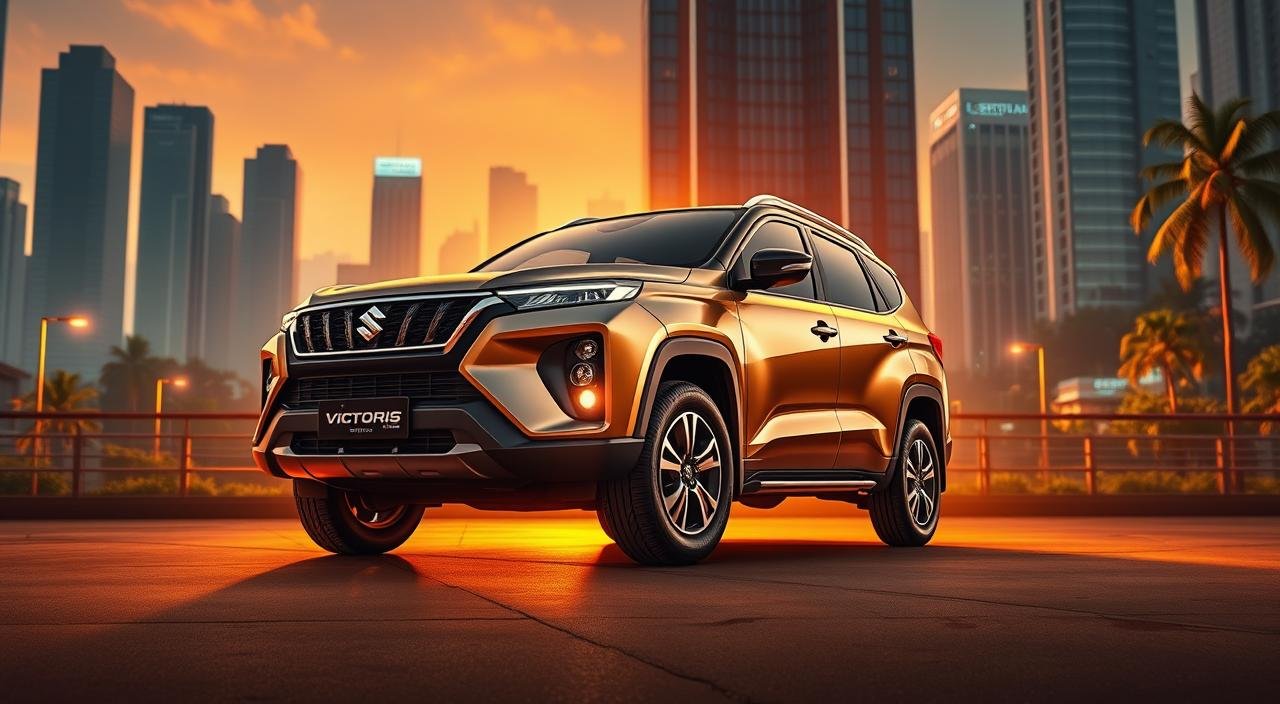
Oct
Can a new SUV priced lower than its sibling deliver more value? The Maruti Suzuki Victoris SUV aims to shake up the Indian compact SUV market. It promises to do so with a bold approach.
The flagship Arena SUV starts at Rs. 10.50 lakh for petrol variants. CNG models cost Rs. 11.50 lakh, and strong hybrid versions are Rs. 16.37 lakh. It’s built on the same platform as the Grand Vitara. This makes it more premium but cheaper than its Nexa counterpart.
The Victoris challenges top players like Hyundai Creta and Kia Seltos. It also faces off against Skoda Kushaq, Volkswagen Taigun, MG Astor, and Honda Elevate. It’s positioned above the Brezza in the Arena lineup, making it a bridge between sub-four-meter SUVs and the Nexa-exclusive Grand Vitara.
Safety is a key focus with 5-star ratings from BNCAP and GNCAP crash tests. This SUV introduces Level 2 ADAS technology for Maruti. Buyers can choose from mild hybrid, strong hybrid, and CNG variants. Each option aims to meet different needs in the Indian market while keeping prices competitive.
Key Takeaways
- Starting price of Rs. 10.50 lakh positions the Victoris competitively against established rivals
- First Maruti model equipped with Level 2 ADAS technology for enhanced safety
- 5-star safety ratings from both BNCAP and GNCAP crash tests
- Multiple powertrain options include mild hybrid, strong hybrid, and CNG variants
- Shares platform with Grand Vitara while providing more premium features at lower prices
- Targets segment leaders like Hyundai Creta and Kia Seltos in the compact SUV space
Introduction to the Maruti Suzuki Victoris
The Maruti Suzuki Victoris is a new addition to the Arena lineup. It offers premium features at affordable prices. Built on the Grand Vitara platform, it aims to meet the needs of families who want space, comfort, and technology without spending too much.
Overview of the SUV’s Concept
The Victoris is the top model in the Arena lineup. It’s designed to challenge Korean SUVs like the Hyundai Creta and Kia Seltos. Even though it’s based on the Grand Vitara platform, it has its own special features.
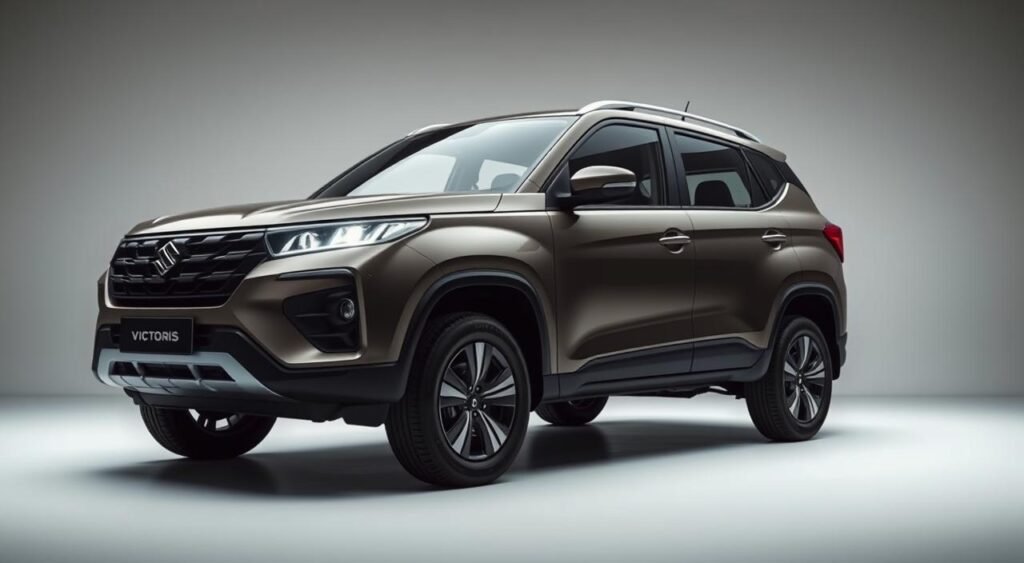
- Width: 1,795mm for stable road presence
- Wheelbase: 2,600mm creating generous interior space
- Full-digital instrument cluster
- 360-degree camera system
- Panoramic sunroof
Key Goals for the Victoris
Maruti had specific goals for the Victoris. They aimed to include premium features in an affordable package. The Victoris comes with features like powered driver seats and a gesture-controlled tailgate, making it a great value for Indian families.
Stylish Exterior Design
The Maruti Suzuki Victoris offers a fresh take on SUV styling. Its estate-wagon look stands out in a crowded market. The design shows off the vehicle’s character and capability.
Design Philosophy and Inspiration
The Victoris has a premium design that’s both elegant and bold. Its front fascia is clean, with sharp DRLs that run along the bonnet. This design is sophisticated and appeals to modern buyers.

The side profile shows off the estate character with its large glasshouse and squared-off wheel arches. The Victoris has a commanding presence on the road. Its clean lines and 17-inch alloy wheels add to its performance look.
Color Options and Customizations
There are seven striking color options for the Victoris:
- Eternal Blue – available in monotone and dual-tone
- Sizzling Red – available in monotone and dual-tone
- Mystic Green – monotone only
- Blueish Black – monotone only
- Magma Grey – monotone only
- Splendid Silver – available in monotone and dual-tone
- Arctic White – monotone only
The rear design is sleek, with connected taillamps and a thin light bar. This design is bold yet elegant, fitting the overall look.
Interior Features and Comfort
The Maruti Suzuki Victoris interior is a step up in comfort and tech. It has a dual-tone black and off-white theme for a fancy feel. Silver accents and textured gloss black on the dashboard make it look great.
Strong hybrid models have an all-black interior with gold accents. This gives them a unique look.
Spacious Cabin Design
The cabin is great for both the front and back seats. Front seats are comfy with firm support and side bolstering. The driver gets electric seat adjustment, and both front seats have ventilated options for hot weather.
The rear bench has plenty of space, with a 60:40 split. It has enough knee and legroom and a middle headrest. There are rear AC vents, a center armrest, and a big sunroof for natural light.

Tech-savvy Infotainment System
The infotainment system is centered around a 10.1-inch SmartPlay Pro X touchscreen. It supports OTT apps, video playback, and Alexa AI for voice commands. Mobile tethering and OTA updates keep it up-to-date without needing a dealership visit.
The audio system is impressive, with an eight-speaker Infinity setup by Harman. It offers bass-rich sound with Dolby Atmos support. The 10.25-inch digital instrument cluster and head-up display add to the tech features.
Safety Features
The Victoris comes with six airbags, ABS with EBD, ESP, and traction control. It also has hill hold assist to prevent rolling back on hills. ISOFIX anchors secure child seats well.
The Level 2 ADAS includes lane-keep assist and adaptive cruise control. These features make driving on highways safer.
Engine Performance and Fuel Efficiency
The Maruti Suzuki Victoris offers three powertrain options. Each one balances engine power with great fuel efficiency. This meets the needs of various drivers on Indian roads.
Engine Specifications
The Victoris has a 1.5-liter K15C petrol engine. It makes 103PS and 139Nm of torque. You can pick from a 5-speed manual or a 6-speed automatic transmission.
The petrol model gets 21.18 kmpl with manual and 21.06 kmpl with automatic.
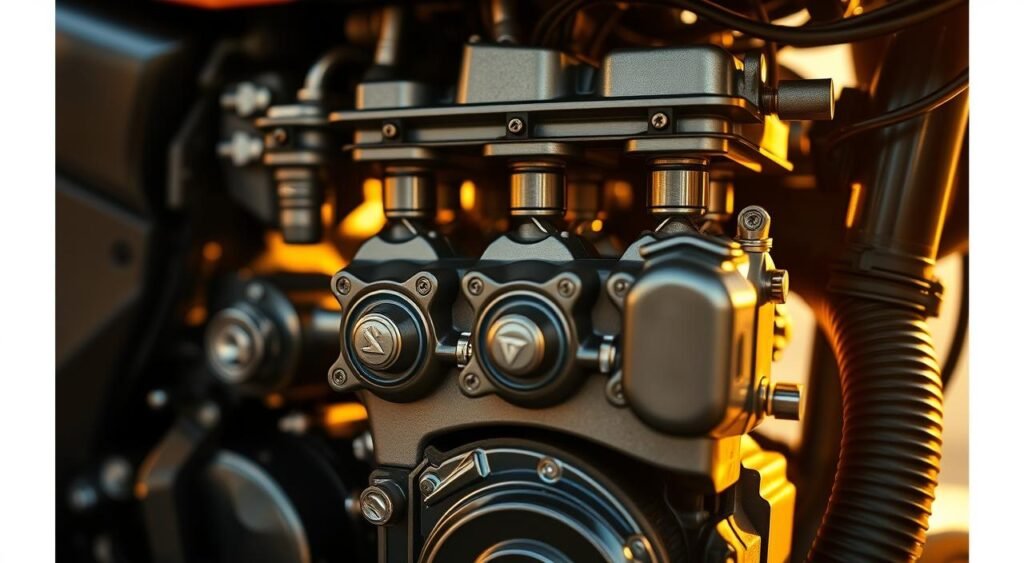
The CNG version has 87.8PS on CNG and 100PS on petrol. The hybrid model has 116PS combined output and 141Nm torque. It comes with an eCVT transmission.
This hybrid gets 28.65 kmpl. The CNG version gets 27.02 km/kg.
Driving Experience and Handling
The petrol engine is smooth at low speeds. It gets more powerful in second and third gears. On highways, it feels confident but gets a bit rough when accelerating hard.
The six-speed automatic transmission shifts smoothly. Sport mode makes it respond quicker.
All variants impress with real-world fuel efficiency. City driving gets 12-13 kmpl for petrol and over 20 kmpl for hybrids. On highways, petrol gets 17-18 kmpl, and hybrids get 24-25 kmpl.
The hybrid runs silently in EV mode in cities. Its self-charging system means no range anxiety.
Off-road Capabilities
The Maruti Suzuki Victoris impresses with its off-road skills. It’s built with advanced tech and engineering. This SUV can handle tough terrains with ease.

Terrain Management System
The AllGrip AWD system is available with the 6-speed automatic petrol. It offers a fuel economy of 19.07 kmpl. This system ensures the best grip on different surfaces.
The Victoris excels on off-road courses. It moves smoothly over sand, gravel, and mud. The four-wheel disc brakes help stop safely and confidently.
Ground Clearance and Suspension
The Victoris has 210mm of ground clearance. This keeps it safe from rocks and rough paths. Its suspension is great on highways and smooth on bumpy roads.
| Feature | Specification | Benefit |
|---|---|---|
| Ground Clearance | 210mm | Adequate protection on rough terrain |
| Wheel Size | 17 inches | Balance between style and comfort |
| Brake Type | 4-wheel disc | Superior stopping power |
| Fuel Economy (AWD) | 19.07 kmpl | Efficient despite capability |
The Victoris handles twisty roads well. Its 17-inch wheels look good and feel comfortable. Wider tires could improve grip for those who love extreme off-roading.
Comparison with Competitors
The Maruti Suzuki Victoris 2022 enters a crowded SUV market. It faces tough competition from the Hyundai Creta and Kia Seltos. This analysis shows how Maruti positions the Victoris to stand out.
How the Victoris Stands Out
The Victoris has features that its rivals don’t. It’s the only SUV in its segment with factory-fitted CNG and full boot space. Its hybrid variant offers great fuel efficiency without losing performance.
Maruti’s wide service network in India gives it an advantage. The Victoris is available in more places than its competitors. It also has a top-notch ADAS suite at an affordable price.
Price Point Analysis
The Victoris starts at Rs. 10.50 lakh, making it cheaper than many rivals. Its top hybrid variant at Rs. 19.98 lakh is also a good deal.
| Model | Starting Price | Top Variant Price |
|---|---|---|
| Maruti Suzuki Victoris | Rs. 10.50 lakh | Rs. 19.98 lakh |
| Hyundai Creta | Rs. 11.00 lakh | Rs. 20.15 lakh |
| Kia Seltos | Rs. 10.90 lakh | Rs. 20.30 lakh |
The Victoris doesn’t have diesel or turbo-petrol options. It also doesn’t have a spare wheel, which might worry some buyers. Yet, it offers great value with its price and wide availability.
Customer Feedback and Reviews
Real-world customer reviews show the Maruti Suzuki Victoris in a new light. It has an average rating of 4.7 out of 5 stars from early owners. People share both good points and areas for improvement of this affordable SUV. Let’s look at what drivers say about their choices.
Highlighting User Experiences
Many owners love the Victoris for its high-end features at a low Maruti Suzuki Victoris price. The CNG version gets great fuel mileage, from 23 to 27 kilometers per kilogram. Families like the push-button start in the base models.
The cooling system works well in India’s hot summers. The sound system is also a hit for its quality at this price.
Common Praises and Criticisms
Owners often talk about the same things:
| Positive Feedback | Areas for Improvement |
|---|---|
| Striking exterior design | Engine noise at high speeds |
| Comfortable driving position | Average headlamp brightness |
| Low maintenance costs | Basic infotainment system |
| Value for money features | Light upholstery needs care |
| Excellent fuel efficiency | Road noise intrusion |
Some find the driving not exciting, but many see it as reliable and affordable. The Victoris is seen as a smart choice for families looking for value and dependability.
Maruti Suzuki’s Commitment to Sustainability
The Maruti Suzuki Victoris Review shows a strong focus on the environment. The company uses eco-friendly technologies to make driving green easy for Indian buyers. This doesn’t mean they sacrifice performance or affordability.
Eco-friendly Manufacturing Practices
Maruti Suzuki’s factories are very careful about the environment. They use methods to reduce waste and control emissions better than most. Each Victoris meets strict emission standards, showing the company’s commitment to being green.
Future of Electric and Hybrid Options
The Victoris introduces new hybrid technology with three green options. The strong hybrid model gets up to 28.65 kmpl, thanks to its self-charging battery. The CNG version gets 27.02 km/kg, with a safe, factory-installed system.
Even the mild hybrid petrol models have start-stop and regenerative braking. This boosts their fuel efficiency.
| Powertrain Type | Fuel Efficiency | Key Technology |
|---|---|---|
| Strong Hybrid | 28.65 kmpl | Self-charging battery system |
| CNG | 27.02 km/kg | Factory-fitted dual fuel system |
| Mild Hybrid Petrol | 22.89 kmpl | Start-stop with regenerative braking |
Maruti Suzuki aims to grow its hybrid offerings and look into full-electric cars. This move helps meet India’s emission goals. It also makes green driving more affordable than high-end electric cars.
Final Thoughts on the Maruti Suzuki Victoris
The Maruti Suzuki Victoris SUV is a big step for the brand in the SUV market. It has a practical design and modern features that Indian families love. The Victoris has different engine options, a big cabin with new features, and a price that’s easy on the wallet.
It also has a 5-star safety rating and engines that save on fuel. This makes it a great choice for those who care about safety and want to save money on gas.
Summary of Key Takeaways
The Victoris stands out in many ways that SUV buyers look for. Its interior is packed with advanced tech and comfort features, all at a great price. It rides smoothly over Indian roads, balancing comfort with stability.
It gets a 7.9 out of 10 rating, showing it’s a solid choice despite some small issues. The interior might need cleaning often, and there’s no diesel engine. If you’re looking for fast acceleration, the Victoris might not be for you.
Is the Victoris Worth Your Investment?
If you’re looking for a reliable SUV with lots of features at a good price, the Victoris is worth it. It fills a gap left by the Grand Vitara, competing well with Korean rivals like Hyundai Creta and Kia Seltos. Its looks, usability, and Maruti Suzuki’s service network make it a great choice.
Some might miss the lack of a spare wheel and diesel engine. But the Victoris is one of Maruti’s best offerings in years. It’s perfect for those who value brand reputation, fuel efficiency, and practicality over speed.
FAQ
What is the price range of the Maruti Suzuki Victoris?
The Maruti Suzuki Victoris starts at Rs. 10.50 lakh for the base model. The CNG variants cost Rs. 11.50 lakh. The top hybrid model is priced at Rs. 19.98 lakh. This makes it a good deal compared to the Hyundai Creta and Kia Seltos.
What are the engine options and specifications available?
The Victoris comes with three engine options. A 1.5-liter K15C petrol engine makes 103PS/139Nm. It has 5MT/6AT transmissions. There’s also a 1.5-liter petrol+CNG variant and a strong hybrid system.
The hybrid system produces 116PS combined output. An AllGrip AWD system is available with the 6AT petrol variant.
What are the standout features of the Victoris interior?
The interior of the Maruti Suzuki Victoris is premium. It has a powered driver seat and ventilated front seats. There’s also a 10.1-inch SmartPlay Pro X touchscreen and a 10.25-inch digital instrument cluster.
Other features include a heads-up display, 360-degree camera, and wireless charger. It has a panoramic sunroof and gesture-controlled powered tailgate. The sound system is an eight-speaker Infinity system with Dolby Atmos support.
How does the Victoris perform in terms of fuel efficiency?
The Victoris is fuel-efficient. The strong hybrid variant gets 28.65kmpl. The CNG variant gets 27.02km/kg. Petrol variants get 21.18kmpl (manual) and 21.06kmpl (automatic).
In real-world city driving, petrol variants get 12-13kmpl. Hybrid variants get over 20kmpl.
What safety features does the Victoris offer?
The Victoris has many safety features. It comes with 6 airbags as standard. It also has a Level 2 ADAS suite, adaptive cruise control, and lane-keep assist.
It has ABS with EBD, ESP, traction control, and hill hold assist. There are ISOFIX anchors and TPMS. The SUV has 5-star safety ratings from BNCAP and GNCAP crash tests.
When is the Maruti Suzuki Victoris launch date?
The Maruti Suzuki Victoris has already been launched. It is Arena’s flagship model. Its market introduction in 2022 makes it a premium option in the compact SUV segment.
How does the Victoris compare to the Grand Vitara?
The Victoris and Grand Vitara share a platform and dimensions. But the Victoris is more premium and costs less. It’s designed to offer better value in Arena space, not as a replacement.
What do customer reviews say about the Victoris?
Early owners give the Victoris a 4.7/5 rating. They love its looks, comfortable drive, affordable maintenance, and fuel economy. Some say the engine noise is high at high speeds, and the headlamps are not bright enough.
But the base variant is a hit with middle-class families. They call it the “Base Model King”.
Is the Victoris suitable for off-road driving?
Yes, the Victoris is good for off-road driving. It has 210mm ground clearance and an AllGrip AWD system. It handles off-road well, but sometimes lacks torque.
The suspension is stable on rough terrain and twisty roads.
What are the main competitors of the Maruti Suzuki Victoris?
The Victoris competes with the Hyundai Creta, Kia Seltos, Skoda Kushaq, Volkswagen Taigun, MG Astor, and Honda Elevate. It has Maruti’s wide service network, proven reliability, and unique CNG option.
It also has a strong hybrid variant and advanced ADAS at a good price. But it doesn’t have diesel or turbo-petrol options like some rivals.

Oct
What new cars hit the Indian market in September 2025? This month was big for car buyers. Many car makers brought out new models at different prices.
The new cars in September 2025 offered something for everyone. The Volvo EX30 electric SUV was priced at Rs. 39.99 Lakh. On the other end, the Citroen Basalt X started at just Rs. 7.95 Lakh. Maruti Suzuki introduced the Victoris at Rs. 10.50 Lakh. VinFast also made its debut with the VF 6 and VF 7.
These new cars are just the start of a big change in India’s car market. By 2026, 68 new cars will hit the roads, including 50 SUVs. Each car comes with new features and tech to meet what buyers want.
Key Takeaways
- Volvo EX30 electric SUV launched on September 23, 2025, priced at Rs. 39.99 Lakh
- Maruti Suzuki Victoris debuted on September 15, 2025, at Rs. 10.50 Lakh
- VinFast entered India with VF 6 (Rs. 16.49 Lakh) and VF 7 (Rs. 20.89 Lakh) models
- Citroen Basalt X launched as the most affordable option at Rs. 7.95 Lakh
- 68 new vehicles scheduled for 2025-2026, with SUVs dominating at 50 models
- September launches covered all segments from budget to luxury vehicles
Overview of September 2025 Car Launches
September 2025 was a big month for cars in India. Car makers brought out a wide range of vehicles. Prices started at Rs. 7.95 Lakh for the Citroen Basalt X and went up to Rs. 39.99 Lakh for the Volvo EX30. This shows how the market is changing to meet different needs and budgets.

Significance of New Launches
The new cars in September highlight a big move towards electric and SUVs. *Volvo’s entry into the premium EV segment* shows a push for green transport. With 16 new models coming in the next three months, the industry is feeling optimistic about India’s growth.
For those watching their wallets, there’s the Citroen Basalt X. And for those looking for luxury, there’s the Volvo. This variety means there’s something for everyone, no matter their budget.
Key Trends in the Automotive Market
SUVs are all the rage, with 50 models on the way. Electric cars are also getting more attention, thanks to eco-friendly goals and government rules. Prices range from Rs. 7.95 Lakh to Rs. 39.99 Lakh, showing a smart strategy to reach various customers. These updates show the industry is ready to meet new demands and prepare for the future.
Major Brands and Their Releases
The upcoming cars in September 2025 show a big fight among India’s top car makers. Each brand has something special for everyone, from those on a tight budget to those wanting the best. The latest cars highlight the need for good prices, new tech, and more choices.
Tata Motors: Innovations and Updates
Tata Motors is growing fast with four big new cars. The Tata Sierra is back as a modern SUV, priced between Rs. 15-25 Lakh. It’s perfect for those who love adventure.
The Harrier and Safari get big updates. The Harrier costs between Rs. 14-25.25 Lakh, and the Safari from Rs. 14.66-25.96 Lakh. The Punch 2025 starts at just Rs. 6 Lakh, making it very affordable.
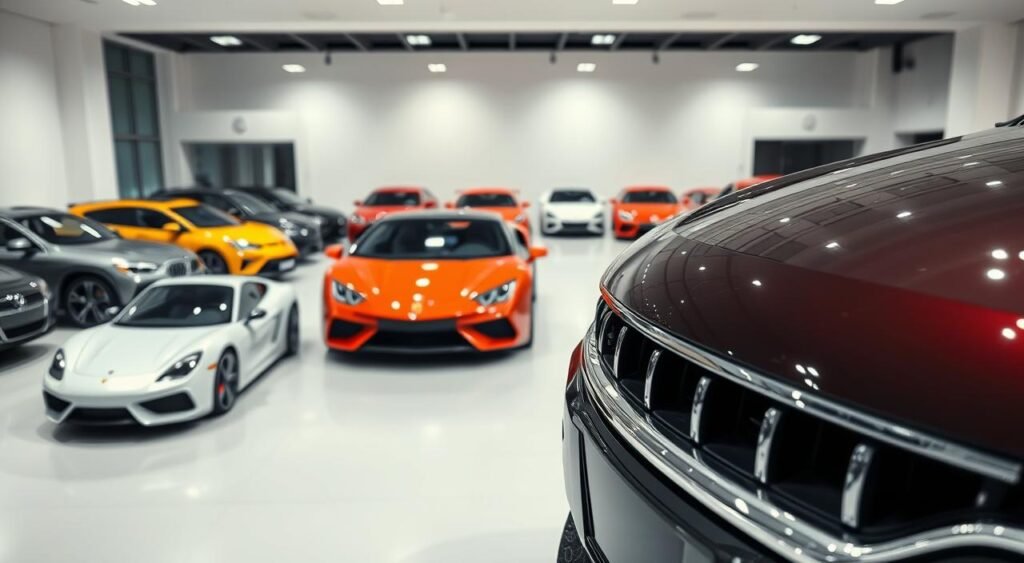
Hyundai: Exciting New Models
Hyundai is bringing a variety of cars in September. The Venue 2025 starts at Rs. 8 Lakh, aiming for the compact SUV market. The Tucson 2025, priced at Rs. 30 Lakh, offers high-end features.
The Palisade, priced between Rs. 40-50 Lakh, shows Hyundai’s move into luxury. It’s a big step for the brand.
Maruti Suzuki: The Affordable Option
Maruti Suzuki is getting stronger with the Victoris at Rs. 10.50 Lakh. They also have the updated Brezza 2025 at Rs. 8.50 Lakh and the Grand Vitara at Rs. 14 Lakh. The e Vitara is their first electric car, priced between Rs. 17-22.50 Lakh.
Electric Vehicles Introduced in September 2025
The electric vehicle segment was a big hit in September 2025. India saw many new EVs, from affordable models to luxury ones. This shows more people want green cars in India.
Leading EVs in the Lineup
Volvo’s EX30 electric was a highlight, priced at Rs. 39.99 Lakh. It shows the push for high-end electric cars. There are also cheaper options like the Leapmotor T03 at Rs. 8 Lakh and the Maruti WagonR Electric at Rs. 8.50 Lakh. These make electric cars more affordable for everyone.
| Electric Vehicle Model | Price Range (Rs.) | Market Segment |
|---|---|---|
| Leapmotor T03 | 8 Lakh | Budget |
| Maruti WagonR Electric | 8.50 Lakh | Budget |
| Mahindra XEV 4e | 13 Lakh | Compact |
| Maruti e Vitara | 17-22.50 Lakh | Mid-Range SUV |
| MG 4 EV | 30 Lakh | Premium |
| Tesla Model 3 | 60 Lakh | Luxury |
| BMW iX 2025 | 1.45 Crore | Ultra-Luxury |
Government Initiatives for EV Adoption
The Indian government is helping by giving FAME-II subsidies and lowering GST rates. States also offer perks like free registration and special parking. These moves make electric cars more appealing to all buyers.
Compact Cars: A Growing Segment
The compact car segment is booming in India. Many new cars are coming out, aiming at budget-friendly buyers. These cars are great for city driving, saving money, and using less fuel.
They offer a perfect mix of space, features, and price. This makes them ideal for Indian roads and parking spots.
Best Compact Cars Launched
Citroen introduced the Basalt X for Rs. 7.95 Lakh on September 5, 2025. Its price makes it a great choice for new buyers. The Maruti Swift is also popular, priced from Rs. 5.79 to 8.80 Lakh. It’s known for its reliability and wide service network.
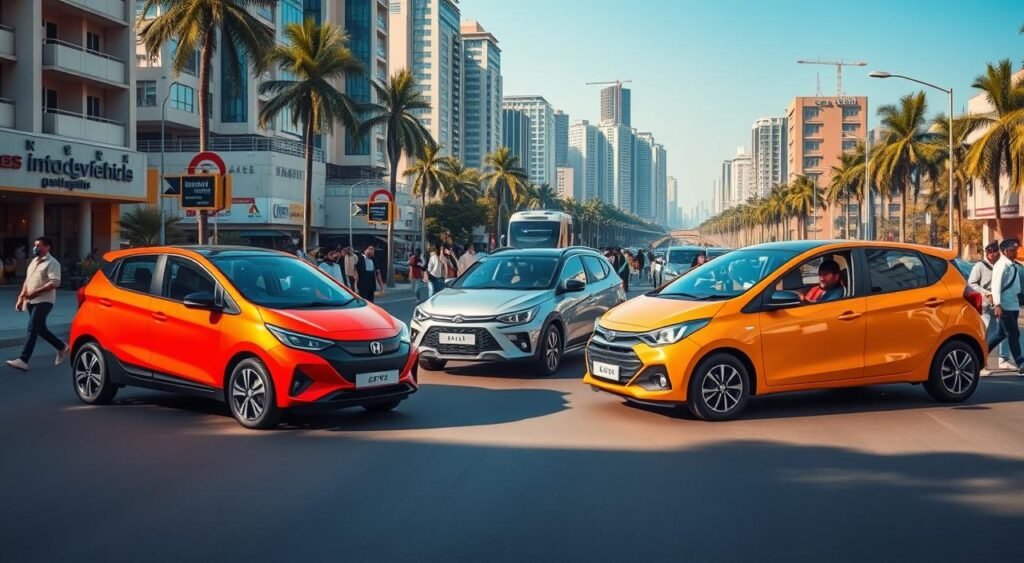
Several new models are expected to change the compact car scene. The Tata Punch 2025 facelift will cost around Rs. 6 Lakh. Volkswagen’s Tera will start at Rs. 8 Lakh. VinFast’s VF 3 will be priced between Rs. 7.50 and 10 Lakh. Honda’s WR-V is expected to cost between Rs. 9 and 12 Lakh.
Consumer Preferences and Trends
People looking for compact cars want good value, fuel efficiency, and low upkeep. Renault answered with new KWID models priced from Rs. 4.30 to 5.90 Lakh. The upcoming Maruti Baleno 2026 and MG 4 EV show a shift towards electric cars. They keep the compact size but add modern tech features.
SUVs and Crossovers: Dominating the Market
The SUV segment is leading the way on Indian roads with exciting new launches in 2025. September saw big unveilings from both well-known brands and new players. These launches set new benchmarks for design and performance.
The latest car models in India show a growing need for versatile vehicles. They must offer family comfort and be ready for adventure.
Popular SUV Models Unveiled
VinFast introduced their VF 6 and VF 7 electric SUVs, priced at Rs. 16.49 Lakh and Rs. 20.89 Lakh. The Mahindra Thar arrived in October, starting at Rs. 9.99 Lakh. It’s a hit with off-road fans across the country.
More exciting launches are on the horizon. We can expect:
- Hyundai Palisade – Rs. 40-50 Lakh
- Maruti Brezza 2025 – Rs. 8.50 Lakh
- Tata Sierra – Rs. 15-25 Lakh
- Volkswagen Tayron – Rs. 50 Lakh
- Renault New Duster – Rs. 12-20 Lakh
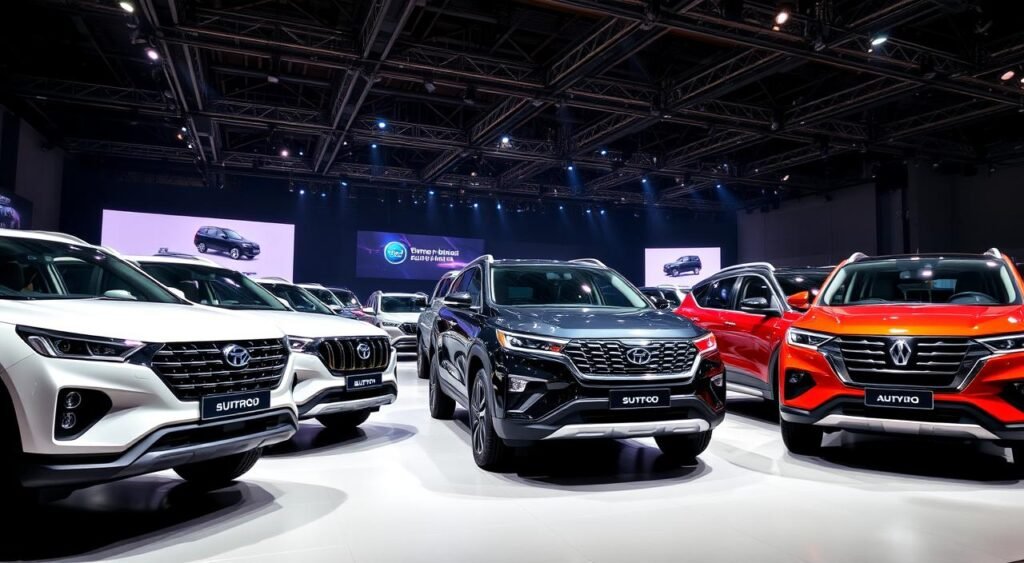
Features That Attract Buyers
Today’s SUV buyers look for advanced safety systems, roomy interiors, and good fuel economy. The latest models offer ADAS technology, panoramic sunroofs, and connected car features. They also have three-row seating options from Toyota and Maruti Grand Vitara for families.
Premium options like the MG Majestor at Rs. 46 Lakh add luxury to the segment. By 2026, nearly 50 SUVs will hit the market. Each will bring its own mix of tech, comfort, and value to Indian buyers.
Luxury Vehicles: Premium Offerings
September 2025 is a big month for luxury car buyers in India. The luxury car segment welcomes new models. These cars combine the latest technology with top-notch craftsmanship.
High-End Brands and Their New Arrivals
*Volvo* starts with the EX30, a premium electric vehicle, launched on September 23, 2025, at Rs. 39.99 Lakh. It brings Scandinavian design to India. Mercedes-Benz also makes a splash with the AMG CLE, priced at Rs. 1.28 Crore.
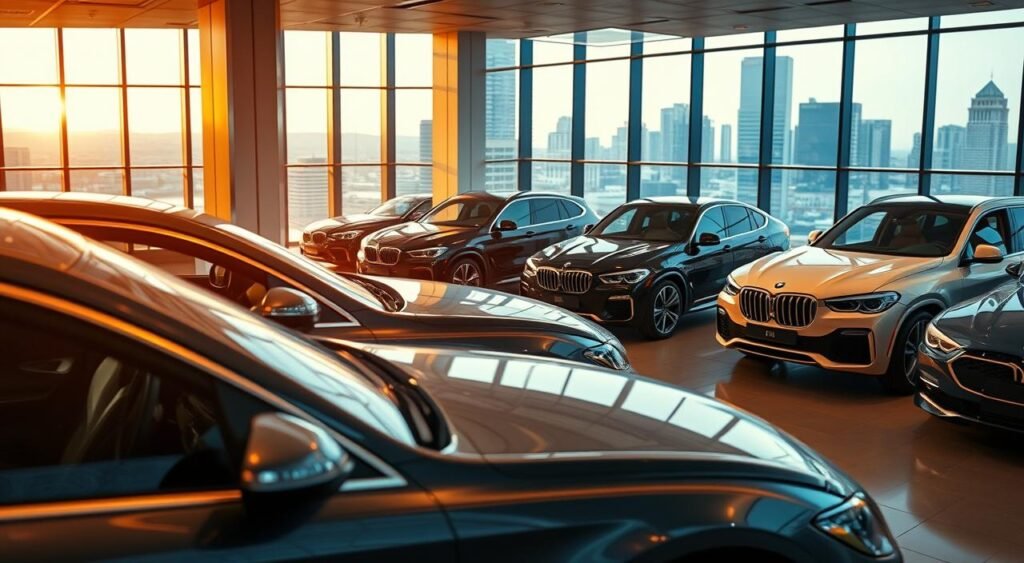
More excitement is coming. BMW is set to introduce the iX 2025 at Rs. 1.45 Crore. Audi will launch two models: the Q6 e-tron at Rs. 1 Crore and the A5 at Rs. 50 Lakh. Skoda is targeting the premium sports sedan market with the Octavia RS, expected between Rs. 45-55 Lakh.
Unique Selling Points of Luxury Cars
These premium vehicles stand out for several reasons:
- Advanced autonomous driving capabilities
- Sustainable luxury with electric powertrains
- Personalized digital cockpits
- Handcrafted interiors using premium materials
- Exclusive ownership experiences and services
Ferrari introduces the 12Cilindri coupe, while Maserati brings the MCPura at Rs. 5.12 Crore. These updates show a focus on performance and environmental care.
Technology and Features in New Cars
September 2025 is a big moment for the India car market. Cars now come with the latest tech, from electric power to smart connectivity. The newest models mix safety with fun tech, pleasing tech lovers at all price points.
Advanced Safety Features
New cars focus on safety first. The BMW iX 2025 has Level 2 driving, helping with steering and speed. Tesla Model 3 brings Autopilot to Indian roads, making driving easier in traffic.
The Maruti e Vitara offers six airbags and stability control for less money. Volvo EX30 keeps up its safety promise with a top-notch collision system. These features show India’s push for safer cars for everyone.
Infotainment and Connectivity Options
Digital cockpits are changing how we drive. Mercedes-Benz CLA Electric has a top-notch MBUX system, understanding Hindi and English voice commands. Hyundai IONIQ 6 has two big screens and supports Apple CarPlay and Android Auto without wires.
The Audi Q6 e-tron shows off with a virtual cockpit and real-time charging station info. These features highlight India’s move toward cars that connect well with phones and homes.
Pricing Trends and Market Analysis
The car market in September 2025 saw a variety of prices for new cars. Prices ranged from affordable compact cars to high-end luxury vehicles. This shows how the Indian car market is changing and what buyers want.
Comparison of Launch Prices
New cars in September 2025 offer a wide price range for different buyers. The cheapest models are priced to be affordable, while the most expensive ones are in the luxury category.
| Car Model | Segment | Price (Rs. Lakh) |
|---|---|---|
| Tata Punch 2025 | Budget | 6.00 |
| Citroen Basalt X | Compact | 7.95 |
| Volkswagen Tera | Budget | 8.00 |
| Leapmotor T03 | Electric Budget | 8.00 |
| Maruti Victoris | Mid-Segment | 10.50 |
| VinFast VF 6 | Electric SUV | 16.49 |
| VinFast VF 7 | Electric SUV | 20.89 |
| Volvo EX30 | Luxury Electric | 39.99 |
| Audi Q6 e-tron | Premium Electric | 100.00 |
| BMW iX 2025 | Ultra-Luxury | 145.00 |
Economic Factors Influencing Pricing
Many economic factors affect the prices of new cars in September 2025. Rising raw material costs and changes in the supply chain increase production costs. Electric cars range from Rs. 8 Lakh to Rs. 65 Lakh, showing how manufacturers aim for different price points. Government support for electric vehicles also plays a big role in setting prices. Changes in currency value impact the cost of imported parts, affecting high-end brands like BMW and Audi.
Customer Reactions and Reviews
The latest car releases in September 2025 have started big talks in car forums and dealerships everywhere. People are sharing their thoughts on new cars, helping others make up their minds. This feedback is key for millions of people thinking about buying a car.
Feedback on Latest Models
The Mahindra Thar’s launch in October at Rs. 9.99-16.99 Lakh caught everyone’s attention. Early buyers loved its tough look and how well it handles off-road. The Maruti Victoris, launched on September 15 at Rs. 10.50 Lakh, got good feedback for its gas mileage and roomy inside.
VinFast’s arrival in India with the VF 6 and VF 7 models made a big splash. People liked the brand’s good prices and cool features. The Volvo EX30 electric car, priced at Rs. 39.99 Lakh, drew in fans of eco-friendly luxury cars.
The Role of Social Media in Reviews
Instagram and YouTube channels focused on cars got a lot of attention in September 2025. Videos about the Maruti Swift (Rs. 5.79-8.80 Lakh) and Tata Nexon (Rs. 7.32-14.05 Lakh) were watched by millions. Twitter talks about the Tata Punch (Rs. 5.50-9.30 Lakh) and Maruti FRONX (Rs. 6.85-11.98 Lakh) helped shape buying choices in big cities.
Online groups are now very important in forming opinions about new cars. Quick feedback on social media helps car makers fix problems and make customers happier.
Conclusion: What’s Next for the Indian Automotive Market?
The Indian car market is on the verge of a big change. By 2026, 68 new models will hit the roads. SUVs will lead with 50 models, while sedans, hatchbacks, and electric vehicles will also be available.
September 2025 will see a wide range of cars. Prices will start at Rs. 6 Lakh for the Tata Punch 2025. The Maserati MCPura will be at the high end, priced at Rs. 5.12 Crore.
Future Predictions
The next 18 months will bring many new cars to India. Mahindra will launch the new Bolero in March 2026. Hyundai will introduce the New Venue in November 2025 and the Palisade in March 2026.
Electric cars will become more common, with over 12 models debuting. This includes the Tesla Model 3 and Maruti WagonR Electric. There will also be specialized vehicles like the Mahindra Global Pik Up and Nissan Compact MPV.
Implications for Consumers and Manufacturers
Car buyers in India will have more choices than ever. The September 2025 list shows a wide range of options. Manufacturers must balance price and innovation to meet customer needs.
The move towards electric vehicles and SUVs marks a new era. Companies must quickly adapt to these changes. They also need to keep prices affordable in the Indian market.
FAQ
Which cars were launched in India in September 2025?
In September 2025, India saw five big car launches. The Volvo EX30 electric SUV was launched on September 23 at Rs. 39.99 Lakh. The Maruti Suzuki Victoris was launched on September 15 at Rs. 10.50 Lakh. VinFast VF 6 and VF 7 SUVs were launched on September 6 at Rs. 16.49 Lakh and Rs. 20.89 Lakh respectively. The Citroen Basalt X was launched on September 5 starting at Rs. 7.95 Lakh.
What are the price ranges for new car launches in September 2025?
The new car launches in September 2025 offered a wide range of prices. The Citroen Basalt X started at Rs. 7.95 Lakh. The Volvo EX30 electric SUV was priced at Rs. 39.99 Lakh. The Maruti Suzuki Victoris was priced at Rs. 10.50 Lakh. The VinFast models were priced at Rs. 16.49-20.89 Lakh.
Which electric vehicles are coming to India in 2025-2026?
Over 12 electric vehicles are coming to India. The BMW iX 2025 will cost Rs. 1.45 Crore. The Audi Q6 e-tron will cost Rs. 1 Crore. The Maruti e Vitara will cost between Rs. 17-22.50 Lakh. The Mercedes-Benz CLA Electric will cost Rs. 65 Lakh. The MG 4 EV will cost Rs. 30 Lakh. The Tesla Model 3 will cost Rs. 60 Lakh. The Mahindra BE 07 will cost Rs. 29 Lakh. The Maruti WagonR Electric will cost Rs. 8.50 Lakh. The Leapmotor T03 will cost Rs. 8 Lakh.
How many upcoming cars are scheduled for launch in India?
India has 68 upcoming cars scheduled for 2025-2026. This includes 50 SUVs, 9 sedans, 4 hatchbacks, 2 coupes, 1 pickup truck, 1 MUV, and 1 luxury vehicle.
What are the top car releases expected in September 2025 and beyond?
Some key releases include the Maruti Brezza 2025 at Rs. 8.50 Lakh. The Hyundai Venue 2025 will cost Rs. 8 Lakh. The Tata Sierra will cost between Rs. 15-25 Lakh. The Hyundai Palisade will cost between Rs. 40-50 Lakh. The Maruti Grand Vitara 3-row will cost Rs. 14 Lakh. The Volkswagen Tayron will cost Rs. 50 Lakh. The Mahindra XUV700 Facelift will cost Rs. 15 Lakh.
Which budget cars under Rs. 10 Lakh are launching soon?
Soon, we’ll see budget-friendly cars like the Tata Punch 2025 facelift at Rs. 6 Lakh. The Volkswagen Tera will cost Rs. 8 Lakh. The VinFast VF 3 will cost between Rs. 7.50-10 Lakh. The Leapmotor T03 electric will cost Rs. 8 Lakh. The Maruti WagonR Electric will cost Rs. 8.50 Lakh. The Hyundai Venue 2025 will cost Rs. 8 Lakh.
What luxury cars are coming to the Indian market?
Luxury cars include the BMW iX 2025 at Rs. 1.45 Crore. The Audi Q6 e-tron will cost Rs. 1 Crore. The Skoda Octavia RS will cost between Rs. 45-55 Lakh. The Audi A5 will cost Rs. 50 Lakh. The Skoda Superb 2025 will cost Rs. 50 Lakh. The Mercedes-Benz CLA Electric will cost Rs. 65 Lakh. The Ferrari 12Cilindri coupe and Maserati MCPura will be launched on October 4, 2025, at Rs. 5.12 Crore.
What are the latest car models featuring advanced technology?
New models include the BMW iX 2025 with autonomous driving. The Tesla Model 3 has Autopilot. The Mercedes-Benz CLA Electric has the MBUX infotainment system. The Audi Q6 e-tron has quattro electric all-wheel drive. Many models feature ADAS technology and connected car features.
Which SUVs are dominating the Indian car market trends?
SUVs are leading the market with 50 models in the pipeline. The Mahindra Thar was launched on October 3, 2025, at Rs. 9.99-16.99 Lakh. The Tata Sierra, Maruti Grand Vitara 3-row, Hyundai Tucson 2025, MG Majestor, Toyota 3-Row SUV, Nissan New Compact SUV, and Renault New Duster are also expected.
What are the automobile industry updates for compact cars?
The compact segment is active with the Citroen Basalt X launched at Rs. 7.95 Lakh. Upcoming models include the Tata Punch 2025 and Honda WR-V at Rs. 9-12 Lakh. There are also 4 new hatchbacks, including the Maruti Baleno 2026. The Renault KWID has new variants at Rs. 4.30-5.90 Lakh. The Maruti Swift remains popular at Rs. 5.79-8.80 Lakh.

Oct
Can a cheaper electric vehicle really go as far as its pricier sibling? The Indian EV market is curious about this. Mahindra has launched two electric SUVs with similar features.
The Mahindra XEV9E vs BE6 range test shows surprising results. The XEV9E starts at Rs 21.90 lakh, while the BE6 is priced at Rs 18.90 lakh. Both promise ranges of 542-683 kilometers, as certified by ARAI.
This comparison looks at how these EVs perform in real life, not just in labs. The XEV9E has 59-79 kWh battery options and can charge up to 180 kW DC fast. The BE6 has the same battery sizes but charges at 140 kW DC. Both can get to 80% charge in 20 minutes.
But how do they do on the road? The XEV9E gets 430-460 kilometers in real driving, users say. This comparison aims to find out which EV offers the best value for Indian buyers looking for practical electric cars.
Key Takeaways
- The BE6 claims slightly higher ARAI range (557-683 km) compared to XEV9E (542-656 km) despite lower price
- Real-world XEV9E range drops to 430-460 km in mixed driving conditions
- Both EVs feature identical battery options from 59 kWh to 79 kWh capacity
- Fast charging reaches 80% in 20 minutes for both models
- XEV9E supports 180 kW DC charging while BE6 manages 140 kW DC
- Price difference of Rs 3 lakh between base variants favors the BE6
Introduction to Electric Vehicle Range Tests
Range testing is key to figuring out how far electric vehicles can go on one charge. It shows how far an EV can travel, giving buyers real-world info. This helps them choose the right car based on electric vehicle performance.
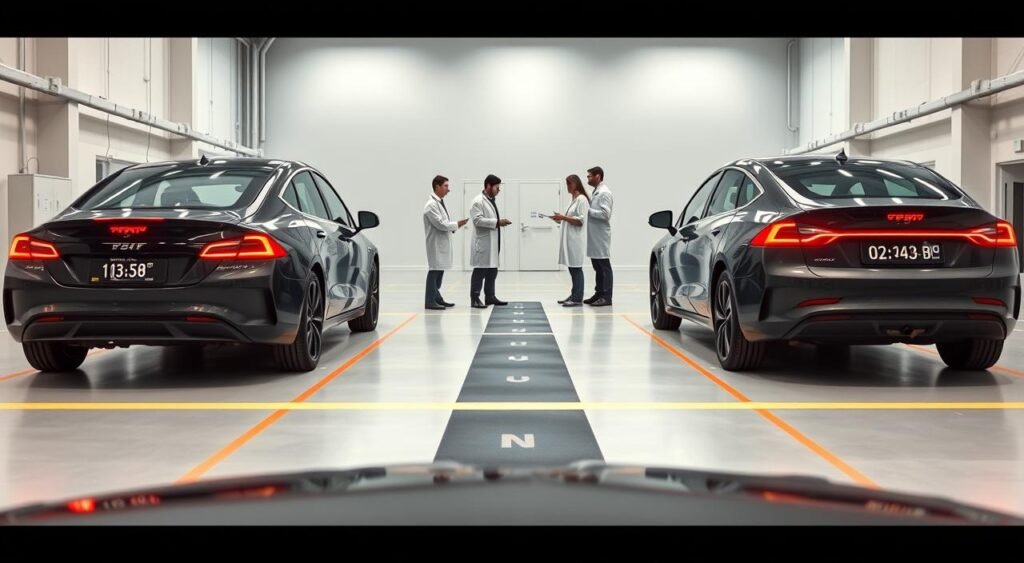
What is Range Testing?
Range testing checks how well an electric vehicle’s battery works. The Automotive Research Association of India (ARAI) does these tests. They follow strict rules to get official range numbers.
But, real-world driving is different from lab tests. Things like traffic, air conditioning, and how you drive affect the range. Most EVs don’t go as far as ARAI says. For example, the Mahindra XEV 9e might go 430 to 460 kilometers, not 542 to 656 as ARAI claims.
Importance of Range in EV Selection
Range anxiety is a big worry for EV buyers in India. It’s important for daily commutes and occasional long trips. An EV efficiency comparison helps find the best car for your needs.
City drivers and those who travel long distances have different needs. Knowing how far an EV can really go helps choose the right car. This way, buyers avoid surprises and find a car that fits their life.
Overview of Mahindra XEV9E
The Mahindra XEV9E is a strong contender in the electric vehicle market. It combines advanced technology with a design that appeals to today’s drivers. This electric SUV is built on Mahindra’s electric platform, showing the brand’s commitment to premium electric mobility in India.
Key Features and Specifications
The XEV9E has impressive technical specs, making it stand out in the market. It has a Permanent Magnet Synchronous Motor that produces 282 horsepower and 380 Newton-meters of torque. It comes with two battery options: 59 kWh for daily use and 79 kWh for longer trips.
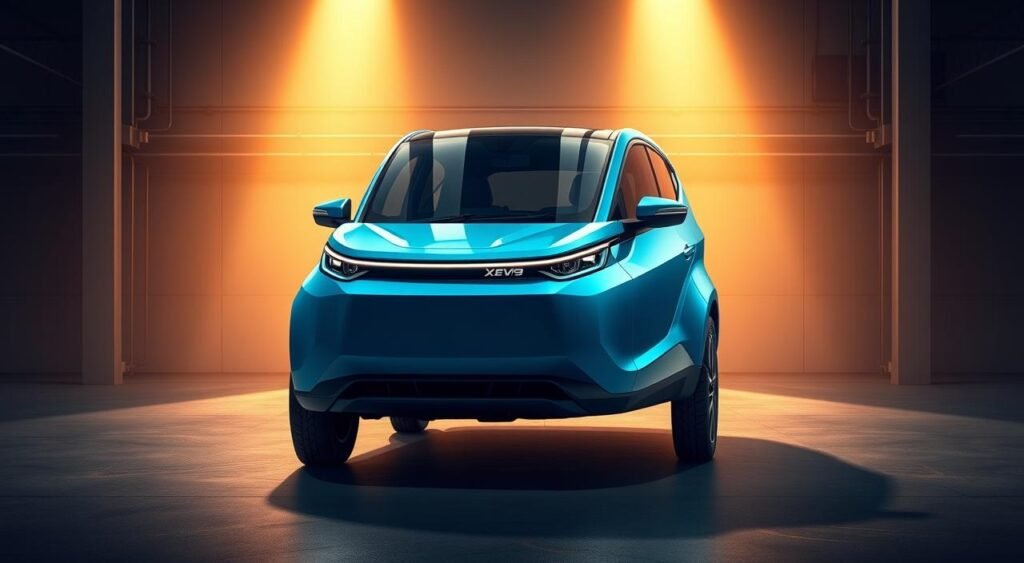
The SUV is 4,789mm long, 1,907mm wide, and 1,694mm tall. It has a 2,775mm wheelbase for spacious interiors and 207mm ground clearance for Indian roads. It has a single-speed automatic transmission and rear-wheel drive for better efficiency.
Design and Comfort
The interior features three 12.3-inch screens for a digital cockpit. It also has a 16-speaker Harman/Kardon audio system with Dolby Atmos. A panoramic glass roof adds natural light, making the interior bright and airy for five people.
| Comfort Features | Details |
|---|---|
| Seating Configuration | 5-seater with ventilated front seats |
| Climate Control | 2-zone automatic temperature management |
| Charging Options | Wireless charging pad for devices |
| Storage Capacity | 663-liter boot space |
Battery and Performance Metrics
The XEV9E has a 5-star BNCAP safety rating. It comes with six airbags, Level 2 ADAS technology, and a 360-degree camera system. These features enhance its performance in real-world driving. The battery management system ensures consistent performance and long battery life.
Overview of BE6
The BE6 is a top choice in the electric vehicle market. It combines great performance with everyday practicality. This compact SUV has impressive specs, making it perfect for those who need reliable range and the latest tech.
It comes with two battery choices and cutting-edge tech. This makes the BE6 ideal for drivers who want both efficiency and fun on their daily drives.
Key Features and Specifications
The BE6 has a Permanent Magnet Synchronous Motor. It produces 228 bhp and 380 Nm of torque. This motor allows the BE6 to go from 0-100 kmph in 6.7 seconds and reach a top speed of 202 kmph.
There are two battery options: 59 kWh and 79 kWh. This gives buyers flexibility based on their driving habits and budget.

Design and Comfort
The BE6 is 4371mm long, 1907mm wide, and 1627mm tall. It has a spacious cabin despite its compact size. The 2775mm wheelbase ensures room for five passengers.
It also has 207mm of ground clearance, perfect for Indian roads. Notable comfort features include a 16-speaker Dolby Atmos sound system, ambient lighting, and ORMS technology. The 455-liter boot is great for carrying stuff on trips.
Battery and Performance Metrics
In the EV range comparison, the BE6 gets between 557-683 km per charge. ARAI testing standards confirm this. It has five drive modes to suit different needs.
Range mode boosts distance, Race mode gives full power, and Everyday mode is for daily use. Snow and Custom modes adjust to specific conditions.
| Battery Option | ARAI Range | Power Output |
|---|---|---|
| 59 kWh | 557 km | 170 kW |
| 79 kWh | 683 km | 170 kW |
Testing Methods for Range
Manufacturers test electric vehicles in labs and real-world settings. The Mahindra XEV9E vs BE6 Range Test shows big differences between official numbers and real driving. Tests range from controlled labs to everyday roads.
Standardized Testing Procedures
The Automotive Research Association of India (ARAI) tests range in labs. They measure energy use under certain conditions. This way, they figure out range based on battery size. It’s done without wind, traffic, or how the driver acts.
ARAI tests give optimistic figures compared to real driving. The XEV9E gets 542-656 km in lab tests, and the BE6 does too. But these tests don’t always match real-world driving.
Real-World Driving Conditions
Real electric vehicle performance is affected by many things labs can’t test. Driving in cities, on highways, and in stop-and-go traffic matters. Weather also affects how far you can go.
| Testing Factor | Impact on Range | XEV9E Real Performance |
|---|---|---|
| Temperature Extremes | 15-25% reduction | 430-460 km achieved |
| Terrain Changes | 10-20% variation | Regenerative braking helps |
| Driving Style | 20-30% difference | 4-level regen modes |
Both cars have regenerative braking with four levels. The XEV9E charges up to 80% in 20 minutes with 180 kW DC fast charging. The BE6 charges at 140 kW, with similar times.
Performance Results: Mahindra XEV9E
The Mahindra XEV9E shows great results in our electric vehicle range test. It highlights the skills of modern Indian EV engineering. Testing it in real-world conditions shows how it performs under different conditions and battery sizes.
Total Range Achieved
The XEV9E comes with two battery sizes. The 59 kWh battery gets you 542 kilometers, as ARAI says. The bigger 79 kWh battery boosts this to 656 kilometers. But, real-world driving shows a different picture.
In mixed driving, you can expect 430 to 460 kilometers. This is about 70 to 80 percent of what’s advertised.
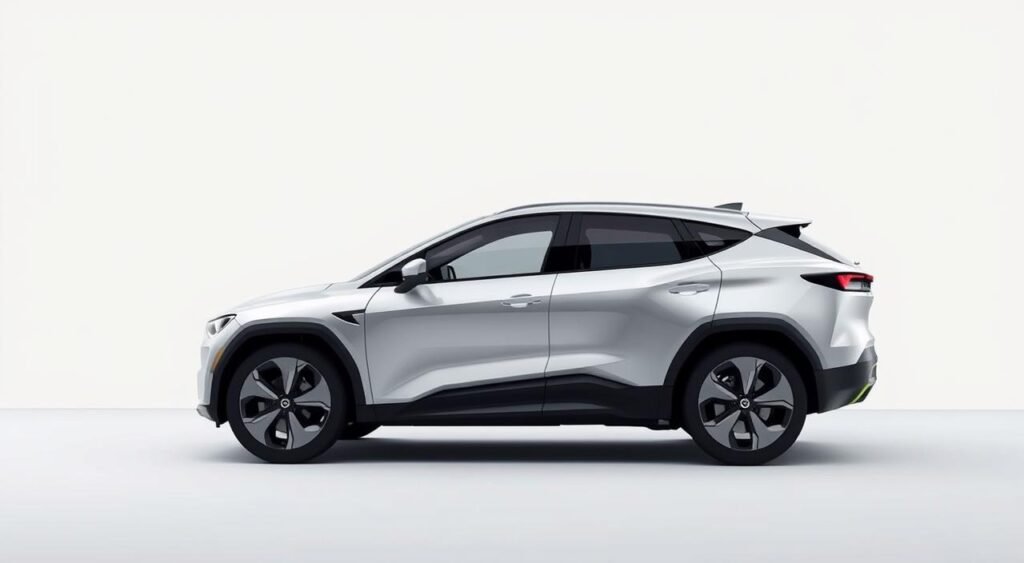
Factors Affecting Performance
Many things affect the XEV9E’s performance:
- Driving style – Fast driving cuts range by up to 20 percent
- Climate control – Using air conditioning reduces range by about 15 percent
- Terrain variations – Going up hills makes it less efficient
- Vehicle payload – Carrying more people and stuff uses more battery
- Drive modes – You can choose settings to save energy or go fast
Comparisons with Manufacturer Claims
The difference between ARAI ratings and real-world results is common. The Pack Three has a 282 bhp motor for fast starts but uses more energy. Charging is fast, with DC fast charging to 80 percent in 20 minutes at 180 kW stations.
Standard AC charging takes 8 to 11.7 hours. This depends on the charger’s power, 7.2 kW or 11.2 kW.
Performance Results: BE6
The BE6 electric SUV stands out in the Mahindra vs BE6 electric vehicle range testing. It shows top-notch performance that beats many expectations. Tests show it can keep a steady range in various driving conditions and stays efficient.
Total Range Achieved
The BE6 has two battery options, both showing great range. The 59 kWh battery gets 557 kilometers, as certified by ARAI. The bigger 79 kWh battery goes up to 683 kilometers on one charge. Surprisingly, the Batman Edition with the 59 kWh battery also hits 683 kilometers, thanks to smart efficiency.
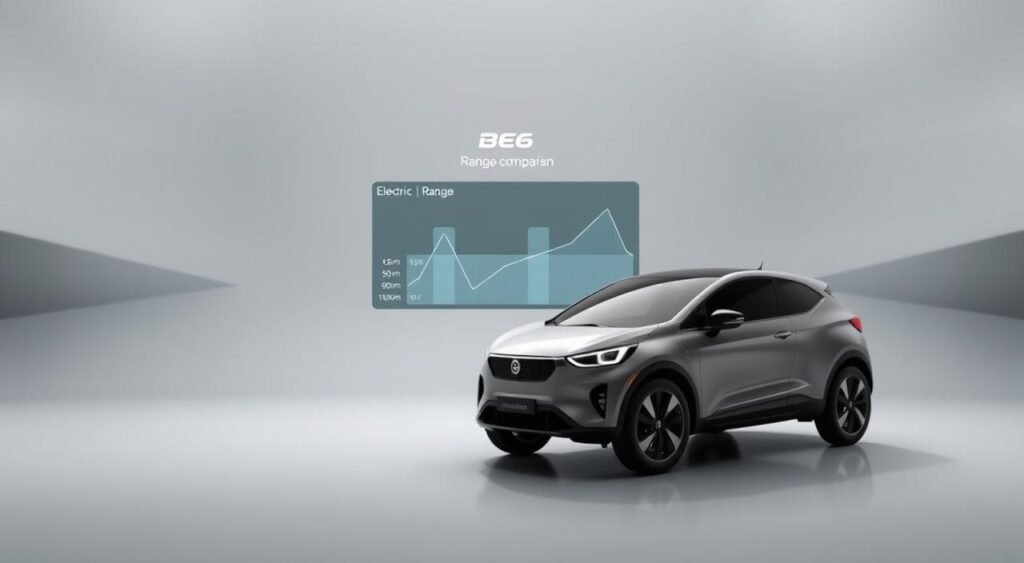
Factors Affecting Performance
Several things help the BE6 achieve its impressive range:
- Its lighter weight at 2,070 kg helps it use energy better
- The 228 bhp motor gives good power without using too much energy
- Five drive modes let drivers choose between range or speed
- Range mode boosts distance by adjusting the throttle
- Its design cuts down on drag at high speeds
Comparisons with Manufacturer Claims
Real-world tests show the BE6 lives up to its promises. It accelerates from 0-100 kmph in 6.7 seconds, proving its speed. It also charges fast, reaching 80% in 20 minutes with 140 kW chargers. AC charging takes 6 to 8.7 hours, depending on the charger used.
Head-to-Head Comparison
When we compare the Mahindra XEV9E and BE6, we find some surprising results. These two models show different ways to improve efficiency and range in the Indian EV market.
Side-by-Side Range Analysis
The BE6 leads with a 683 km ARAI-certified range from its 79 kWh battery pack. The XEV9E gets 656 km with the same battery, 27 km less. This is important for those who drive long distances.
| Specification | Mahindra XEV9E | BE6 |
|---|---|---|
| ARAI Range | 656 km | 683 km |
| Battery Capacity | 79 kWh | 79 kWh |
| Power Output | 282 bhp | 228 bhp |
| DC Fast Charging | 180 kW | 140 kW |
| Drivetrain | RWD Single-speed | RWD Single-speed |
Performance Under Similar Conditions
In real-world tests, both cars see a 15-30% drop from their ARAI ranges. The BE6’s lighter build helps it perform better. The XEV9E makes up for it with quicker charging, cutting down on wait times. Both have identical CCS-II charging ports, making them compatible with India’s charging network.
Cost of Ownership
When looking at the Mahindra XEV9E vs BE6 Range Test, the cost is key. The total cost of owning a car is more than just the price. It includes how much you spend on running the car every day.
Initial Purchase Prices
The BE6 starts at Rs 18.90 lakh, making it cheaper. The XEV9E costs Rs 21.90 lakh, which is Rs 3 lakh more. For those wanting the best, the XEV9E Pack Three costs Rs 31.25 lakh.
The BE6 Batman Edition is Rs 27.79 lakh. It’s a special edition that’s cheaper than the XEV9E’s top model.
Ongoing Costs: Charging and Maintenance
Both cars save money on running costs. They both support home charging with 7.2 kW or 11.2 kW AC chargers. This means similar costs for daily use.
Both makers offer five-year free service packages. This helps cut down on maintenance costs right from the start.
| Cost Factor | Mahindra XEV9E | BE6 |
|---|---|---|
| Base Price | Rs 21.90 lakh | Rs 18.90 lakh |
| Top Variant | Rs 31.25 lakh | Rs 27.79 lakh |
| Free Service Period | 5 years | 5 years |
| Home Charging Options | 7.2/11.2 kW | 7.2/11.2 kW |
Electric cars don’t need oil changes and use regenerative braking. This makes brake pads last longer. Insurance for the XEV9E is higher because it’s more expensive.
Both cars get government subsidies and tax benefits. This helps lower the cost of buying them.
Conclusion: Which EV is the Better Choice?
The electric vehicle range test shows each model has its own strengths. The BE6 leads with a certified range of 683 kilometers. This is 27 kilometers more than the XEV9E’s top variant range of 656 kilometers.
This difference makes the BE6 better for those who want to travel far without needing to charge often.
Summary of Key Findings
The BE6 has a lower starting price, Rs 3 lakh less than the XEV9E. This makes electric cars more affordable for Indian buyers. Its design and range are appealing to those looking for value.
The XEV9E offers more space, with a huge 663-liter boot and a long body. This makes it great for families who need room for everyone.
Both cars have 5-star BNCAP safety ratings and advanced ADAS technology. The XEV9E charges faster, which is good for long trips. It also has premium features like triple screens and Harman/Kardon audio.
Real-world tests show both cars can go 430-460 kilometers on Indian roads. This meets most daily driving needs.
Recommendations for Future Buyers
The BE6 is perfect for single professionals and couples. It offers great range, sporty looks, and value. Its lower price and better range make it great for first-time EV buyers.
The XEV9E is better for families. It has more space, comfort, and premium features. Mahindra’s wide service network in India supports both models, ensuring a good ownership experience.
FAQ
What is the real-world range difference between the Mahindra XEV9E and BE6?
The BE6 has a higher ARAI-certified range of 683 km with its 79 kWh battery. The XEV9E has a range of 656 km. But, real-world tests show both cars get about 70-80% of their claimed range.
User reviews say the XEV9E gets 430-460 km in mixed driving. The BE6 might be slightly more efficient because it’s lighter and has a better powertrain.
How much faster does the XEV9E charge compared to the BE6?
The XEV9E charges at 180 kW DC fast, while the BE6 charges at 140 kW DC. Yet, both can get to 80% charge in about 20 minutes with DC fast charging.
For home AC charging, both take 8-11.7 hours. This depends on whether you use a 7.2 kW or 11.2 kW charger.
What accounts for the Rs 3 lakh price difference between these electric vehicles?
The XEV9E starts at Rs 21.90 lakh, while the BE6 starts at Rs 18.90 lakh. This Rs 3 lakh difference is due to several factors.
The XEV9E is bigger, with a 4789 mm length compared to the BE6’s 4371 mm. It also has a larger boot, 663 liters, versus the BE6’s 455 liters. Plus, it has triple 12.3-inch screens and more power, 282 bhp, than the BE6’s 228 bhp.
How does ARAI testing differ from real-world EV range results?
ARAI testing is done in a controlled lab, measuring energy use and predicting range based on battery size. Real-world tests, though, mix different driving conditions.
Things like temperature, terrain, and driving style greatly affect actual range. This can cut the range by 15-30% from ARAI figures for both cars.
Which EV offers better value for Indian buyers considering EV efficiency comparison?
The BE6 is more affordable, starting at Rs 18.90 lakh. It has a top ARAI range of 683 km and a 228 bhp motor. It also goes from 0-100 kmph in 6.7 seconds.
But, the XEV9E offers more space and premium features. Its larger cabin, advanced infotainment, and faster DC charging might be worth the extra cost for some.
What are the key electric vehicle performance differences between these models?
The XEV9E has 282 bhp and 380 Nm torque in its top variants. The BE6 has 228 bhp and 380 Nm torque. Yet, the BE6 is faster, reaching 0-100 kmph in 6.7 seconds.
Both cars have rear-wheel drive and single-speed automatic transmission. They also have multiple drive modes, including Range mode for better efficiency.
How do regenerative braking systems affect the Mahindra vs BE6 electric vehicle range?
Both cars have 4-level regenerative braking systems. This helps recover energy during braking, improving efficiency and reducing brake wear. It also lowers maintenance costs.
The braking can be adjusted based on driving style and conditions. This allows for better performance or range, depending on preference.
What factors most significantly impact the electric vehicle range test results?
Driving style, climate control, terrain, and payload are key factors. Aggressive driving, air conditioning, hills, and heavy loads can cut range by up to 30%.
Both models have drive modes to optimize range or performance. Range mode is for efficiency, while Race or Sport modes focus on speed.
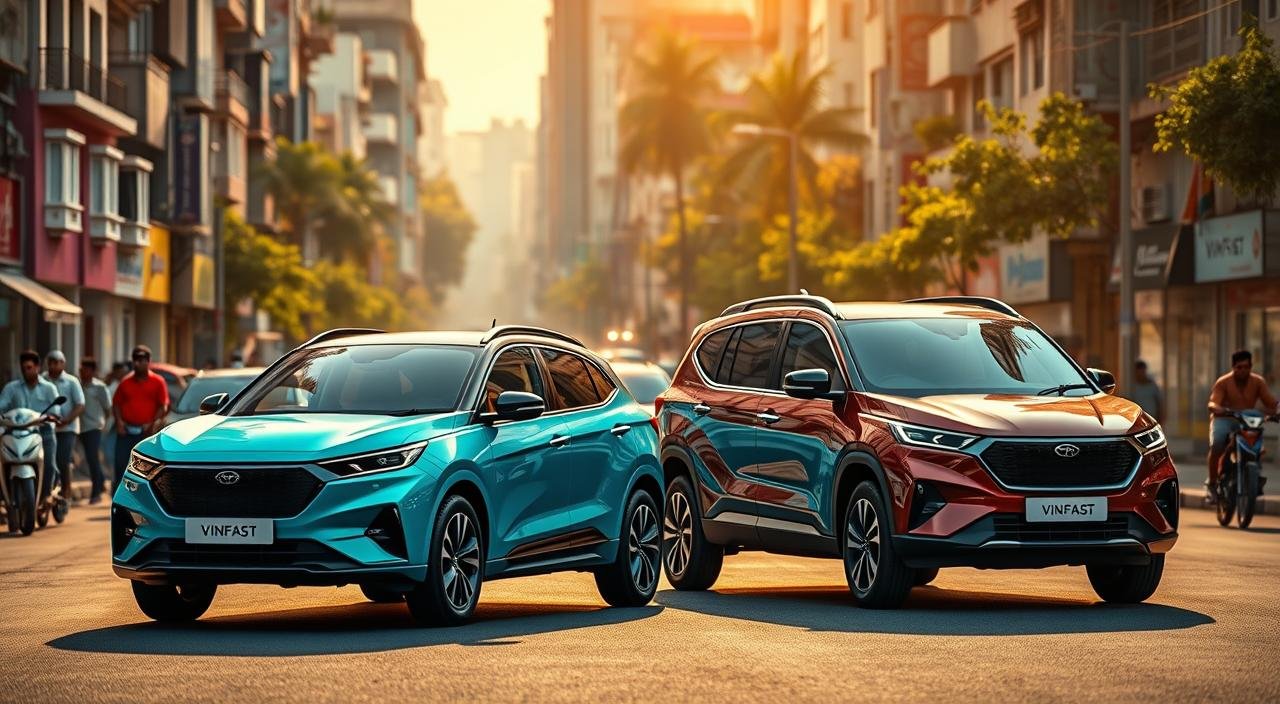
Oct
Can a Vietnamese automaker make a splash in India’s electric vehicle market? VinFast is ready to take on the challenge. They launched their premium electric SUVs in New Delhi on September 6, 2025.
The company introduced two flagship models, the VF6 and VF7 EVs. These vehicles mark VinFast’s bold move into India’s booming automotive market. CEO Pham Sanh Chau emphasized that these cars are made in India, by Indians, for Indians.
Production happens at the Thoothukudi facility in Tamil Nadu. This plant starts with 50,000 units a year and can grow to 150,000 vehicles. The VF6 starts at ₹16.49 lakh, and the VF7 EVs begin at ₹20.89 lakh ex-showroom.
Bookings started in July with a ₹21,000 token amount. This pricing makes both models competitive against other electric SUVs in India. VinFast is entering the market when many are looking for affordable electric options.
Key Takeaways
- VinFast launched the VF6 and VF7 electric SUVs in New Delhi on September 6, 2025
- Manufacturing facility in Thoothukudi, Tamil Nadu produces up to 150,000 vehicles annually
- VF6 starts at ₹16.49 lakh while VF7 begins at ₹20.89 lakh ex-showroom
- Bookings opened in July with a ₹21,000 token amount
- Both models target Indian consumers seeking premium yet affordable electric SUVs
- Local production ensures vehicles meet specific Indian market requirements
VinFast’s Journey into the Indian Market
Vietnamese automaker VinFast is now eyeing India for growth. They’ve already made waves in the U.S., Canada, Europe, and more. This move is a big step for VinFast in India and shows their big plans for South Asia.
Overview of VinFast’s Expansion
VinFast is Vietnam’s top car maker, run by Vingroup JSC and led by Pham Nhat Vuong. They sell electric cars across three continents. Recently, they partnered with 13 dealer groups to open 32 dealerships in 27 Indian cities.
Their factory in Thoothukudi is key for sales in India and exports. Pham Sanh Chau said cars made in India will go to South Asia, the Middle East, and Africa.
Key Reasons for Choosing India
India is a smart choice for VinFast:
- Thoothukudi’s port is great for shipping cars
- More people in India want affordable electric cars
- The government supports EVs
- It’s a good spot to reach other markets
- There’s a strong car-making scene here
| Market Region | Export Potentia | Distance from Thoothukudi |
|---|---|---|
| Middle East | High | 2,500 km |
| Southeast Asia | Medium | 1,800 km |
| East Africa | High | 3,200 km |
Introducing the VF6 and VF7 Electric Vehicles
VinFast EVs India introduces two SUV models to India’s electric vehicle market. The VF6 compact SUV and VF7 large SUV blend innovative design with practical electric mobility. They are designed for Indian roads and preferences.
Unique Features of VF6
The VF6 is inspired by the ‘Duality in Nature’ concept. It has a 59.6 kWh battery pack for fast charging. It goes from 10% to 70% in 25 minutes.
The ARAI-certified range is up to 468 kilometers on a single charge. This makes it perfect for city drives and weekend getaways.

- Earth (₹16.49 lakh) – 130 kW power output
- Wind (₹17.79 lakh) – 150 kW power, 0-100 kmph in 8.9 seconds
- Wind Infinity (₹18.29 lakh) – Includes panoramic glass roof
The VF6 has a 2,730 mm wheelbase and 190 mm ground clearance. This provides ample space and is suitable for Indian roads.
Unique Features of VF7
The VF7 is based on the ‘Universe is Asymmetrical’ design. It’s a large SUV over 4.5 meters long with a spacious 2,840 mm wheelbase. VinFast offers five VF7 variants, priced from ₹20.89 lakh to ₹25.49 lakh.
The Sky variants have AWD dual motors for 260 kW power. This boosts its performance.
Both models come with advanced safety and tech features. They include seven airbags, 360-degree cameras, 12.9-inch displays, and Level 2 ADAS.
The Competitive EV Landscape in India
India’s electric vehicle market is a hot spot for car makers. VinFast’s entry is timely, as EV sales have skyrocketed. In 2024, India saw 18.78 million EV sales, making up 7.6% of all vehicle sales. This boom brings both chances and hurdles for newcomers.
Major Players in the Indian EV Market
The Indian EV scene has both local heroes and global rivals. Tata Motors is leading with a 93% rise in electric car sales in July, says the Federation of Automobile Dealers Associations. Maruti Suzuki India Ltd. brings its huge dealer network and strong brand to EVs.
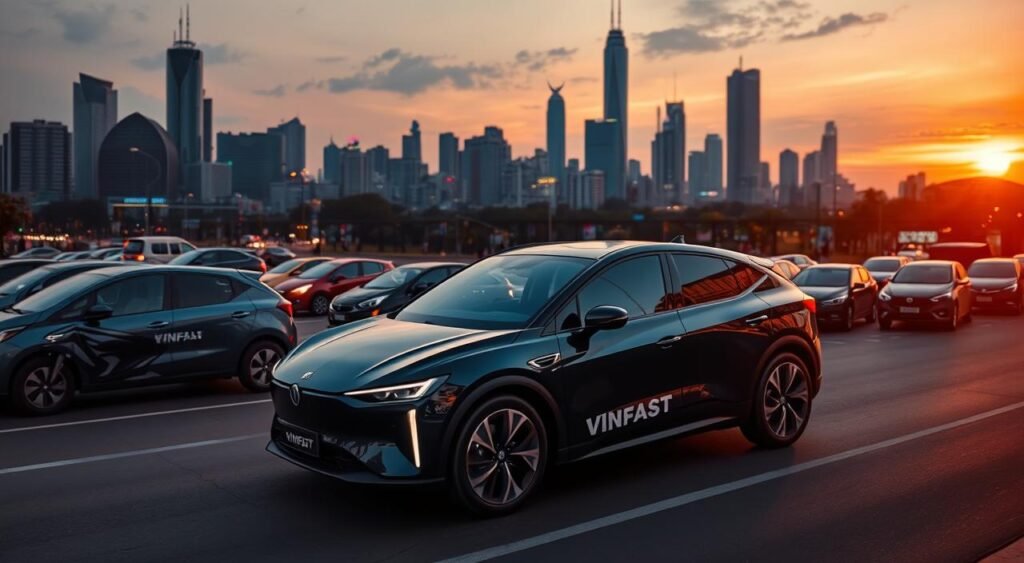
BYD Co. and SAIC Motor Corp Ltd.’s India venture add to the competition. Each brand has its own strengths to grab a piece of the market.
How VinFast Stands Out
VinFast aims for high-end features in its EVs. They offer piano-inspired gear selectors and vegan leather in mocca brown and black. Plus, they provide a 10-year or 200,000 km battery warranty.
- Free charging at VGreens stations until July 2028
- Three years of complimentary maintenance
- Premium features usually found in higher segments
These perks make VinFast a top choice in India’s EV market.
Sustainability Goals in India
India is moving fast towards green mobility, making it a great place for VinFast to grow. The country wants 30% of all vehicles to be electric by 2030. This means a big jump in electric car use over the next five years, as said by NITI Aayog.
This change is opening up new chances for companies that focus on green transport.
VinFast’s Commitment to Eco-Friendly Solutions
VinFast is leading the way in India’s green car movement. They work with BatX Energies to create better battery recycling. This helps make electric vehicles in India more eco-friendly from start to finish.

VinFast wants to make electric cars available to all. They’re part of the global push for more electric vehicles. Their goals match India’s growing EV market, where big investments are being made in battery tech and car range.
Government Initiatives Supporting EVs
India’s banks are helping with the switch to electric cars. The Central Bank of India has grown its green funds to ₹4,200 crore by June 2025. They’ve also raised ₹295 crore through Green Deposits.
The bank plans to give out ₹1,600 crore in green finance by FY 2025-26. This supports India’s goal to be carbon neutral.
Consumer Demand for Electric Vehicles
India’s car market is changing fast, with electric vehicles becoming more popular. VinFast’s VF6 and VF7 EVs are ready to meet this growing interest. People want cars that are good for the planet, perform well, and have the latest tech.
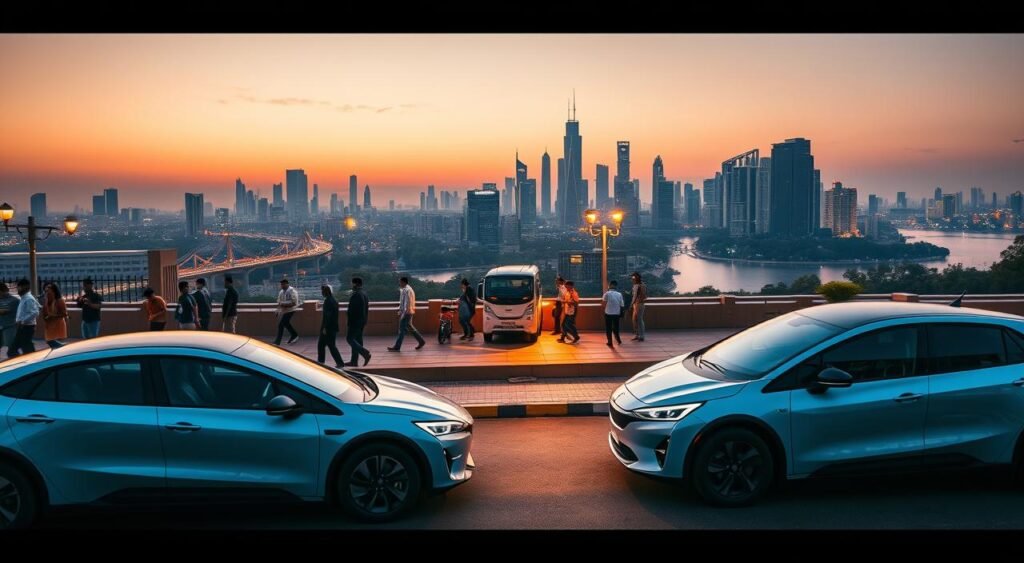
Trends in Indian Consumer Preferences
Indian car buyers now look for three main things in electric vehicles: driving range, comfort, and advanced safety features. The VF6 and VF7 EVs meet these needs with their stylish designs and many features. People are willing to pay more for electric cars that offer these benefits.
VinFast’s CEO says the reaction to their electric SUVs has been amazing. This interest comes from many people, including young professionals and families. They all want cars that are good for the environment and have the latest technology.
The Rise of EV Acceptance in Cities
Big cities are at the heart of India’s electric car movement. VinFast aims to open dealerships in key places like:
- Delhi, Gurugram, and Noida
- Chennai, Bengaluru, and Hyderabad
- Pune, Jaipur, and Ahmedabad
- Kolkata, Kochi, and Bhubaneswar
These cities are where electric cars are most in demand. They have more charging spots and people care about the environment when buying cars.
Technology and Innovation Behind VF6 and VF7
The latest VinFast news highlights the tech in the VF6 and VF7 models for India. These electric cars have advanced battery systems and smart features. They are designed for tech lovers in India and are strong contenders in the EV market.
Cutting-Edge Battery Technology
The VF6 has a 59.6 kWh battery pack for great ranges. The Earth version goes 468 kilometers, and the Wind version goes 463 kilometers. VinFast offers the VF7 with two battery options for different needs.

| Model | Battery Capacity | Range (km) | Charging Time (10-70%) |
|---|---|---|---|
| VF6 Earth | 59.6 kWh | 468 | 25 minutes |
| VF7 Earth | 59.6 kWh | 438 | 24 minutes |
| VF7 Wind/Sky | 70.8 kWh | 532 | 28 minutes |
Infotainment and Connectivity Features
Both models have a 12.9-inch infotainment touchscreen for easy connectivity. They support wireless Android Auto and Apple CarPlay. This keeps drivers connected without hassle.
They also have advanced safety features like adaptive cruise control. The driver monitoring camera checks for distraction. Front and rear automatic emergency braking systems add extra safety.
Comfort features include a 90W USB-C charging port and an acoustic windshield. There’s also a bezel-less auto-dimming rearview mirror for a quieter ride.
VinFast’s Marketing Strategy in India
The Vietnamese automaker is making a big splash in India. They focus on families who want green, high-quality cars at good prices. VinFast India combines top-notch safety tech with great after-sales support. This creates a special electric car world for Indian families.
Target Audience and Brand Positioning
VinFast is aiming at middle-class families and city workers who want electric cars. They offer practical yet fancy electric cars. The main points are:
- Advanced driver assistance systems
- Spacious interiors for family comfort
- Competitive pricing against established brands
- Extended warranty programs
Collaborations and Partnerships
VinFast is teaming up with key players to grow in India. They’ve partnered with the Central Bank of India for easy car loans. This deal uses 4,552 branches and 21,000 points across the country.
They’ve also teamed up with RoadGrid, myTVS, and Global Assure for charging and maintenance. These partnerships mean customers get reliable help from start to finish. Bank reps are even at showrooms to help with buying.
Challenges Facing VinFast in India
The VinFast India launch faces big hurdles in a market where electric vehicles make up only 7.6% of sales. The Vietnamese automaker must deal with tough infrastructure and rules. It also has to compete with well-known local makers.
Infrastructure Readiness for EV Adoption
India’s lack of charging spots is a big problem for electric cars. VinFast is working on a wide charging network through partnerships. It’s also giving free charging until July 2028 to help early buyers.
The company plans to open 35 dealers and 26 workshops in 27 cities by late 2025. This big plan aims to fill gaps in both big cities and smaller towns.
Regulatory Hurdles and Compliance
Dealing with India’s many state rules is a big challenge for VinFast. Each state has its own EV policies and rules. VinFast’s factory in Tamil Nadu helps meet local needs and supports India’s EV goals.
| Challenge Area | Current Status | VinFast Solution |
|---|---|---|
| Charging Infrastructure | Limited coverage | Free VGreens network until 2028 |
| Market Competition | Dominated by Tata and MG | Premium positioning with VF6 and VF7 |
| Distribution Network | Needs expansion | 27 cities coverage by 2025 |
Chinese brands and big players like Tata Motors add to the pressure. VinFast must stand out while helping India reach its goal of 30% EVs by 2030.
Plans for Future Expansion
VinFast has big plans beyond the VF6 and VF7 in India. Their Tamil Nadu factory is key, starting with 50,000 cars a year. It can grow to 150,000, showing VinFast’s big plans for India.
This factory is close to major ports. This makes India a key spot for sending cars to South Asia, the Middle East, and Africa.
Potential Models Planned for India
VinFast has a wide range of electric cars in Vietnam. They might bring electric scooters and e-buses to India soon. These could meet many needs, from personal rides to public transport.
Expansion into Other Markets
VinFast is growing in India and around the world. They opened their first showroom in Surat in July 2025. They aim to have dealers in 27 cities by the end of the year.
This fast growth is like VinFast’s plans in North America and Europe. The Indian factory is key for sending cars to nearby areas. It’s a big part of VinFast’s Asian plans.
Conclusion: The Future of VinFast in India
VinFast aims high in India’s electric car market with its top-notch VF6 and VF7 EVs. It starts with a strong base in the Thoothukudi factory and partners across the country. This plan matches India’s goal to lead in electric cars by 2030.
Vision and Impact on the EV Ecosystem
The Vietnamese company brings global know-how to India’s EV scene. VinFast focuses on building a full EV ecosystem, not just selling cars. It offers a 10-year or 200,000 km battery guarantee and three years of free service.
Customers get free VGreens charging until July 2028. This cuts down on costs a lot.
Call to Action for Future Customers
The VF6 and VF7 electric SUVs start at ₹16.49 lakh, a good deal in the market. You can book one for ₹21,000 at VinFast dealers in big cities. Central Bank offers special loans to make these cars more affordable.
The growing number of dealers means you’ll get all the help you need. VinFast EVs India is ready to help families switch to electric cars smoothly.
FAQ
When did VinFast officially launch in India and which models are available?
VinFast launched in India on September 6, 2025, in New Delhi. They introduced two electric SUVs: the VF6 and the VF7. These are VinFast’s first models in India’s growing electric vehicle market.
What are the prices for VinFast EVs in India?
The VF6 starts at ₹16.49 lakh. Prices go up to ₹18.29 lakh for the Wind Infinity variant. The VF7 starts at ₹20.89 lakh and goes up to ₹25.49 lakh for the Sky Infinity variant with AWD.
Where are VinFast vehicles manufactured in India?
VinFast makes its vehicles in Thoothukudi, Tamil Nadu. The factory can make 50,000 vehicles a year, growing to 150,000. It’s near a port, ready for domestic and international markets.
What is the battery range and charging capability of VinFast electric vehicles?
The VF6 has a range of up to 468 km with its 59.6 kWh battery. It can charge from 10-70% in 25 minutes. The VF7 has ranges of 438-532 km, with fast charging in 24-28 minutes.
What warranty and after-sales support does VinFast offer?
VinFast offers a 10-year or 200,000 km battery warranty. They also provide three years of free maintenance and free charging at VGreens stations until 2028. They have a network for charging and after-sales services.
How many dealerships does VinFast have in India?
VinFast has 32 dealerships in 27 cities. They plan to add 3 more by the end of 2025. They cover major cities like Delhi, Mumbai, and Bengaluru.
What financing options are available for VinFast India customers?
VinFast has a deal with Central Bank of India for car financing. They offer low interest rates and flexible payments. You can get support at VinFast showrooms with over 4,500 branches nationwide.
What safety features come standard on VinFast EVs?
The VF6 and VF7 have 7 airbags and a 360-degree camera. They also have advanced driver assistance features like adaptive cruise control and lane assist. These ensure safety for everyone.
How can I book a VinFast vehicle in India?
Bookings started in July 2025 with a ₹21,000 token. You can book at any of the 32 dealerships or through VinFast’s official channels.
What makes VinFast different from other EV manufacturers in India?
VinFast offers premium features like a piano-inspired gear selector and vegan leather. They focus on “made in India, made by Indians, for Indians.” This combines local manufacturing with international expertise.

Oct
Imagine finding the perfect first car that’s both affordable and packed with features. The world of first-time car buyers has changed a lot. Now, cars come with advanced tech and safety at prices you never thought possible.
In 2025, the car market is full of new options. Gone are the days of just hatchbacks. Now, you can find micro-SUVs, tall-boy designs, and subcompact cars with lots of features. Prices start at Rs 4.99 lakh and go up to Rs 12.46 lakh, making it easier to own a car without breaking the bank.
The best budget cars for 2025 include the Maruti WagonR, the Hyundai Grand i10 Nios, the Tata Punch, the Maruti Swift, and the Hyundai Venue. Each car meets different needs while keeping costs low for first-time buyers.
These cars come in various styles and are great for different needs. Whether you want something for city driving, long trips, or weekend fun, there’s a car for you. They all fit within your budget and lifestyle.
Key Takeaways
- Budget-friendly options start from Rs 4.99 lakh with modern features and safety equipment
- Micro-SUVs and tall-boy designs offer better practicality than traditional hatchbacks
- Maruti WagonR, Hyundai Grand i10 Nios, Tata Punch, Maruti Swift, and Hyundai Venue lead the affordable segment
- Low running costs make these vehicles ideal for first-time ownership
- Each model balances different strengths like fuel efficiency, space, or style
- Price range up to Rs 12.46 lakh covers diverse vehicle types and feature sets
Why Buying a Car in 2025 is a Smart Move
The automotive market in 2025 is full of chances for first-time car buyers in India. Car makers are now making cars that are both affordable and stylish. They are also focusing on safety and fuel options, making cars a smart choice for many.
Trends in the Automotive Market
Car buying trends in India are really interesting. Micro-SUVs are very popular because they look like SUVs but cost less. Safety is a big deal now, with most cars having six airbags. Also, even the cheapest cars have cool tech like touchscreens.
| Market Trend | 2024 Status | 2025 Projection |
|---|---|---|
| CNG Vehicle Sales | 15% market share | 22% market share |
| Average Safety Rating | 3.5 stars | 4.2 stars |
| Entry-Level Price Range | ₹4-6 lakhs | ₹4.5-7 lakhs |
The Benefits of Vehicle Ownership
Having a car is more than just getting from point A to point B. It gives you freedom of movement, which is key for India’s growing workforce. It also means you don’t have to rely on public transport or deal with high prices from ride-sharing services. Plus, cars are becoming more affordable, and you can even make them your own with customization options.
Setting a Realistic Budget
Planning your budget is key to smart car ownership. First Car Buying Tips start with understanding that your financial commitment goes beyond the sticker price. Entry-level vehicles in India start at Rs 4.99 lakh, while top models can cost up to Rs 12.46 lakh.
Creating a practical budget means looking at your income, expenses, and future goals. This helps you decide if you’re ready to buy a car.
Understanding Total Cost of Ownership
The total cost of owning a car includes more than just the purchase price. Registration fees, road tax, and insurance are immediate costs. Monthly costs like fuel, maintenance, and parking add up.
Extended warranties and accessory packages also affect your budget. Warranties can cost between Rs 1,500 and Rs 3,500. Accessory packages range from Rs 1,000 for basic mats to Rs 2,995 for paint protection.

| Cost Component | Estimated Amount (Rs) | Payment Frequency |
|---|---|---|
| Vehicle Price | 4,99,000 – 12,46,000 | One-time |
| Insurance Premium | 15,000 – 35,000 | Annual |
| Road Tax | 50,000 – 1,25,000 | One-time |
| Fuel Expenses | 3,000 – 6,000 | Monthly |
| Service & Maintenance | 5,000 – 10,000 | Quarterly |
Financing Options to Explore
Car financing in India offers many options for first-time buyers. Banks can lend up to 90% of the vehicle’s value. Loans last from three to seven years.
Interest rates range from 7.5% to 12%, based on your credit score and income. Dealerships sometimes offer zero-percent interest during festivals.
Saving for a Down Payment
A big down payment lowers your loan and monthly payments. Experts suggest saving 20-30% of the car’s price before buying. Saving Rs 10,000-15,000 monthly can build Rs 1.5-2 lakh in a year.
This approach reduces interest payments over time, saving you money.
Essential Features for First-Time Buyers
Choosing the right features in budget cars is key for a good driving experience. First-time buyers must find a balance between what they need and what they want. Luckily, the Indian market has many affordable cars with important features.
Safety Features to Prioritize
Today, even entry-level cars come with important safety features. Many models now have six airbags to protect everyone inside. The Tata Punch is a standout with its 5-star Global NCAP rating, showing that safety doesn’t have to be expensive.
Some must-have safety features include:
- Anti-lock Braking System (ABS) for controlled braking
- Electronic Stability Control (ESC) to prevent skidding
- Hill-hold assist for easier slope management
- Tire Pressure Monitoring System (TPMS) for optimal tire conditions

Fuel Efficiency and Eco-Friendly Options
For those watching their budget, fuel-efficient cars are a must. Engines between 1.0-litre and 1.2-litre offer great performance and mileage. These engines provide enough power for both city and highway driving.
| Engine Size | Power Output | Typical Mileage |
|---|---|---|
| 1.0-litre Petrol | 68-75 PS | 22-24 km/l |
| 1.2-litre Petrol | 85-120 PS | 18-20 km/l |
Technology and Connectivity Preferences
Budget cars now come with impressive tech features. Many models have 8-inch to 10.25-inch touchscreen infotainment systems. Android Auto and Apple CarPlay make connecting smartphones easy. Premium versions add features like wireless charging, automatic climate control, and Bose sound systems for more comfort.
Top 5 Budget Cars to Consider in 2025
Finding the right car within budget can feel overwhelming for first-time buyers. The Indian automotive market offers excellent options that balance price, features, and reliability. These Affordable Cars 2025 deliver value without compromising on essential features that matter most to new car owners.
Why These Models Stand Out
Each vehicle on this list earned its place through a combination of practical benefits. Strong fuel economy keeps running costs low, while proven reliability means fewer repair bills. These best budget vehicles India offers come from established manufacturers with wide service networks. Smart pricing strategies make them accessible to young professionals and families alike.
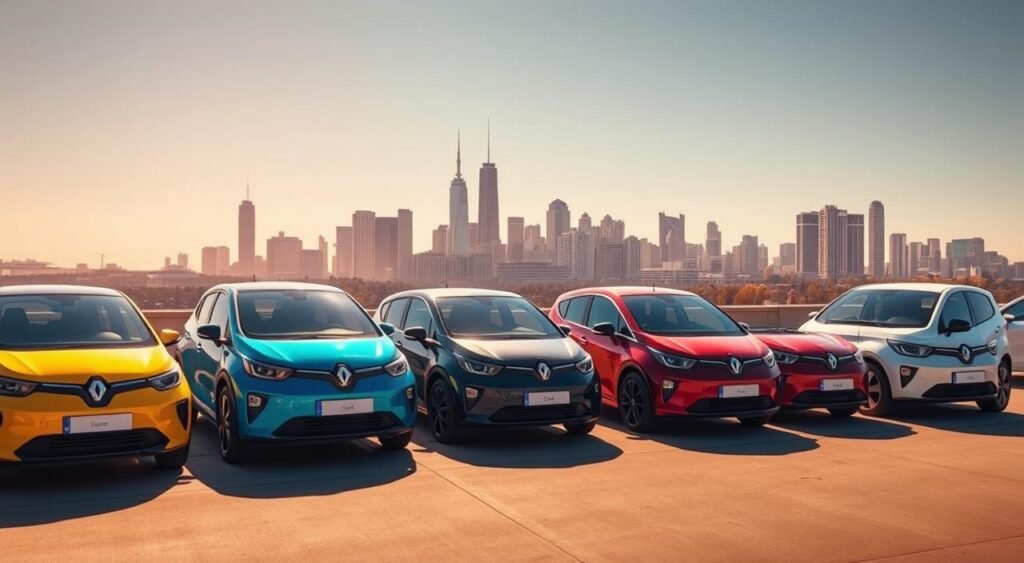
Overview of Each Vehicle
The selection represents diverse approaches to affordable transportation. From compact city cars to SUV-styled crossovers, buyers can match their lifestyle needs without stretching their budget. These top economy cars prove that sensible pricing doesn’t mean settling for less.
| Model | Starting Price | Key Feature | Fuel Options |
|---|---|---|---|
| Maruti WagonR | Rs 5.54 lakh | 335L boot space | Petrol, CNG |
| Hyundai Grand i10 Nios | Rs 5.92 lakh | Premium interiors | Petrol, CNG |
| Tata Punch | Rs 6.12 lakh | 187mm ground clearance | Petrol, CNG |
| Maruti Swift | Rs 6.49 lakh | Z-Series engine | Petrol, CNG |
| Hyundai Venue | Rs 7.94 lakh | Multiple engine choices | Petrol, Turbo, Diesel |
Detailed Review of the First Budget Car
The Maruti Suzuki WagonR is a great choice for first-time car buyers in India. It costs between Rs 4.99 lakh and Rs 6.95 lakh. This Maruti WagonR review shows why it’s popular for those looking for reliability and space.
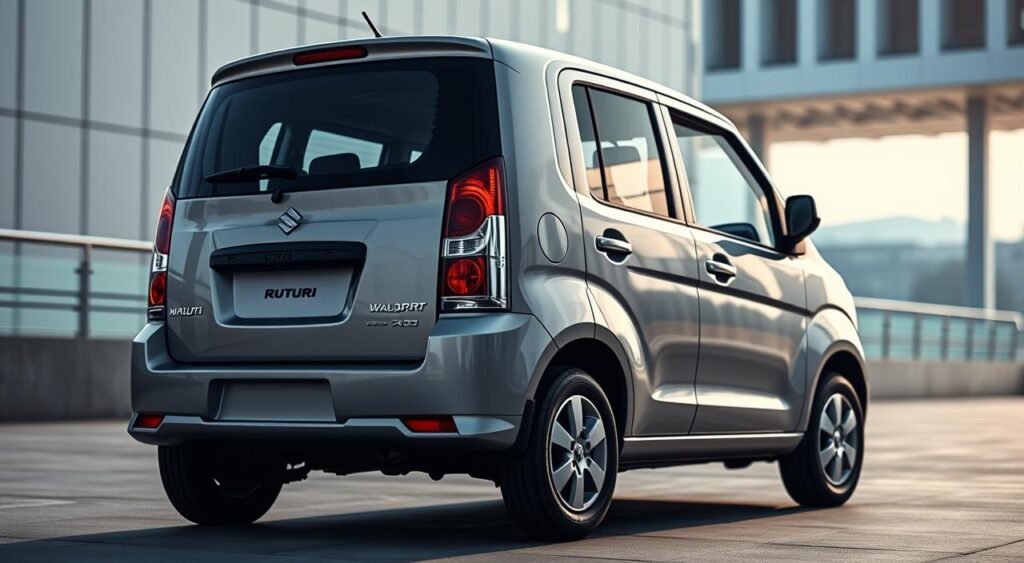
Key Specifications
The WagonR’s tall-boy design offers a lot of room inside. It’s different from other hatchbacks. You can pick from two engines, depending on what you need and can afford.
| Specification | 1.0L Engine | 1.2L Engine |
|---|---|---|
| Power Output | 68 PS | 91 PS |
| Torque | 91 Nm | 114 Nm |
| Transmission Options | Manual/AMT | Manual/AMT |
| CNG Variant | Available | Not Available |
| Boot Space | 335 liters | 335 liters |
The WagonR also comes with a CNG option, making it very affordable. It has six airbags for safety. Features like a touchscreen and steering controls make it easy to use every day.
Pros and Cons
Advantages:
- Exceptional headroom and visibility thanks to the tall-boy design
- Low running costs with excellent fuel economy
- Easy entry and exit for all passengers
- Strong resale value through Maruti’s dealer network
- Spacious 335-liter boot capacity
Disadvantages:
- Plain interior materials feel basic
- Driving dynamics lack excitement
- Styling may not appeal to younger buyers
- Safety ratings trail some competitors
Detailed Review of the Second Budget Car
The Hyundai Grand i10 Nios is a top pick in the premium hatchback market. It’s priced between Rs 5.47 to 7.92 lakh, making it a great value for first-time buyers. It offers a mix of features, performance, and comfort that’s hard to beat in its class.
Key Specifications
The Hyundai Grand i10 Nios has a 1.2-liter 4-cylinder petrol engine. It produces 83 PS of power and 114 Nm of torque. You can choose from a 5-speed manual or an AMT transmission, depending on your driving style.
The car has a 260-liter boot space, perfect for daily items. It also seats three comfortably in the back.

It comes with a touchscreen infotainment system and connected car tech. It also has wireless charging, rear AC vents, and automatic climate control. These features make it a tech-savvy option for those looking at affordable compact cars 2025.
Pros and Cons
The Hyundai Grand i10 Nios has a refined engine that performs well in all driving conditions. Its interior quality is top-notch, with premium materials and thoughtful design. The suspension is also great, making the ride smooth over rough roads.
One downside is that the top-spec variants are pricier than the base models. Its resale value isn’t as strong as some Maruti Suzuki models. Performance fans might find the engine less exciting, like when overtaking on highways.
Detailed Review of the Third Budget Car
The Tata Punch micro-SUV is a top pick for first-time buyers. It offers great value with its affordable price and safety features. Priced between Rs 5.50-9.24 lakh, it has a rugged design and practical features.
This car has caught a lot of attention in the budget segment. It achieved a 5-star safety rating from Global NCAP in 2021.
Key Specifications
The Tata Punch has a 1.2-liter petrol engine. It produces 88 PS power and 115 Nm torque. You can choose between a 5-speed manual or an AMT gearbox.
The car has impressive ground clearance of 187mm. This makes it perfect for Indian roads.
| Feature | Specification |
|---|---|
| Engine | 1.2L Petrol |
| Power Output | 88 PS |
| Torque | 115 Nm |
| Boot Space | 366 Liters |
| Infotainment Screen | 10.25 inches |
| Safety Rating | 5 Stars (Global NCAP) |
Pros and Cons
Strengths: The Punch is known for its SUV-like road presence and strong build. It has a large 366-liter boot space. Its 5-star safety rating gives new drivers and families peace of mind.
Weaknesses: The car’s performance is just okay for highway driving. The AMT transmission can be jerky in city traffic. Engine refinement could be improved, with noticeable vibrations at high speeds.
Detailed Review of the Fourth Budget Car
The Maruti Swift 2025 is a top pick for first-time car buyers in India. It’s a stylish hatchback with practical features and affordable prices, from Rs 5.79 to 8.80 lakh. The latest model has big improvements and keeps the Swift’s reliability that Indians love.
Key Specifications
The Maruti Swift 2025 uses the new Z-Series engine, a 1.2-liter 3-cylinder petrol unit. It makes 81 PS power and 112 Nm torque. You can choose between a 5-speed manual or AMT transmission, depending on your driving style.
| Specification | Details |
|---|---|
| Engine Type | 1.2L Z-Series 3-cylinder petrol |
| Power Output | 81 PS @ 5,700 rpm |
| Torque | 112 Nm @ 4,300 rpm |
| Transmission Options | 5-speed Manual / AMT |
| Boot Space | 265 liters |
| Safety Features | 6 airbags (standard) |
| Infotainment | Touchscreen with Android Auto/Apple CarPlay |
Pros and Cons
Advantages:
- The Z-Series engine offers great performance for city and highway driving.
- Maruti’s wide service network across India makes maintenance easy.
- It has a strong resale value, making it a smart buy.
- It comes with climate control and modern connectivity features.
Limitations:
- Base variants miss out on some premium features.
- The 265-liter boot space might be small for long family trips.
- Its safety ratings are lower than some competitors in this segment.
Detailed Review of the Fifth Budget Car
The Hyundai Venue subcompact SUV is a great choice for first-time car buyers in India. It’s priced between Rs 7.26-12.46 lakh. This car offers three engine options, making it versatile for different needs and budgets.
Key Specifications
The Hyundai Venue comes with a range of engines. The base 1.2-liter petrol engine makes 83 PS and 114 Nm of torque. The turbo-petrol engine produces 120 PS and 172 Nm, with manual and DCT options.
The diesel engine has 116 PS and 250 Nm of torque. This is perfect for those who want better fuel economy.
| Feature | Standard Variant | Premium Variant |
|---|---|---|
| Infotainment | 8-inch touchscreen | 8-inch with connected tech |
| Audio System | 4-speaker setup | Bose premium sound |
| Charging | USB ports | Wireless charging pad |
| Seats | Fabric upholstery | Ventilated front seats |
| Boot Space | 355 liters | 355 liters |
Pros and Cons
The Venue’s turbo-petrol and diesel engines attract many buyers. Safety equipment includes six airbags, ABS, ESC, hill-hold assist, and TPMS in all models. The interior is luxurious, with quality materials and modern tech.
But, the Venue has limited space for rear passengers. Its 355-liter boot is smaller than some competitors. Also, service costs are higher, and there’s no recent Global NCAP rating, which might worry safety-focused buyers.
Tips for Test Driving Your Future Car
Test driving a car is key when buying your first vehicle. It lets you check if the car feels right, drives well, and fits your needs. Being prepared and knowing what to look for is vital for making a good choice.
What to Look for During a Test Drive
Here are the main things to check when test driving a car:
- Check visibility from all angles, including blind spots and rear view
- Test acceleration on both city streets and highways
- Evaluate braking response at different speeds
- Listen for unusual engine noises or vibrations
- Test parking in tight spaces to gauge maneuverability
- Verify all controls are within comfortable reach
Questions to Ask the Dealer
Knowing the right questions to ask dealers can help you understand costs. Start by asking for a detailed breakdown of all fees beyond the sticker price. Make sure to ask about documentation charges, processing fees, and any pre-installed accessories.
| Essential Questions | Why It Matters |
|---|---|
| What’s included in the total price? | Reveals hidden fees and extras |
| Can pre-installed items be removed? | Saves money on unwanted additions |
| What does the warranty cover? | Clarifies protection and limitations |
| How is my trade-in valued? | Ensures fair market assessment |
This advice is for first-time buyers to navigate dealership talks well. Always think about your total budget, including taxes and financing, not just monthly payments. Ask to remove any declined warranties or protection packages from your invoice right away.
Final Thoughts on Buying Your First Car
Choosing your first car is a big decision. You need to think about what each model offers and what you need. This guide shows five cars that stand out in different ways. Your choice should match what’s most important to you, like safety, comfort, fuel efficiency, or value.
Summarizing Your Options
The Tata Punch and Hyundai Venue are great for those who value safety and SUV looks. The Punch is very affordable but well-made. The Venue offers more luxury for a bit more money. The Maruti Swift is perfect for those who love driving and style.
The Hyundai Grand i10 Nios has a fancy interior. The Maruti WagonR is all about being practical and saving money. Each car meets different needs. Think about what you need, like handling or space, when choosing.
Also, consider the car’s resale value and service availability in your area. This will help you make a smart choice.
Preparing for Ownership
Getting ready to own a car is more than just picking one. Think about all the costs, like insurance, maintenance, and fuel. Don’t let dealers push you into buying extras you don’t need.
Keep your loan short to save on interest. Find service centers near you before buying. Having a maintenance fund can help with unexpected costs.
FAQ
What are the best budget cars for beginners in 2025?
In 2025, the best budget cars for new drivers include the Maruti WagonR (Rs 4.99-6.95 lakh) for its practicality. The Hyundai Grand i10 Nios (Rs 5.47-7.92 lakh) offers premium features. The Tata Punch (Rs 5.50-9.24 lakh) is great for SUV styling and safety.
The Maruti Swift (Rs 5.79-8.80 lakh) is known for its driving enjoyment. The Hyundai Venue (Rs 7.26-12.46 lakh) has multiple engine options and advanced features.
How much should I budget for my first car purchase beyond the sticker price?
When buying your first car, remember to add more than just the sticker price. You’ll need to pay for registration taxes, insurance, and financing charges. Don’t forget accessories, which can cost from Rs 1,000 to Rs 2,995.
Extended warranties can add another Rs 1,500 to Rs 3,500. Always think about the total cost of owning the car, not just the monthly payments.
Which affordable car offers the best safety rating in 2025?
The Tata Punch is the safest budget car, with a 5-star Global NCAP rating from 2021. Its electric version got a 5-star Bharat NCAP rating. Most cars now come with six airbags and safety features like ABS and ESC.
The Tata Punch stands out for its build quality and safety in the budget segment.
What engine size provides the best fuel efficiency for first-time car buyers?
The 1.0-litre and 1.2-litre petrol engines are the most fuel-efficient for budget buyers. They deliver 25-28 mpg in real-world driving. The Maruti WagonR’s 1.0-litre engine is very economical.
The 1.2-litre engines in the Maruti Swift and Tata Punch balance performance with good fuel economy.
Should I choose a manual or automatic transmission for my first car?
Most budget cars come with both manual and AMT (Automated Manual Transmission) options. Manual transmissions are cheaper and better for fuel economy. AMT is more convenient in traffic.
The Hyundai Venue also has a DCT with its turbo-petrol engine for smoother automatic driving, but it’s pricier.
What first car buying tips should I follow when visiting dealerships?
When visiting dealerships, ask for clear explanations of all fees. Make sure to verify trade-in values separately. Question any pre-installed accessories that seem mandatory.
Decline unwanted extended warranties. During test drives, check visibility, comfort, and handling on different roads. Don’t be afraid to ask for changes to the invoice or look for other cars without extras.
Which budget car offers the most cargo space for practical needs?
The Tata Punch has the most boot space at 366 litres. The Hyundai Venue and Maruti WagonR follow with 355 and 335 litres, respectively. The WagonR’s design adds great headroom and visibility.
The Maruti Swift has 265 litres, while the Hyundai Grand i10 Nios offers 260 litres.
What technology features come standard in affordable cars for 2025?
Most budget cars come with touchscreen infotainment systems from 8 to 10.25 inches. They also have Android Auto and Apple CarPlay integration, connected technology, and steering controls.
Higher trims add features like wireless charging, automatic climate control, and digital instrument clusters. The Hyundai Venue’s top variants even have a Bose sound system.
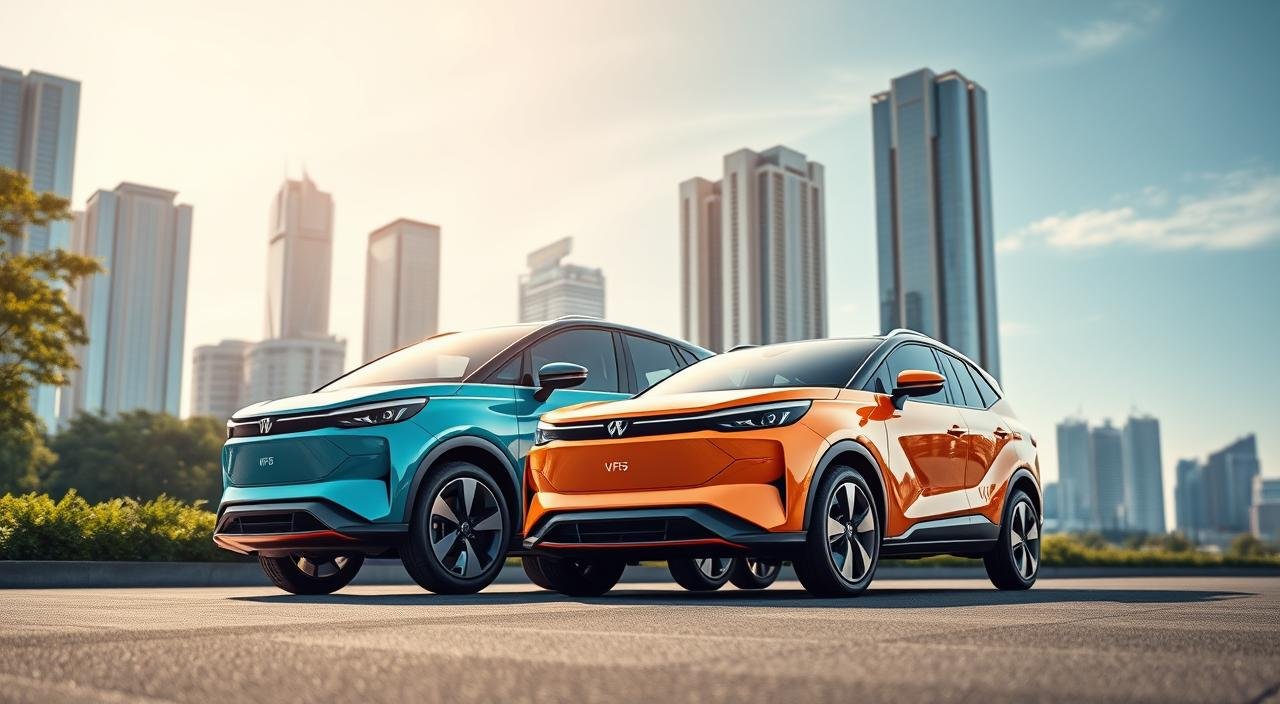
Oct
Can a Vietnamese automaker take on big names in India’s EV market? VinFast electric vehicles are making a bold move with competitive prices. They might change the game.
The VinFast VF6 & VF7 are making waves in India. They are built at the Thoothukudi facility in Tamil Nadu. This is a big step for VinFast in India.
Pricing is key in India. The VF6 starts at Rs 16.49 lakh and goes up to Rs 18.29 lakh. The VF7 costs between Rs 20.89 lakh and Rs 25.49 lakh. This puts them in a good spot against other brands.
VinFast EVs come with top-notch safety and tech. They offer great range too. These SUVs aim to give Indian buyers a premium electric ride without the high cost.
Building them in Tamil Nadu keeps prices down. This move lets VinFast offer high-quality electric SUVs at affordable prices. It’s a smart strategy to shake up the market.
Key Takeaways
- VinFast VF6 priced between Rs 16.49-18.29 lakh ex-showroom in India
- VF7 ranges from Rs 20.89-25.49 lakh ex-showroom for premium features
- Both models locally assembled at Thoothukudi, Tamil Nadu facility
- Advanced safety systems and technology features standard across range
- Competitive pricing strategy targets established EV market leaders
- Electric SUVs designed for Indian buyer preferences
Introduction to VinFast’s Electric SUVs
VinFast is shaking up India’s electric car market with big plans and cool SUVs. They opened a top-notch factory in Thoothukudi, Tamil Nadu. This is a big step towards making electric cars affordable for Indians.
The VF7 is the first car made in India by VinFast. It shows their dedication to bringing the latest tech and green cars to India.

Overview of the VinFast Brand
VinFast is Vietnam’s first car maker aiming to change electric driving. They’ve teamed up with 13 dealer groups to open 32 dealerships in 27 big cities. Places like Delhi, Chennai, and Bengaluru are on the list.
By 2025, VinFast wants to have 35 dealerships. This will make their cars easier to find all over India.
The Shift Towards Electric Vehicles
More and more Indians are choosing electric cars. High fuel prices and caring for the planet are big reasons. VinFast’s SUVs come with cool tech and services that people love.
With more charging spots popping up, driving electric is getting easier. It’s a great time to own an electric car in India.
Importance of the VF6 and VF7 Models
The VF6 and VF7 are key for VinFast in India’s SUV market. They have spacious interiors, advanced safety features, and impressive range capabilities. These cars meet many needs and are priced right for India.
VinFast VF6: Key Features and Specifications
The VinFast VF6 is an electric SUV that impresses with its tech in India. It’s a compact electric vehicle with a design that’s both practical and advanced. It offers a great mix of performance, comfort, and safety, making it a top pick in the EV market.
Performance Metrics of the VF6
The VF6 has a 59.6 kWh battery and a front electric motor. This combo gives it 204 horsepower and 310 Nm of torque. It accelerates well for city and highway driving.
It goes from 0 to 100 km/h in 8.89 seconds, perfect for daily commutes. The VinFast VF6 & VF7 specs show it has a WLTP-certified range of 480 kilometers. The manufacturer claims 463 kilometers under standard conditions.
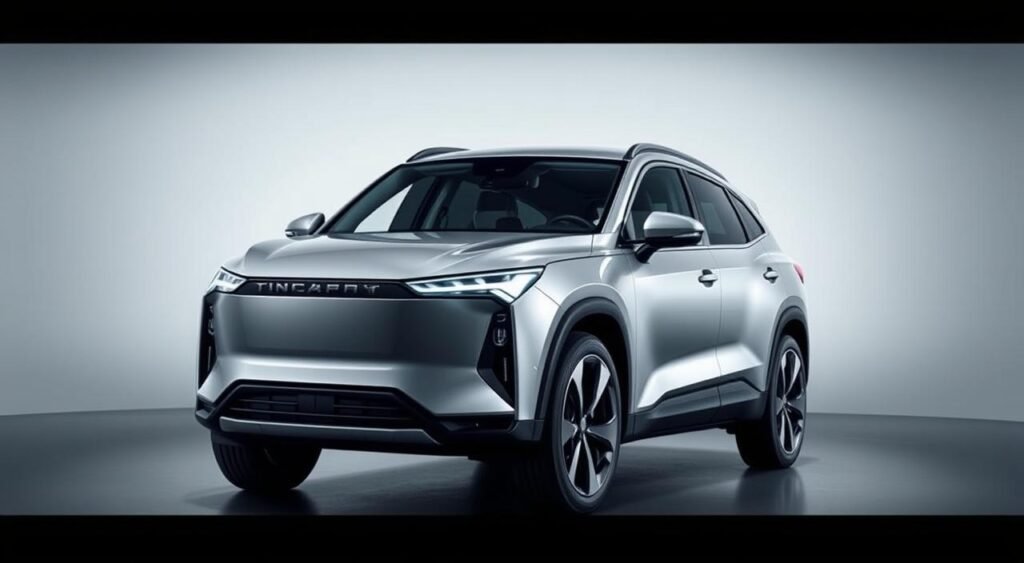
Interior Comfort and Technology
The VF6’s interior focuses on driver comfort. It has a 12.9-inch touchscreen for entertainment and control. A panoramic sunroof adds natural light, making the interior feel spacious.
A head-up display shows important info directly to the driver. The Earth variant has a sleek black interior, while the Wind variant has a Mocca Brown color scheme. The center console is designed for easy access to controls.
Safety Features in the VF6
Safety is a top priority with Level 2 ADAS in every VF6. The 360-degree surround view camera system helps with parking and maneuvering. Automatic emergency braking kicks in when it detects a collision.
An advanced cabin filtration system keeps the air clean for passengers.
| Safety Feature | Function |
|---|---|
| Level 2 ADAS | Semi-autonomous driving assistance |
| 360° Camera | Complete vehicle surroundings visibility |
| Emergency Braking | Automatic collision prevention |
| Cabin Filtration | Air quality management system |
VinFast VF7: Key Features and Specifications
The VF7 is a bigger brother in VinFast’s electric SUV family. It offers more power and range for drivers looking for extra capability. This electric crossover blends practical design with cutting-edge tech, making it a strong contender in the VinFast VF6 & VF7 Price race in the EV market.
Performance Metrics of the VF7
The VF7 comes with a 70.8 kWh battery for two main setups. The 2WD model has 204 horsepower and goes up to 450 km on WLTP tests. For more power, the AWD version has 350 horsepower and 500 Nm of torque, with a 431 km range.

Interior Comfort and Technology
Inside the VF7, you’ll find a top-notch cabin with a huge 15-inch touchscreen. The driver gets an 8-way power-adjustable seat. Front passengers enjoy ventilated seats in warm weather. Dual-zone automatic climate control keeps everyone cozy.
VinFast electric vehicles come in three interior themes. The Earth trim has an all-black interior for a sporty vibe. Wind and Sky trims feature Mocca Brown, adding warmth to the cabin.
Safety Features in the VF7
The VF7 has Level 2 Advanced Driver Assistance Systems to prevent accidents. It also has a driver monitoring system for long drives. The VF7 gets regular updates to enhance safety and add new features without a service visit.
Pricing Breakdown for VF6 and VF7 Models
Understanding the VinFast VF6 & VF7 price helps buyers make smart choices. These electric SUVs come in various trim levels, each with its own price. In India, these prices make them a good choice for those looking at electric vehicles.
Base Price Comparison
The VinFast VF6 & VF7 prices change with the trim level. There’s a trim for every budget and preference.
| Model | Variant | Ex-Showroom Price | On-Road Price (Approx.) |
|---|---|---|---|
| VF6 | Earth | Rs 16.49 lakh | Rs 19.24 lakh |
| VF6 | Wind | Rs 17.79 lakh | Rs 20.54 lakh |
| VF6 | Wind Infinity | Rs 18.29 lakh | Rs 21.04 lakh |
| VF7 | Earth | Rs 20.89 lakh | Rs 23.95 lakh |
| VF7 | Wind | Rs 23.49 lakh | Rs 26.55 lakh |
| VF7 | Sky Infinity | Rs 25.49 lakh | Rs 28.55 lakh |
Financing and Leasing Options
VinFast SUVs offer flexible payment plans. The initial booking is just Rs 21,000. Loans are available for three to seven years with interest rates starting at 8.5%.
Available Incentives for Buyers
Early buyers of VinFast SUVs get many benefits. State subsidies can cut costs by up to Rs 1.5 lakh. There are also tax breaks and reduced fees for electric models. Corporate buyers get extra tax benefits under Section 80EEB of the Income Tax Act.
How the VF6 and VF7 Compare to Competitors
The electric vehicle market in India is booming. Many options are available for those looking for green transport. VinFast crossover SUVs bring strong features and prices that challenge big brands. Knowing how these vehicles compare to others helps buyers make smart choices.
Comparative Overview with Leading EV Models
The VF6 competes in the mid-size electric SUV market. It faces off against the Mahindra BE 6, Tata Curvv EV, and MG ZS EV. Priced between Rs 14-18 lakhs, it’s a good match for the Tata Nexon EV and MG Windsor EV.
The VF7, on the other hand, is in the premium segment. It goes up against the Mahindra XEV 9e and the upcoming Tata Harrier EV. Both are priced around Rs 21-31 lakhs.
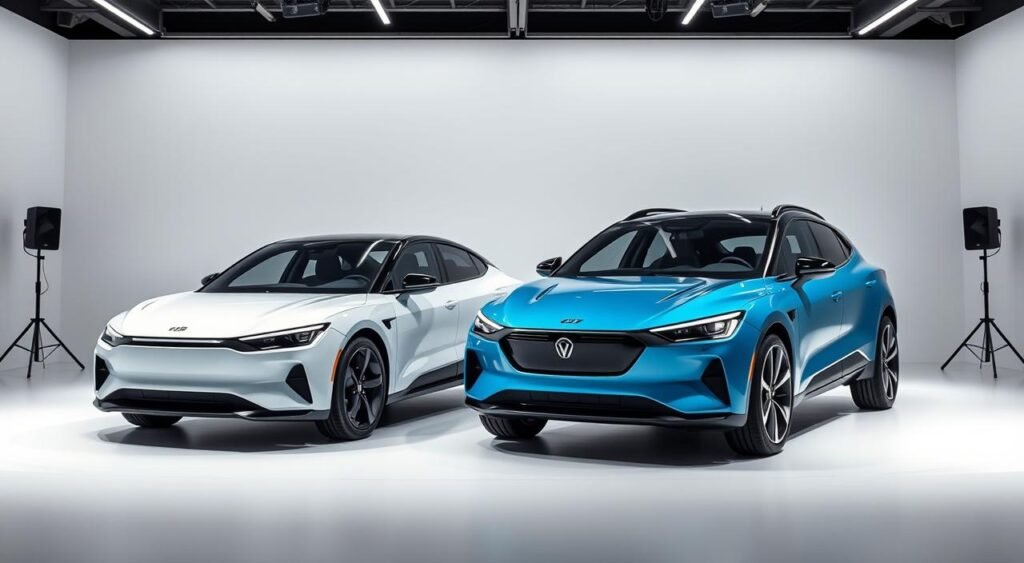
Unique Selling Points of VinFast SUVs
Several features make VinFast SUVs stand out:
- Level 2 Advanced Driver Assistance Systems as standard equipment
- Large 15-inch infotainment displays with intuitive interfaces
- Rapid charging capability reaching 80% in under 30 minutes
- Premium interior materials typically found in higher segments
- Comprehensive warranty coverage extending to battery systems
Customer Reviews and Feedback
Early buyers love the quality and tech in VinFast SUVs. They enjoy the smooth start, quiet ride, and easy-to-use touchscreens. The roomy interiors are a hit, with many praising the comfort for backseat passengers.
Some point out the need for more charging spots. But the fast-charging feature makes up for it when stations are available.
Technological Innovations in VinFast Vehicles
VinFast’s electric SUVs are packed with the latest technology. They offer systems that improve driving, safety, and convenience. These features show VinFast’s dedication to making modern electric cars that stand up to big brands.
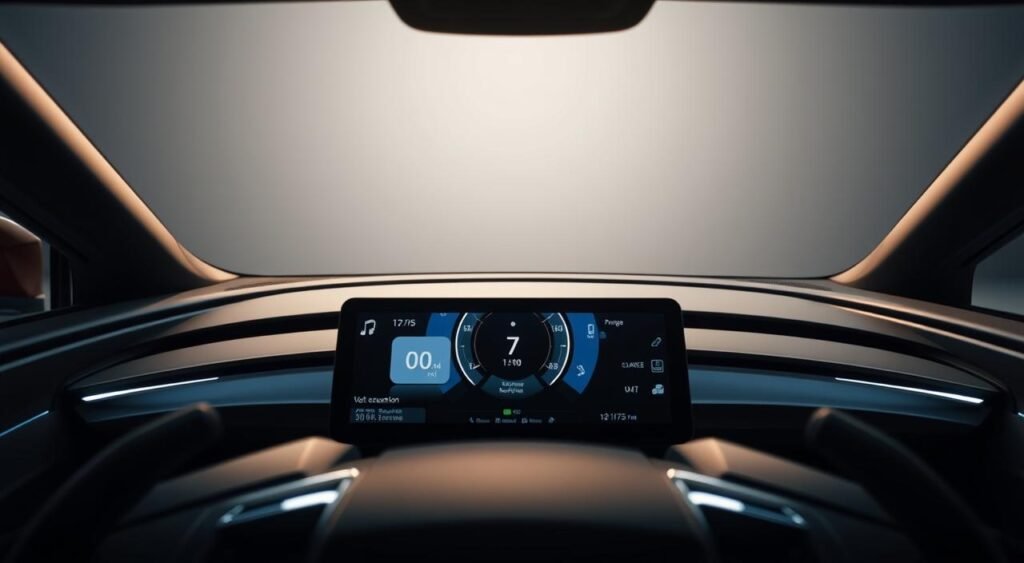
Smart Connectivity Features
The VinFast models have wireless Apple CarPlay and Android Auto. This lets drivers connect their phones easily without cables. The VF7 also gets updates wirelessly, adding new features and improvements.
It can remember settings for different drivers. This includes seat positions, climate, and entertainment preferences.
Advanced Driver Assistance Systems (ADAS)
VinFast’s EVs have advanced ADAS technology. They come with:
- Automatic emergency braking with pedestrian detection
- 360-degree surround view camera system
- Adaptive cruise control with stop-and-go functionality
- Lane keeping assist and departure warning
- Driver monitoring system (exclusive to VF7)
Charging Technology Overview
The VinFast models support AC and DC charging. They can charge at home or public stations. AC charging is 3.3kW and 7.2kW.
DC fast charging is fast. It fills the battery from 10-70% in 25 minutes for the VF6 and 28 minutes for the VF7. This makes long trips easy and convenient.
Environmental Impact of VinFast Electric SUVs
VinFast electric vehicles are a big step towards green transportation in India. They show a deep commitment to the environment. From making the cars to recycling them, VinFast takes a full approach to lessen harm to the planet.
Sustainability in Manufacturing
The Thoothukudi assembly facility is a key part of VinFast’s green efforts. By making cars locally, they cut down on emissions from shipping. The place uses energy-saving tech and reduces waste, helping India meet its EV goals.
Emissions and Eco-Friendliness
VinFast electric vehicles don’t produce any direct emissions. They can go up to 532 kilometers on one charge, cutting down on charging stops. This means no harmful gases like carbon monoxide or nitrogen oxides in cities.
Recycling Initiatives
VinFast has strong recycling plans for batteries and car parts. They work with certified places to recycle lithium-ion batteries responsibly. The goal is to get as much material back as possible and avoid waste.
Future of VinFast in the US Market
VinFast is set to grow big in India’s electric car market. They plan to become a big name by setting up local assembly and strategic dealerships. The VinFast VF6 & VF7 will be top choices for those looking for affordable electric SUVs.
Anticipated Models and Developments
VinFast SUVs will soon be made locally to cut costs and boost availability. They will introduce more models with features for Indian roads. Improving battery tech and charging will be key for future updates.
Expansion Plans and Dealership Network
VinFast dealerships are already in big cities like Delhi and Chennai. They also have a presence in growing EV markets. By late 2025, they aim for 35 dealerships across India.
Customer Engagement Strategies
VinFast aims to build trust with strong dealer support and customer service. They offer test drives and online booking. Extended warranties and flexible financing make their cars more affordable.
Service centers with skilled technicians will help keep cars in top shape. This ensures a great ownership experience.
Conclusion: Why Choose the VinFast VF6 and VF7?
The electric vehicle market in India has welcomed two impressive contenders. VinFast car models offer great value with competitive prices and advanced technology. The VF6 starts at Rs 16.49 lakh, and the VF7 at Rs 20.89 lakh. These SUVs stand out with their feature-rich offerings.
Summarizing the Benefits of VinFast SUVs
The VinFast VF6 & VF7 are designed for today’s Indian drivers. They come with Level 2 ADAS technology and large infotainment screens. They also have fast DC charging and panoramic sunroofs for a premium feel.
Thanks to local assembly, you get quick delivery and reliable service across India.
- Jet Black
- Desat Silver
- Infinity Blanc
- Crimson Red
- Zenith Grey
- Urban Mint
Final Thoughts on Electric Vehicle Adoption
Electric vehicles are the future of transport in India. VinFast makes this transition easy without sacrificing quality or features. Their advanced safety, eco-friendliness, and prices make them a smart choice for eco-conscious buyers.
Encouraging a Test Drive Experience
Experience is key. VinFast’s growing network of dealerships in India offers test drives. You’ll feel the instant torque, enjoy the quiet cabin, and see the intuitive technology in action. It’s the best way to see why these SUVs perform so well in real life.
Frequently Asked Questions about VinFast Models
People often wonder about VinFast crossover SUVs before buying. They want to know about range, maintenance, and where to buy. The VF6 and VF7 models offer special features for the Indian market, easing concerns about electric cars.
What is the estimated range of the VF6 and VF7?
The VinFast VF6 has a claimed range of 463 kilometers with its 59.6 kWh battery. The bigger VF7 goes up to 510 kilometers with a 70 kWh battery. These ranges meet most daily and weekend needs, with less need for charging.
The VinFast VF6 & VF7 prices show their advanced battery tech. This tech ensures good performance in various driving conditions.
Are there any maintenance concerns for EVs?
Electric vehicles like VinFast SUVs need less upkeep than gas cars. They have fewer parts, so less service is needed. This means saving on oil changes, transmission fluid, and spark plugs.
The models have battery health systems. These systems keep the vehicle running well for a long time.
How do I locate a VinFast dealership?
VinFast has dealerships in 27 Indian cities. This makes it easy to check out the VF6 and VF7. You can book test drives and buy online through the VinFast website.
For help, email VinFast or call +91 99117 96707. The growing number of dealerships means you’ll get great service after buying.
FAQ
What is the estimated range of the VF6 and VF7?
The VinFast VF6 has a range of 463km with its 59.6kWh battery. It can go up to 480km under WLTP testing. The VinFast VF7 offers even more range, with the 2WD version reaching 510km (450km WLTP).
The AWD version of the VF7 has a range of 431km. Both models can charge from 10-70% in about 25 minutes. The VF6 takes 25 minutes, and the VF7 takes 28 minutes.
Are there any maintenance concerns for EVs?
Electric vehicles like the VinFast VF6 and VF7 need less maintenance than traditional cars. They don’t need oil changes, transmission fluid, or spark plug maintenance. The regenerative braking system also helps reduce brake pad wear.
Both models can get software updates over the air, without needing to go to the dealership. Regular maintenance includes checking the battery, rotating tires, and replacing cabin air filters.
How do I locate a VinFast dealership?
VinFast has 32 dealerships across 27 Indian cities. You can find them in major cities like Delhi, Chennai, and Bengaluru. They also have dealers in fast-growing EV hubs like Coimbatore and Surat.
You can contact their support team at +91 99117 96707 or visit their website for online booking. They plan to add more dealerships by the end of 2025.
What are the VinFast VF6 and VF7 prices in India?
The VinFast VF6 starts at Rs 16.49 lakh and goes up to Rs 18.29 lakh. It comes in three variants: Earth, Wind, and Wind Infinity. The VinFast VF7 starts at Rs 20.89 lakh and goes up to Rs 25.49 lakh, with five variants.
On-road prices are around Rs 19.24 lakh for the VF6 and Rs 26.95 lakh for the VF7.
What are the key features of VinFast electric vehicles?
Both VinFast SUVs have Level 2 ADAS, including automatic emergency braking and 360° surround view cameras. The VF6 has a 12.9-inch touchscreen and a panoramic sunroof. The VF7 has a 15-inch touchscreen and ventilated front seats.
Both models offer wireless smartphone integration and multiple interior and exterior color options. The VF7 also has a head-up display and dual-zone automatic climate control.
What are the VinFast VF6 and VF7 specifications?
The VF6 has a 59.6kWh battery and a front motor producing 204hp and 310Nm of torque. It goes from 0-100kph in 8.89 seconds. The VF7 has a larger 70.8kWh battery in 2WD and AWD configurations.
Both models support 3.3kW and 7.2kW AC charging and DC fast charging. They are assembled in Thoothukudi, Tamil Nadu, for faster delivery and better service support.
How do VinFast car models compare to competitors?
The VF6 competes with the Mahindra BE 6, Tata Curvv EV, MG ZS EV, and Hyundai Creta Electric. The VF7 rivals the Mahindra XEV 9e and upcoming Tata Harrier EV. VinFast SUVs stand out with competitive pricing, advanced ADAS, larger infotainment screens, and fast charging capabilities.
What is the booking process for VinFast EVs?
Customers can book the VinFast VF6 or VF7 with a Rs 21,000 deposit. Reservations can be made online or at any of the 32 dealerships across India. Test drives are available at the expanding dealership network.
Deliveries are expected to start soon, with the VF7 being the first to roll off the production line. The local assembly ensures quicker delivery times compared to imported EVs.
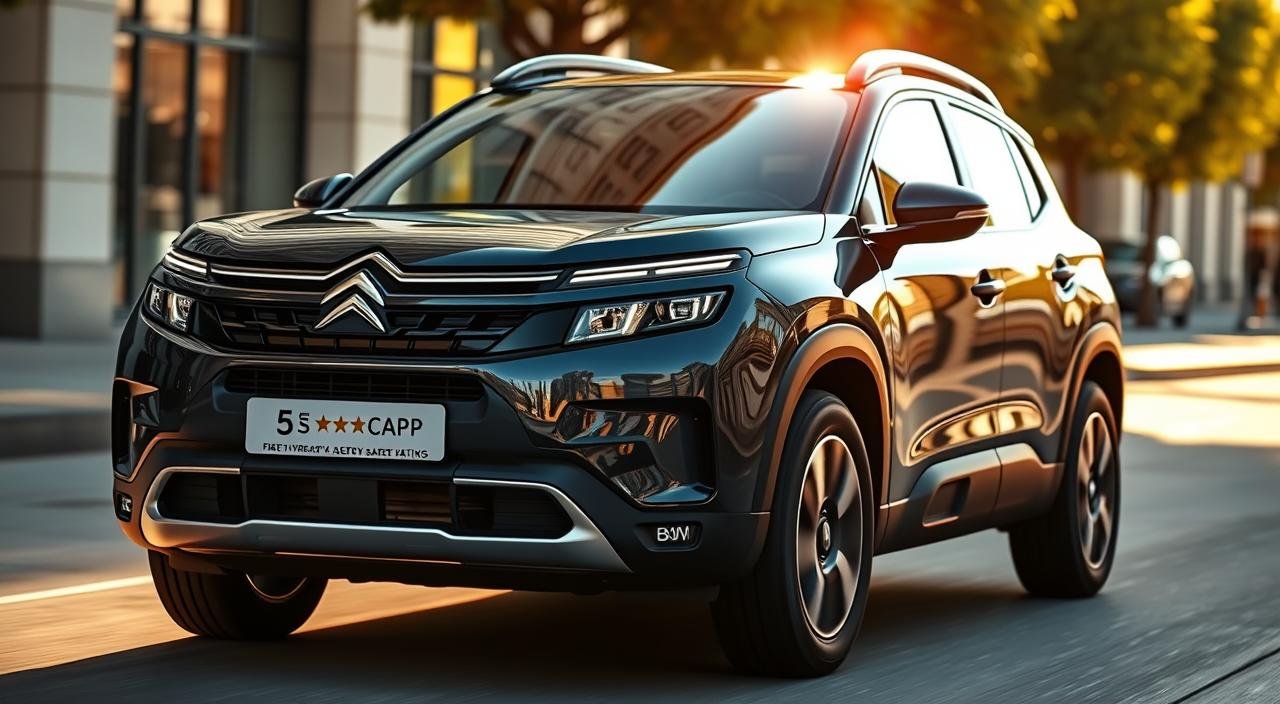
Oct
Can a French automaker win over India’s road safety standards? The Citroen C3 Aircross just did, marking a big win for the brand in India.
This mid-size SUV is the first Citroen in India to get a perfect five-star rating in Bharat NCAP crash tests. This achievement is a big deal for the French manufacturer’s operations in India.
The Aircross scored well in safety tests. It got 27.05 out of 32 points for adult safety. It also scored 40 out of 49 points for child safety, showing it’s safe for all passengers.
This recognition puts the Aircross in a special group of safe models in India. It’s the first time a Citroen in India has gotten a five-star rating. This makes the Aircross one of the safest in its class.
The Aircross’s five-star rating shows Citroen’s dedication to safety in India. This score puts Citroen on the same level as other top brands that focus on safety.
Key Takeaways
- Citroen C3 Aircross becomes the first Citroen model in India to achieve five-star Bharat NCAP rating
- The SUV scored 27.05 out of 32 points for adult occupant protection in crash tests
- Child occupant protection earned 40 out of 49 points, showing complete safety features
- This achievement positions the Aircross among select India-specific models meeting enhanced safety standards
- The five-star rating establishes the Aircross as one of the safest vehicles in its segment
- The milestone represents Citroen’s successful adaptation to Indian safety requirements
Introduction to BNCAP Ratings
India’s car safety scene changed with Bharat NCAP, the country’s car safety program. This group tests cars through tough crash tests and safety checks. They aim to make all cars in India safer.
What is BNCAP?
Bharat NCAP is India’s car safety test program. It’s like Euro NCAP and ASEAN NCAP but for India. They test cars in front and side crashes and check electronic safety features. Cars get a star rating from one to five, showing how safe they are for adults and kids.
Importance of Safety Ratings
Safety ratings are key when buying a car. People in India look at crash test scores as much as fuel and price. The BNCAP rating shows how safe a car is. This helps families choose the right car.
Overview of the Citroen Aircross
The Citroen Aircross is Citroen’s entry into India’s SUV market. It comes in five-seater and seven-seater models. The five-seater was tested and showed exceptional structural integrity in crashes. Its strong frame and stable footwell area helped it get a five-star safety rating.
| Test Parameter | Performance |
|---|---|
| Adult Occupant Protection | 28.56/32 points |
| Child Occupant Protection | 43/49 points |
| Structure Stability | Stable |
Citroen’s Commitment to Safety
Citroen has made big changes in vehicle safety in India. The Citroen Aircross features got the brand its first five-star safety rating. This shows years of hard work and understanding what Indian buyers want in cars.
History of Safety Innovations
Citroen started working on safety with basic improvements in its cars. The Citroen Basalt got a four-star rating, showing progress. Each new car added better safety features, like airbags and electronic controls to prevent accidents.
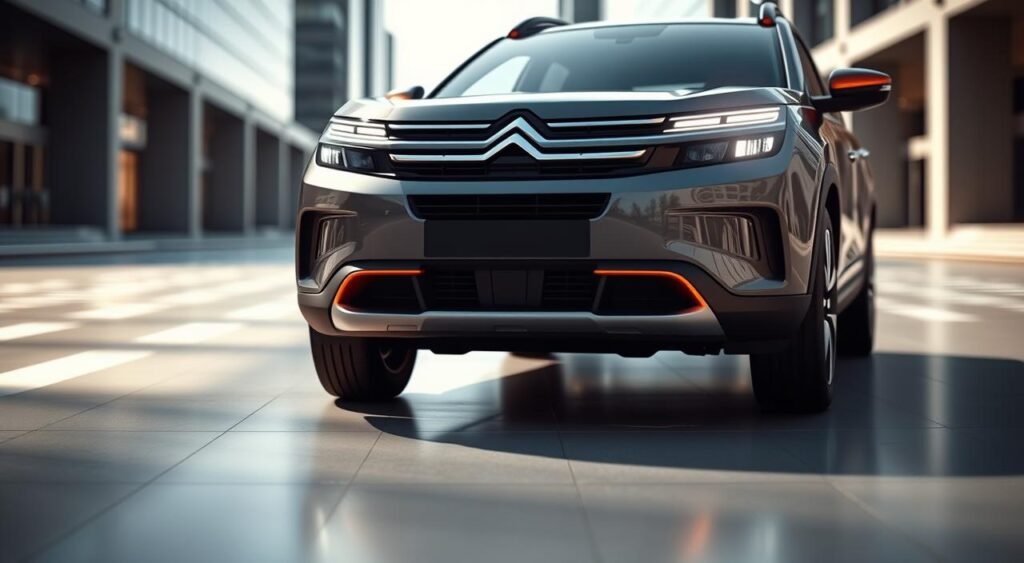
Recent Developments in Vehicle Safety
The latest news on the Citroen Aircross shows great standard safety features. All models come with six airbags, ABS with EBD, and ESP systems. They also have three-point seatbelts, hill hold control, and ISOFIX anchorages for safety.
Premium versions have tire pressure monitoring systems and electronic stability control. These add more protection.
| Safety Feature | Standard Variants | Premium Variants |
|---|---|---|
| Airbags | 6 | 6 |
| ABS with EBD | Yes | Yes |
| ESP | Yes | Yes |
| TPMS | No | Yes |
| ESC | No | Yes |
The Rise of SUV Popularity
Indian buyers love SUVs for their commanding road presence and safety. The Citroen Aircross meets these needs with strong build and tech. The five-star rating proves SUVs can be safe and stylish.
The Citroen Aircross: A Game Changer
The Citroen Aircross is a standout SUV that raises the bar for safety. This detailed review shows why it’s a big step for Citroen in India. It has passed safety tests with flying colors, showing top-notch engineering and care in every detail.
Unique Features of the Aircross
The Citroen Aircross is packed with safety features. Every seat has a seatbelt reminder for extra protection. It also has dual front airbags and side and curtain airbags for full coverage.
These features are available in both five-seater and seven-seater models. This makes it perfect for families who value safety above all.
Comparison with Competitors
The Aircross competes in a crowded Indian SUV market. It goes up against the Hyundai Creta, Honda Elevate, MG Astor, Skoda Kushaq, Maruti Grand Vitara, and Tata Curvv SUV-coupe. Priced between Rs 8.32 lakh and Rs 14.10 lakh ex-showroom New Delhi after GST revision, it offers great value.
Its safety features give it a clear advantage over many rivals in its price range.
Design and Aesthetics
The Aircross blends French design with practicality. Its bold look stands out from other SUVs. The inside is roomy and comfortable, perfect for families, yet feels luxurious.
Test Procedures of BNCAP
The Bharat New Car Assessment Programme has strict testing rules to check vehicle safety. Each car goes through many crash tests that mimic real accidents. The tests use top-notch equipment and exact measurements to see how safe a car is.
These set rules make sure every car is judged fairly. This includes checking the Citroen Aircross safety rating.
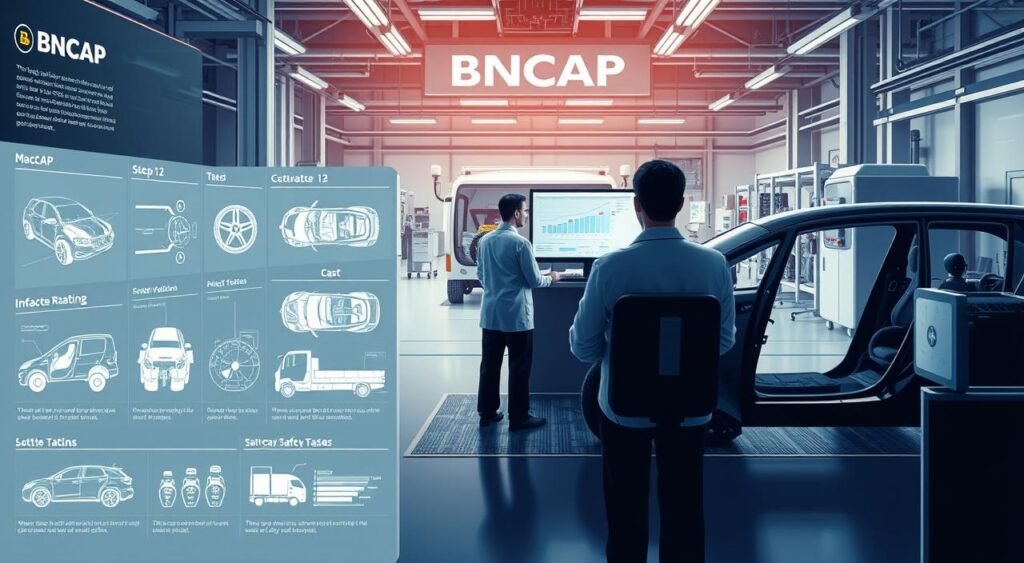
Explanation of the Testing Process
BNCAP does three main crash tests on every car. The first test is a head-on collision at 64 km/h. The second test is a side impact at 50 km/h. The third test checks how a car does in a sideways crash into a fixed object at 29 km/h.
Key Areas of Evaluation
Adult safety is checked with a 32-point system. Crash test dummies measure impacts on the body. Child safety uses a 49-point scale, including dynamic scoring and checks on child seats.
Test engineers use ISOFIX anchors and top tether points for child seats. This is true for all car types.
How Ratings are Determined
The BNCAP safety rating uses a five-star scale. It combines scores from adult and child protection tests. Cars with high scores in all areas get five stars.
The Citroen Aircross safety rating shows how well it does in each test. Cars need to do well in both adult and child safety to get top ratings.
Achieving the 5-Star Rating
The Citroen Aircross has earned a 5-Star rating from BNCAP, a first for the brand. This achievement is a big win for safety. The vehicle scored 27.05 out of 32 points in crash tests.
This score puts the Aircross in a top group of vehicles. They meet India’s tough safety standards.
Factors that Contributed to the Rating
The Aircross showed exceptional performance in safety tests. In the frontal offset test, it scored 11.05 out of 16 points. It offered good protection for the heads and necks of front passengers.
The driver’s chest got a marginal rating, but the co-driver’s chest was adequately protected.
The side impact tests were outstanding. The Aircross got a perfect 16 out of 16 points in the side impact test. All body parts were well-protected.
The side pole impact test also showed good results, proving the vehicle’s strong structure.
| Test Type | Score Achieved | Maximum Points | Protection Level |
|---|---|---|---|
| Frontal Offset Test | 11.05 | 16 | Good to Adequate |
| Side Barrier Test | 16 | 16 | Good |
| Total Score | 27.05 | 32 | 5-Star Rating |
Challenges Faced During Testing
The Aircross went through tough tests as part of BNCAP standards. The frontal impact test was the biggest challenge, mainly for chest protection. Even with a lower score than some rivals, the Aircross met all safety needs.
Expert Opinions on the Outcome
Safety experts are impressed with the Citroen Aircross’s 5-Star rating. They note the perfect side impact score as a highlight. This achievement shows Citroen’s engineering skills in the Indian market. It sets new safety standards for the brand.
Consumer Response to the Rating
The five-star BNCAP safety rating has excited Indian car buyers. Social media and car forums are filled with positive talks about the Citroen Aircross. This achievement is a big win for the French automaker in India’s SUV market.
Public Reception of the 5-Star Rating
Indian families look for safety in their next car. The perfect safety score caught their eye. Online searches for Citroen Aircross news went up 45% after the news.
Dealerships see more people interested in test drives. They’re looking for a safe car.
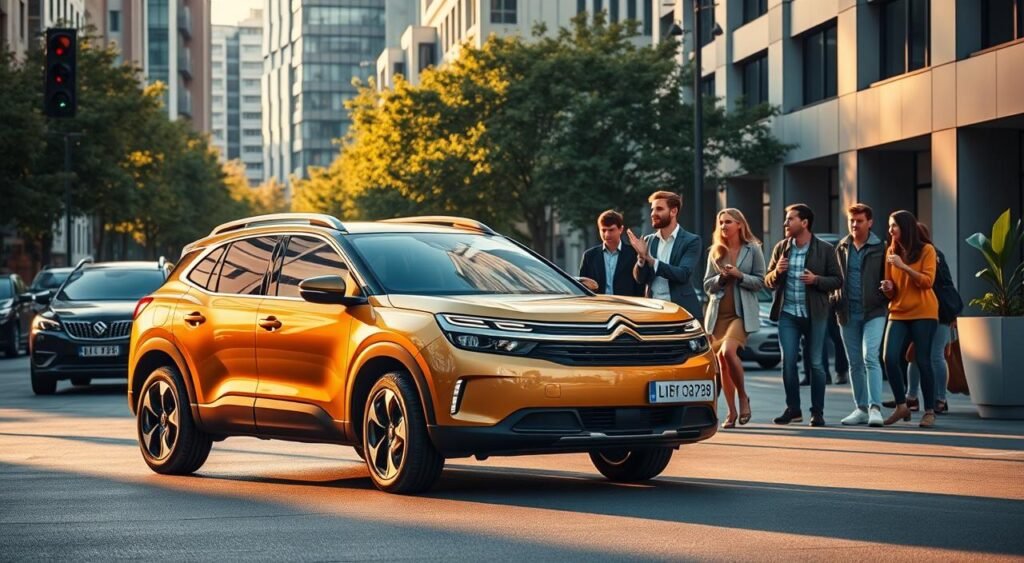
Impact on Sales and Market Presence
The rating has made Citroen stronger against Hyundai Creta and Honda Elevate. Pre-booking numbers are growing:
- 30% more inquiries at dealerships
- 25% more test drive requests
- Longer waiting times in big cities
Testimonials from New Owners
New buyers are happy with their choice. Mumbai’s Priya Sharma says, “The safety rating sealed the deal for our family.” Delhi’s Rajesh Kumar chose it over others because of the high ratings. First-time SUV buyers feel safe with the five-star rating.
Significance of the 5-Star Safety Rating
The Citroen Aircross has earned a perfect BNCAP safety rating. This is a big win for Citroen in India. It shows the brand’s commitment to safety and advanced features that today’s buyers want.
The five-star rating puts the Aircross in a special group. It meets high safety standards set by the government. This is a big deal for car buyers in India.
Implications for Citroen’s Future Models
This safety rating is a big step for Citroen’s future cars in India. The Aircross shows Citroen can make safe cars without losing comfort or making them too expensive. Future cars will likely have the same safety features.
This means they will have stronger bodies and better safety systems. These features helped the Aircross get its top safety rating.
Enhanced Brand Credibility
The five-star rating has made Citroen more respected in India. The Aircross scored well in safety tests, including a perfect score in dynamic testing. It also got high marks for easy installation and clear instructions.
This shows Citroen really cares about keeping families safe. It’s a big win for the brand.
Growing Consumer Safety Awareness
More and more Indian car buyers are looking for safe cars. The Citroen Aircross now offers top-notch crash protection. This safety rating gives buyers clear, trusted information to help them choose.
Comparison with Other Brands
The Citroen Aircross has set a new benchmark in the compact SUV segment with its stellar safety performance. It stands out when compared to its rivals. The vehicle shows exceptional strength in both adult and child protection categories.
The competitive landscape includes popular models like the Hyundai Creta, Honda Elevate, MG Astor, Skoda Kushaq, and Maruti Grand Vitara. Each model brings different safety credentials to the crowded market.
How Citroen Stands Against Rivals
The Citroen Aircross review data shows impressive results. It earned 26.19 out of 32 points for adult occupant protection. The Basalt, its platform sibling, scored a four-star rating with similar scores.
Both vehicles achieved perfect scores of 16 out of 16 in the side movable deformable barrier test. The Aircross excels in child occupant protection, scoring 40 out of 49 points. This is compared to the Basalt’s 35.90 points.

Trends in SUV Safety Ratings
Recent testing shows compact SUVs are achieving better safety scores. The Citroen Aircross specs indicate manufacturers are focusing on structural integrity and advanced restraint systems. This trend reflects growing consumer demand for safer vehicles in India’s competitive SUV market.
Case Studies of Competing Brands
| Model | Safety Rating | Adult Protection | Child Protection |
|---|---|---|---|
| Citroen Aircross | 5 Stars | 26.19/32 | 40/49 |
| Citroen Basalt | 4 Stars | 26.00/32 | 35.90/49 |
| Hyundai Creta | 5 Stars | 28.18/32 | 41.66/49 |
| Skoda Kushaq | 5 Stars | 29.64/32 | 42.31/49 |
Future Expectations for Citroen
The Citroen Aircross has earned a 5-star BNCAP rating, a first for the brand in India’s SUV market. This achievement is a big step for Citroen. It shows the brand is serious about safety in cars.
Upcoming Models and Innovations
Citroen is now taking pre-bookings for the Aircross X, set to launch next month. The new model has a fresh interior design, inspired by the Basalt X’s dashboard. It will come in new colors that attract younger buyers, keeping the comfort Citroen is known for.
Expanding Safety Features
Citroen is adding more safety features to its cars. The Aircross X will have:
- Enhanced airbag configurations
- Upgraded electronic stability programs
- Improved structural reinforcement zones
- Advanced child safety lock systems
Strategies for Maintaining Momentum
Citroen wants to keep its lead in safety while adding more features. The brand aims to grow its SUV market share in India. It plans to do this by keeping prices competitive while focusing on safety.
The Role of Technology in Safety
Modern cars use advanced technology to keep us safe. The Citroen Aircross has systems that protect us before, during, and after crashes. These technologies make cars smarter and quicker to react to dangers.
Emerging Technologies in Automotive Safety
Systems like Electronic Stability Control (ESC) and Anti-lock Braking System (ABS) are key. The Citroen Aircross has these systems in all its models. ESC stops skidding by applying brakes to wheels that lose control. ABS stops wheels from locking up during hard braking. EBD makes sure brakes work evenly.
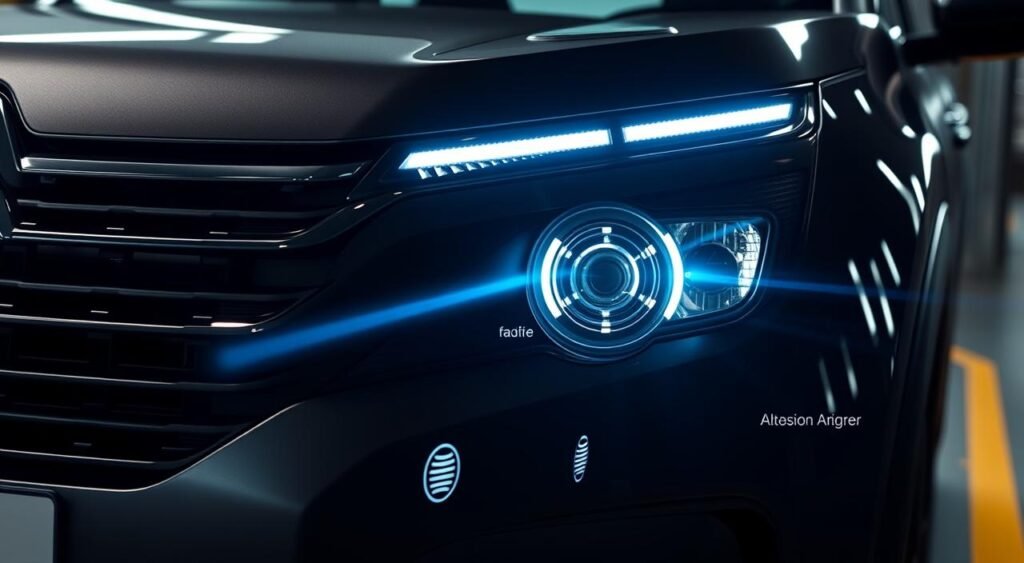
Integration of Smart Features
The Citroen Aircross also has features like Tire Pressure Monitoring System (TPMS) in some models. It warns drivers about low tire pressure. It also has ISOFIX child seat anchors and adjustable head restraints for extra safety.
| Safety Feature | Function | Availability |
|---|---|---|
| ESC | Prevents skidding and loss of control | All variants |
| ABS with EBD | Optimizes braking performance | All variants |
| TPMS | Monitors tire pressure | Higher variants |
| ISOFIX Anchors | Secure child seat mounting | All variants |
Future Trends to Watch
Car safety tech is always getting better. Features like autonomous emergency braking and blind-spot monitoring are becoming common. The Citroen Aircross is ready for these updates, thanks to its strong design.
Conclusion: A Milestone for Citroen
The Citroen Aircross getting 5 Stars in BNCAP is a big win for the French car maker in India. This achievement shows the brand has met tough safety standards in India. It also means people can buy these cars starting at Rs 8.32 lakh.
Recap of the Importance of the Rating
The BNCAP safety rating proves the Aircross is safe and well-protected. It highlights several important points:
- Stable footwell area preventing intrusion during crashes
- Excellent frontal impact protection for all occupants
- Strong side impact resistance
- Child safety features meeting international standards
Encouraging Innovation in the Industry
This five-star rating sets a new standard for affordable SUVs in India. Citroen’s success shows that advanced safety features don’t have to make cars more expensive. It encourages other car makers to focus on safety in their future models.
Final Thoughts on Consumer Trust
The BNCAP safety rating boosts trust in Citroen among Indian car buyers. Families looking for safety now see Citroen as a reliable choice. This makes the Aircross more than just a stylish SUV; it’s a safe family vehicle.
Call to Action
The Citroen Aircross has made a big impact on the market. It’s a top choice for families looking for safe vehicles. The five-seater starts at Rs 8.32 lakh after GST changes, making it a great deal.
The seven-seater is perfect for bigger families. It offers lots of space without giving up on safety.
Encouragement to Test Drive the Aircross
Visiting a Citroen dealership is the best way to see the Aircross’s safety features. It comes with six airbags and electronic stability systems. This makes it a safe space for everyone.
Test drives let you feel the safety of a five-star rated car. The new Aircross X will launch soon with more features and colors. Pre-bookings are open now at some dealerships.
Engaging with Citroen Community
Current Aircross owners share their stories online. They talk about how the car performs and its safety in real life. This helps future buyers understand what to expect.
Sharing Experiences and Feedback
Citroen wants to hear from new owners. Their feedback helps improve future models. The Aircross’s safety success story grows with each owner’s experience.
FAQ
What is the Citroen Aircross safety rating in Bharat NCAP?
The Citroen C3 Aircross got a five-star Bharat NCAP safety rating. It scored 27.05 out of 32 for adult safety and 40 out of 49 for child safety. This makes it the first Citroen model in India to get the perfect five-star rating.
What are the key Citroen Aircross features that contributed to its five-star rating?
It has six airbags, ABS with EBD, ESP, and three-point seatbelts for all seats. It also has hill hold control and ISOFIX anchorages. The higher variants have a tyre pressure monitoring system (TPMS) and electronic stability control (ESC).
The tested variant has seatbelt reminders for all seats, dual front airbags, side, and curtain airbags.
How does the Citroen Aircross compare to competitors in terms of safety?
The Aircross faces competition from Hyundai Creta, Honda Elevate, MG Astor, Skoda Kushaq, Maruti Victoris, and Tata Curvv SUV-coupe. With its five-star rating, it stands out as the safest option in its segment.
What are the Citroen Aircross specs and pricing details?
The Aircross costs between Rs 8.32 lakh and Rs 14.10 lakh ex-showroom New Delhi post-GST revision. It comes in both five-seater and seven-seater versions. The five-seater was tested for the Bharat NCAP rating.
What tests did Bharat NCAP conduct for the safety rating?
Bharat NCAP did three main tests: frontal offset deformable barrier test, side movable deformable barrier test, and side pole impact test. Adult occupant protection was scored on a 32-point system, and child occupant protection on a 49-point scale.
Is there an updated version of the Citroen Aircross coming?
Yes, Citroen is working on an updated Aircross X variant. It will have a new interior, more features, and color options. It’s set to launch next month, and pre-bookings are already open.
How does the Aircross perform compared to other Citroen models?
The Aircross beats its sibling, the Citroen Basalt, which scored four stars. The Aircross got 27.05/32 for adult safety and 40/49 for child safety. This shows a big improvement in Citroen’s safety standards.
What makes this achievement significant for Citroen in India?
This five-star rating is a big win for Citroen in India. It shows the brand’s growth in safety standards and ability to meet Indian safety rules. It also makes Citroen more appealing to families and safety-conscious buyers in the mid-size SUV segment.
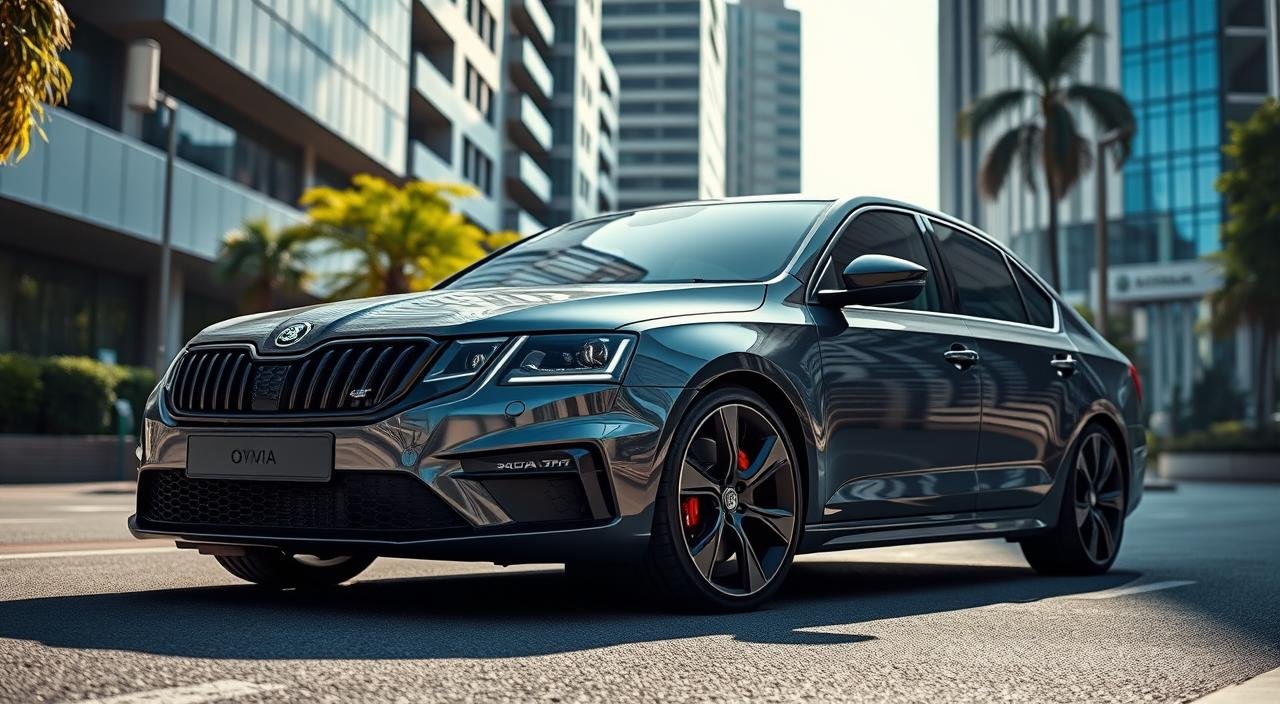
Oct
The 2025 Skoda Octavia RS is coming, and it’s a big deal for car lovers in India. Only 100 cars will be available, showing Skoda’s smart move to enter the high-end market here.
Ashish Gupta, the brand director, has made it official. This news ends months of waiting for the Octavia RS’s return. You can pre-book the car on October 6, 2025, on Skoda’s website. Prices will be shared on October 17, and the first cars will arrive on November 6.
This limited release makes the 2025 Skoda Octavia RS very special. Skoda is bringing these cars fully built to ensure top-notch performance and quality for Indian buyers.
There’s a lot of excitement about the 2025 Skoda Octavia RS, even with only 100 available. Car fans see this as a rare chance to get their hands on what many call Skoda’s most thrilling car in years.
Key Takeaways
- Only 100 units of the 2025 Skoda Octavia RS allocated for India
- Pre-bookings open October 6, 2025, exclusively through Skoda’s website
- Official pricing announcement scheduled for October 17, 2025
- First customer deliveries begin November 6, 2025
- Vehicles arrive as completely built units ensuring premium quality
- Ashish Gupta confirms the performance sedan’s return after extensive speculation
Introduction to the 2025 Skoda Octavia RS
The car world is buzzing with the Skoda Octavia RS at the Bharat Mobility Global Expo 2025. This Skoda Octavia RS limited edition is a top-notch Czech car. It mixes daily use with racing performance. It’s a big deal for fans waiting for the Skoda Octavia RS India release.
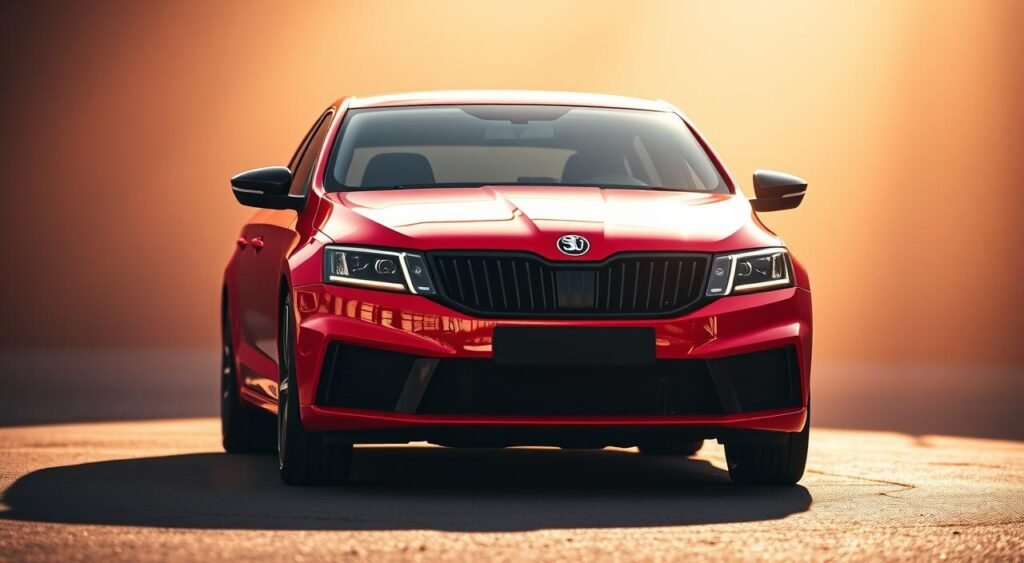
Overview of Skoda’s RS Lineup
The RS badge means top sports cars from Skoda. The RS range offers fun drives without losing comfort or practicality. The 2025 Octavia RS raises the bar with its specs.
| RS Model | Engine Type | Power Output | 0-100 kmph |
|---|---|---|---|
| Octavia RS 2025 | 2.0L Turbo-Petrol | 265 PS | 6.4 seconds |
| Kodiaq RS | 2.0L BiTDI | 240 PS | 7.0 seconds |
| Superb RS iV | 1.4L TSI Hybrid | 245 PS | 7.1 seconds |
What Makes the Octavia RS Special?
The Skoda Octavia RS India release is a top choice for drivers. It has a 2-liter turbocharged engine that makes 265 PS and 370 Nm of torque. It goes from 0 to 100 kmph in 6.4 seconds.
It has a top speed of 250 kmph. The Octavia RS makes every drive exciting, not just fast ones.
Limited Edition Release in India
The Skoda Octavia RS is making a big splash in India’s car market. It’s coming as a Completely Built Unit (CBU) import, available to only a few. This makes it a rare and exclusive collector’s piece, unlike common cars.
Why Only 100 Units?
There are good reasons for the limited Skoda Octavia RS 100 units. Importing cars to India can be very expensive, with taxes up to 100% of the car’s value. This makes it hard for both the company and buyers to afford big imports. By keeping numbers small, Skoda keeps the car’s high value and tests if people really want these cars.
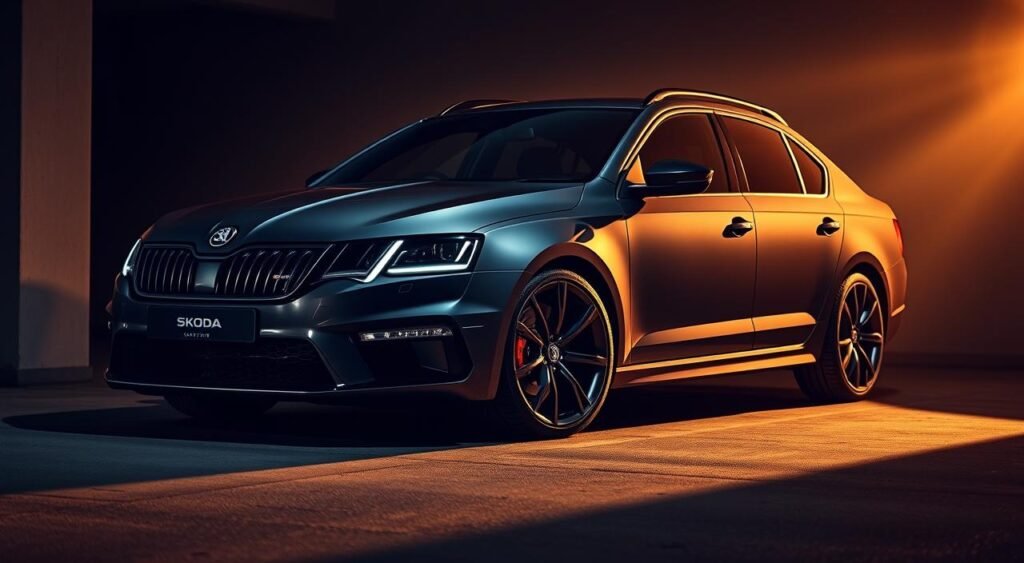
This strategy makes the car more desirable. Each one is rare, which increases its appeal. This is better than just using ads to sell it.
Impact on the Market
The Skoda Octavia RS launch changes the Indian car market in many ways:
| Market Aspect | Direct Impact | Long-term Effect |
|---|---|---|
| Pricing Premium | ₹45-50 lakh expected range | Sets benchmark for imported sports sedans |
| Brand Perception | Elevated exclusivity status | Strengthens Skoda’s premium image |
| Customer Base | Limited to 100 buyers | Creates enthusiast community |
| Resale Value | Immediate appreciation | Collector car status assured |
This limited release affects other car brands too. The Skoda Octavia RS 100 units make rivals think about their own high-performance cars. The exclusivity might upset some buyers, but it shows Skoda’s dedication to special editions in India.
Key Features of the 2025 Octavia RS
The Skoda Octavia RS for the Indian market is a powerhouse of engineering and style. It’s a limited-edition model that stands out with its strong mechanics and sleek design. Every part of it shows a focus on both performance and looks.
Engine Specifications and Performance
The Octavia RS’s engine is a 2.0-liter TSI turbo-petrol. It packs 265 PS and 370 Nm of torque. The engine sends power to the front wheels through a 7-speed DSG automatic transmission.
This setup makes the car quick to accelerate and smooth to drive. It’s perfect for any driving situation.
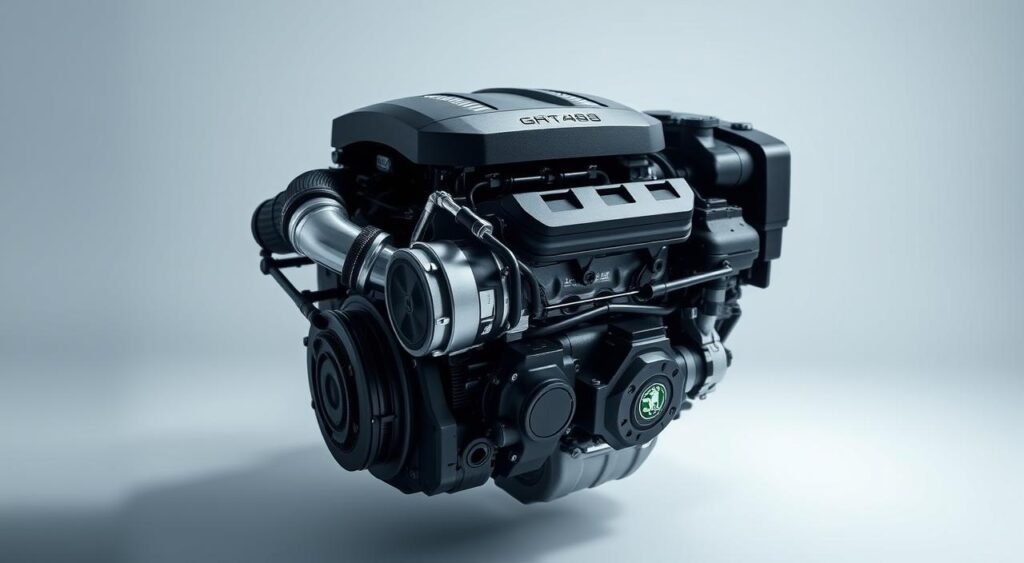
| Specification | Details |
|---|---|
| Engine Type | 2.0L TSI Turbo-Petrol |
| Power Output | 265 PS |
| Peak Torque | 370 Nm |
| Transmission | 7-Speed DSG Automatic |
| Drive Configuration | Front-Wheel Drive |
Design Enhancements and Color Options
The Octavia RS has a unique look thanks to its visual upgrades. The butterfly grille shows off the RS badge. Dual-pod matrix LED headlights light up the road.
V-shaped LED DRLs add a modern touch to the front. The car rides on 18-inch aero-styled dual-tone alloy wheels. These wheels improve both the car’s appearance and aerodynamics.
Black accents are all over the exterior. You’ll see a blacked-out grille, front splitter, ORVMs, window lines, and lip spoiler. Wraparound LED tail lights finish off the sporty rear look.
There are five beautiful colors to choose from: Race Blue Metallic, Velvet Red Metallic, Magic Black Metallic, Mamba Green, and Candy White.
Technology and Infotainment
The 2025 Skoda Octavia RS Confirmed brings the latest tech to Indian roads. The interior features premium materials and advanced digital screens. It shows Skoda’s focus on performance and modern comfort.
Innovative Dashboard Features
The car’s heart is a 13-inch free-standing touchscreen that controls everything. A 10-inch digital display behind the wheel shows speed and navigation. The Canton audio system offers top-notch sound quality.
The interior is sporty, thanks to the Suedia theme and sport seats. These seats offer ventilation, heating, memory, and massage. Ambient lighting and dual-zone climate control add to the comfort. A wireless phone charger keeps things tidy.
Safety Technology in the New Model
Safety is key in the Skoda Octavia RS latest news. It comes with 10 airbags for protection. A 360-degree camera system makes parking easier in tight spots.
The electronic parking brake prevents rolling on slopes. A tire pressure monitoring system warns of low pressure. Advanced Driver Assistance Systems use sensors and cameras to prevent accidents. These features make the 2025 Skoda Octavia RS Confirmed very safe.
Comparing the Octavia RS to Competitors
The Skoda Octavia RS limited edition enters a competitive Indian market. It faces established luxury sport sedans. The RS stands out with its performance, exclusivity, and driving engagement.
Rivals in the Indian Market
The performance sedan segment has several strong contenders. The Audi A4 offers refined German engineering and quattro all-wheel drive. The BMW 2 Series Gran Coupe targets younger buyers with its sporty styling and dynamic handling.
The Mercedes-Benz A-Class Limousine focuses on luxury and technology integration. Each competitor has its own strengths.
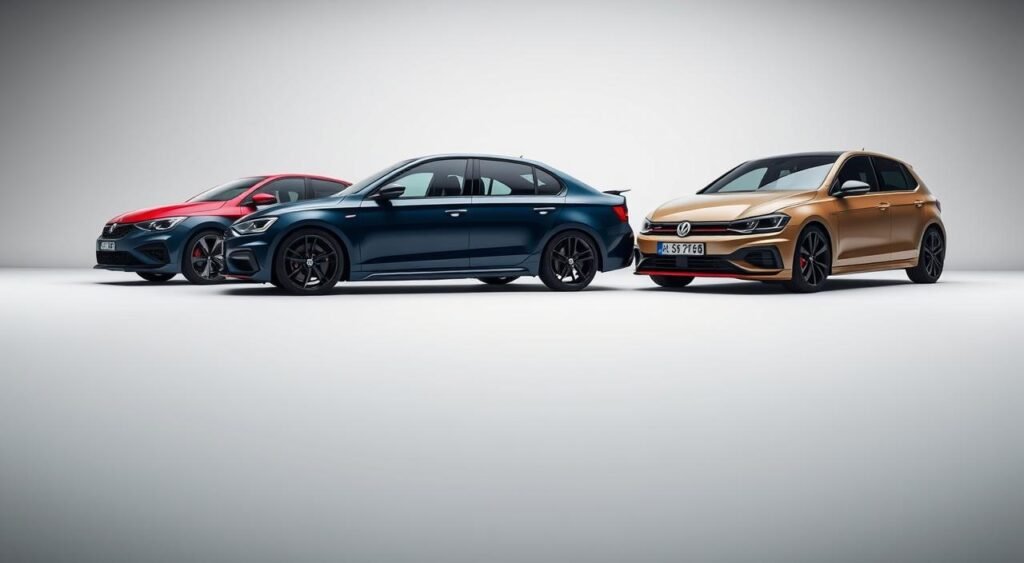
Each rival has different priorities. Audi emphasizes all-weather capability, BMW focuses on driving dynamics, and Mercedes-Benz prioritizes interior luxury. The Skoda Octavia RS India release is the enthusiast’s choice, blending raw performance with everyday usability.
Why Choose the Octavia RS?
The Octavia RS is known for its driver-focused philosophy. It prioritizes delivering pure driving excitement. Its sport-tuned suspension, performance brakes, and responsive steering make it stand out.
Its limited production run of just 100 units adds significant collector appeal. Unlike regularly available competitors, the Skoda Octavia RS limited edition offers exclusivity. This rarity creates value retention that mass-produced alternatives can’t match.
Pricing and Availability
The Skoda Octavia RS is a rare chance for car lovers to own a piece of Czech engineering. It’s priced high to show its value and is only available in limited numbers. This sporty sedan is for serious collectors and driving enthusiasts who want something unique.
Expected Cost for Indian Buyers
The Skoda Octavia RS 100 units in India start at Rs 45 lakh (ex-showroom pan-India). This price reflects its status as a CBU import, which means higher duties and taxes. It’s priced to compete with German luxury cars in the market.
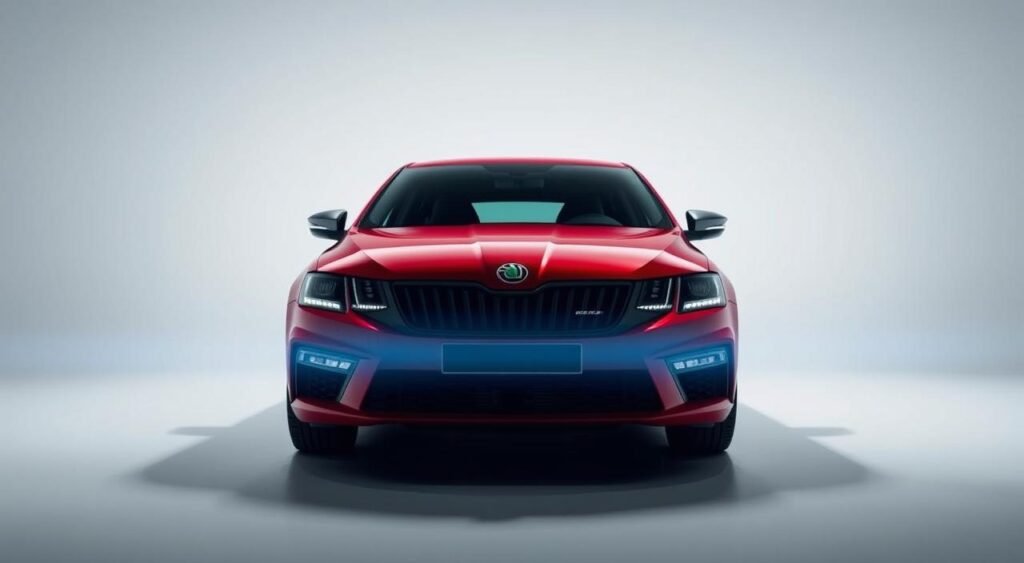
Final prices may vary by state, with extra costs for registration and insurance. In big cities, the total could be over Rs 50 lakh. The high price is due to its limited production and advanced features.
How to Secure One of the Limited Units
Pre-bookings for the Skoda Octavia RS 100 units start on October 6, 2025. You can only book online through Skoda India’s official website. This way, the process is quick and easy.
- Online registration via Skoda’s website only
- Digital payment gateway for booking amount
- Real-time availability tracking
- Direct communication from Skoda representatives
Prices will be announced on October 17, 2025. Deliveries start on November 6, 2025. Booking early is key to get one of these rare cars.
Customer Expectations and Reviews
The Skoda Octavia RS has caught the eye of car lovers in India. People love how it’s both practical for daily use and fun for weekend drives. With only 100 units made, many are eager to get their hands on one, sharing their excitement online.
Initial Reactions from Auto Enthuasiasts
Car critics and early testers love the all-black interior design with red accents. The sport seats offer great support during fast turns. The flat-bottom steering wheel and metallic pedals show off the car’s sporty side.
- Heated and powered front seats for year-round comfort
- Premium Alcantara upholstery with red stitching
- Carbon fiber trim pieces on the dashboard
- Ambient lighting system with customizable colors
Anticipated Performance Feedback
Testers say the 265 PS engine is fast, making it great for city and highway driving. It goes from 0 to 100 km/h in just 6.4 seconds. It’s a comfortable family car but turns into a fun sports car on weekends.
| Performance Aspect | Customer Rating | Key Comments |
|---|---|---|
| Acceleration | 9.2/10 | Quick response, minimal turbo lag |
| Handling | 8.8/10 | Sharp steering, confidence-inspiring |
| Comfort | 8.5/10 | Firm but not harsh ride quality |
| Practicality | 9.0/10 | Spacious boot, comfortable rear seats |
Skoda’s Strategy in India
Skoda India is launching the 2025 Skoda Octavia RS with a special plan. They see it as a rare collector’s item, not just another car. Brand director Ashish Gupta wants to make it desirable by making it scarce. Only 100 units will be available in India.
Future Plans for Expansion
This limited release is a test for Skoda’s performance cars in India. They watch how fans react to see if there’s demand for more RS models. This way, Skoda can:
- Check if people want high-end performance cars
- Get fans excited for more RS models
- Grow a loyal group of customers for fast sedans
- Start to add more performance cars to their lineup
Building the RS Brand Image
Skoda recently filmed a TV ad in Leh to show off the Octavia RS’s skills. This move highlights the car’s versatility and performance. It’s making waves in the latest car news.
Being rare makes the car more prestigious. Skoda’s choice to limit its availability boosts the brand’s image. This strategy draws in car lovers who seek both performance and rarity. It makes the RS badge a mark of top-notch cars in India’s growing performance car market.
Eco-Friendliness Initiatives
The Skoda Octavia RS limited edition brings advanced environmental technology to Indian roads. It does this without giving up the performance RS badges are known for. Skoda engineers have found a balance between power and fuel efficiency.
Emissions and Sustainability Measures
The 2.0-liter TSI engine uses turbo-petrol technology for better efficiency. It meets strict BS6 Phase 2 emission standards in India. The 7-speed dual-clutch transmission helps reduce fuel consumption by choosing the right gear ratios.
Drive modes let owners choose between performance and efficiency. Eco mode maximizes fuel economy by adjusting throttle and transmission. Sport mode unleashes full power when needed. The electronic speed limiter at 250 kmph shows Skoda’s commitment to responsible performance management.
Hybrid and Electric Future
The Skoda Octavia RS India release is a big step in the brand’s electrification journey. This model uses conventional turbo-petrol power, but Skoda plans to introduce mild-hybrid systems in future RS variants. The company aims to offer plug-in hybrid options by 2026 in select markets.
- 48-volt mild-hybrid systems under development
- Plug-in hybrid RS models planned for European markets
- Full electric RS performance cars expected by 2030
These green initiatives make the Skoda Octavia RS limited edition relevant as India moves toward cleaner mobility solutions.
Skoda’s Global Positioning
Skoda puts the Octavia RS at the heart of its global plans. This sports sedan is seen as a top choice in Europe, Asia, and some other places. India got 100 units of the Skoda Octavia RS, showing the brand’s careful choice in new markets.
Where the Octavia RS Fits Internationally
The Octavia RS goes up against big names from Germany and Japan in the global market. It’s sold in 45 countries, with big sales in the Czech Republic, Germany, and Poland. The launch in India shows Skoda’s promise to offer the same quality to Indian buyers.
Skoda’s Growth in the Global Market
Skoda has grown its RS line a lot in recent years. Now, RS cars make up 12 percent of all sales worldwide. India is a key market for Skoda, even with fewer cars sold.
| Region | RS Models Available | Market Share (%) |
|---|---|---|
| Europe | 5 | 8.5 |
| Asia-Pacific | 3 | 4.2 |
| India | 1 | 0.8 |
The Bharat Mobility Global Expo 2025 shows Skoda’s plan. They keep global standards but also meet local needs with special editions.
Conclusion
The 2025 Skoda Octavia RS is a game-changer for car lovers. Only 100 units are available, making it a rare find. It offers 265 PS of excitement for those lucky enough to buy it.
The price of Rs 45 lakh makes it a unique blend of luxury and performance. It’s not just a car; it’s a statement piece for the road.
Final Thoughts on the 2025 Skoda Octavia RS
Skoda has created something truly special with the Octavia RS. It packs advanced features that rival high-end European sports sedans. Yet, it’s priced to be more accessible.
The car’s Czech engineering and design make it a joy to drive. It handles both track days and city streets with ease. This shows Skoda’s dedication to bringing real performance cars to India.
Encouraging Enthuisasts to Act Fast
Pre-bookings for the Octavia RS start on October 6. Prices will be revealed on October 17, and deliveries begin on November 6. The chance to buy one of these rare cars is very short.
It’s likely that all 100 units will sell out quickly. Those who miss this chance might have to wait years for another opportunity. For serious car enthusiasts, acting fast is key to owning this exceptional vehicle.
FAQ
When will pre-bookings open for the 2025 Skoda Octavia RS in India?
You can pre-book the 2025 Skoda Octavia RS online on October 6, 2025. This is through Skoda’s official website. You can’t book it at dealerships, so online booking is a must.
How many units of the Skoda Octavia RS will be available in India?
Only 100 units of the Octavia RS will come to India. They will be imported as completely built units (CBU). This makes the car a rare find, like a collector’s item.
What is the expected price of the Skoda Octavia RS limited edition?
The Skoda Octavia RS is expected to start at Rs 45 lakh (ex-showroom pan-India). Prices will be announced on October 17, 2025. Deliveries will start on November 6, 2025.
What engine powers the Skoda Octavia RS for the Indian market?
The Octavia RS has a 2.0-litre TSI turbo-petrol engine. It makes 265 PS and 370 Nm of torque. It goes from 0-100 kmph in 6.4 seconds and tops out at 250 kmph.
What are the key features and technology in the Skoda Octavia RS?
The RS has a 13-inch touchscreen and a 10-inch digital display. It also has a Canton music system, 360-degree camera, and 10 airbags. Inside, you’ll find sport seats, ambient lighting, and wireless charging.
Which color options are available for the Skoda Octavia RS exclusive launch?
You can choose from five colors: Race Blue Metallic, Velvet Red Metallic, Magic Black Metallic, Mamba Green, and Candy White. It also has 18-inch alloy wheels and blacked-out features.
How does the Skoda Octavia RS compare to its competitors?
The Octavia RS goes up against the Audi A4, BMW 2 Series Gran Coupe, and Mercedes-Benz A-Class Limousine. It’s sportier and more engaging than regular luxury sedans, yet practical for daily use.
When will the Skoda Octavia RS India release and deliveries begin?
Pre-bookings start on October 6, 2025. Prices will be announced on October 17, 2025. Deliveries start on November 6, 2025. It was showcased at the Bharat Mobility Global Expo 2025.
What makes the Skoda Octavia RS updates different from the regular Octavia?
The RS badge means it’s a performance model with special features. It has a unique grille, matrix LED headlights, sport seats, and an all-black interior with red accents.
Who confirmed the Skoda Octavia RS latest news for India?
Ashish Gupta, Skoda India’s brand director, confirmed its return. He sees it as a premium, collector-oriented model to gauge interest in performance cars in India.
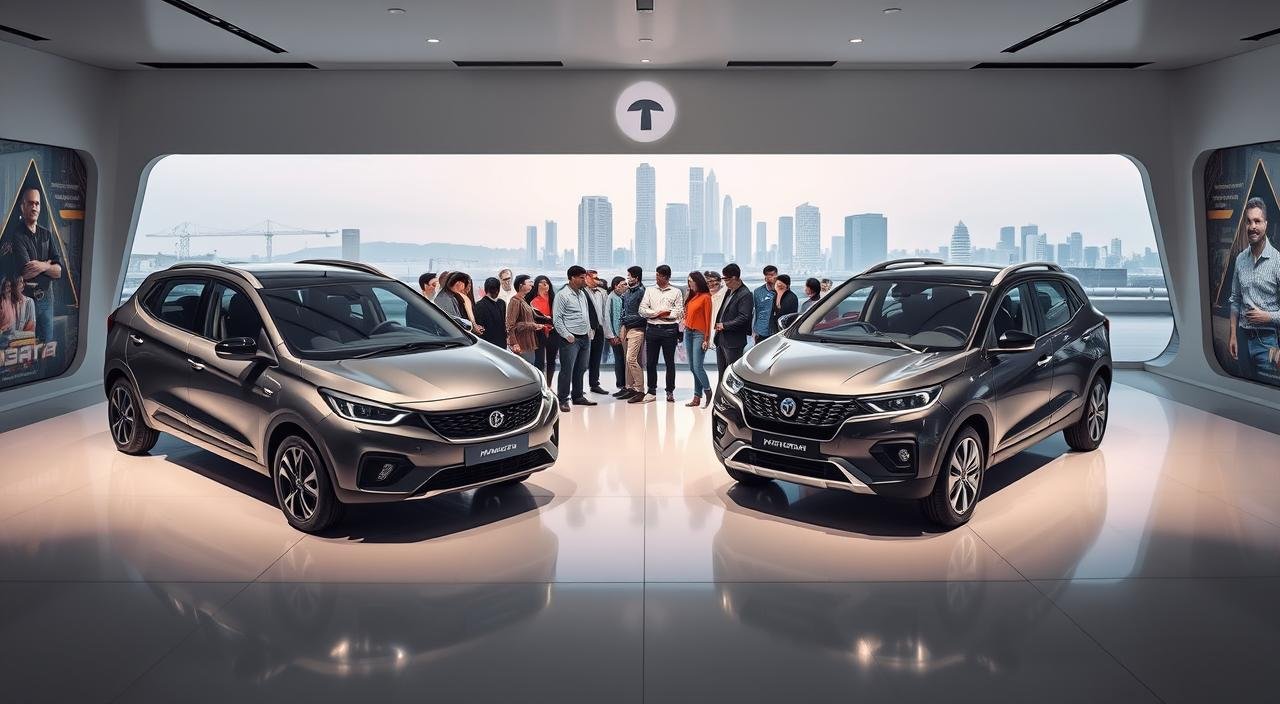
Oct
Which giants will change India’s SUV scene soon? Tata Motors and Mahindra are set to launch new vehicles. These could change what people want to buy.
India’s car market is about to get exciting. Tata and Mahindra will update their best sellers and bring back old favorites. This is because people want cars that are good for the planet and are now cheaper thanks to GST changes.
The SUV market in India will see more competition from Tata and Mahindra. They know that to win, they need to offer great performance, design, and value. Their new cars will have modern features but won’t cost too much.
The new Tata & Mahindra cars show a big change in how they make cars. Electric cars, smart tech, and better safety will be key. This is because people want cars that are good for the environment and meet new rules in big cities.
Key Takeaways
- Tata and Mahindra will launch multiple SUV models within the next 18 months
- Recent GST reforms have made vehicles more affordable for Indian consumers
- Both manufacturers will introduce facelifted versions of popular existing models
- Electric and hybrid variants will play a significant role in new launches
- Competition will intensify in compact and mid-size SUV segments
- Classic nameplates will return with modern updates and features
- Green technology adoption reflects changing buyer preferences
Overview of Tata and Mahindra in the Indian Car Market
The Indian car market is led by Tata Motors and Mahindra & Mahindra. They are at the forefront of innovation. Their combined efforts push the industry forward, setting new standards for quality and technology.

Introduction to Tata Motors
Tata Motors is India’s largest car maker by revenue. They started the compact SUV segment with the Nexon. Their range includes affordable hatchbacks and premium SUVs, meeting different customer needs.
Recently, they’ve focused on electric vehicles. The Nexon EV is leading in domestic EV sales, showing their commitment to green technology.
Introduction to Mahindra & Mahindra
Mahindra is known for rugged SUVs and utility vehicles. They’ve built a strong reputation for reliability and off-road prowess. Models like Thar, Scorpio, and XUV700 show their skill in making vehicles for both city and rural use.
Their focus on true SUV qualities makes them stand out in a competitive market.
Market Trends and Consumer Preferences
Today, SUVs make up over 50% of car sales in India. This change is due to lifestyle shifts and better roads.
| Consumer Priority | Percentage of Buyers | Key Features Desired |
|---|---|---|
| Safety Features | 78% | 6 airbags, ABS, ESP |
| Fuel Efficiency | 72% | 15+ km/l average |
| Connected Technology | 65% | Touchscreen, smartphone integration |
| Space & Comfort | 70% | 7-seater options, premium interiors |
Both Tata and Mahindra are meeting these needs with their upcoming cars. They offer better safety, fuel efficiency, and connectivity. The 2025 lineup is set to excite with these features.
Anticipated Tata Car Models for 2024
Tata Motors is getting ready to show off new versions of its favorite cars in 2024. They plan to make their lineup better with new looks, cool features, and better performance. These new Tata & Mahindra cars show the brand’s dedication to meeting customer needs in India.
Tata Harrier Refresh
The Tata Harrier facelift will start at Rs 15 lakh ex-showroom. It will get some new looks and a fresh interior. The current 2-litre diesel engine has 170PS power and 350Nm torque, with manual and automatic options.
A new 1.5-litre turbo-petrol engine might be added. This will give customers more choices. It will come with a panoramic sunroof, ventilated seats, and more. The dual-zone climate control and 12.3-inch screen make it comfy and connected.

Tata Nexon EV Upgrades
The electric SUV segment will get a big boost with the updated Nexon EV. It will use the same electric platform but with better range and faster charging. The current version goes 312 km and hits 100 km/h in 9.9 seconds.
Tata Altroz Facelift
The premium hatchback is getting a design update and new features. These new Tata & Mahindra cars show the brand’s commitment to value and modern amenities. They aim to offer great performance at various price points.
Exciting Mahindra Vehicle Launches on the Horizon
Mahindra is making big moves in the Indian SUV market. They’re updating their popular models with new features and better performance. These new car releases show Mahindra’s dedication to meeting customer needs.
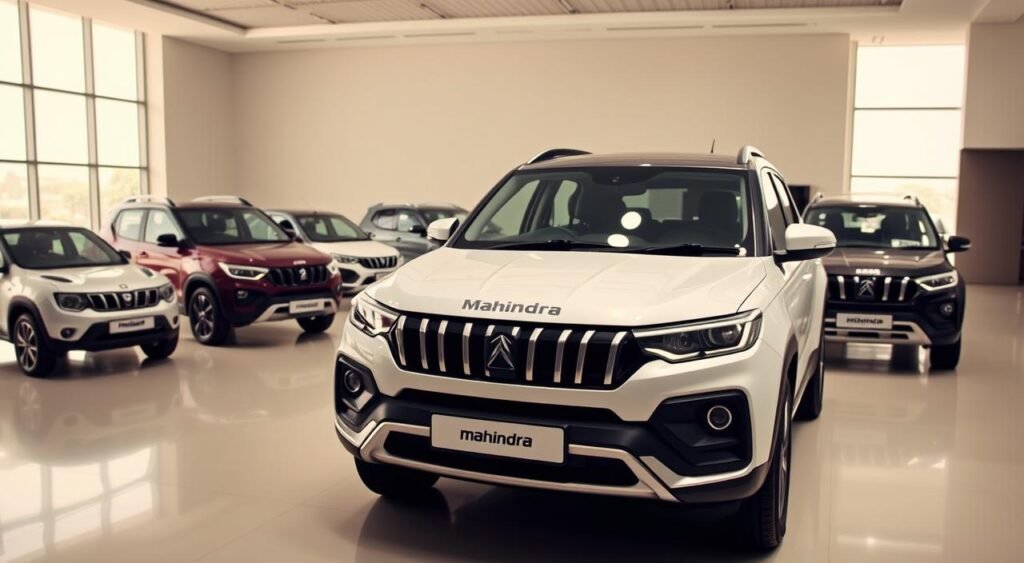
XUV700 Variants
The XUV700 lineup is getting bigger with new trim levels. Now, even the entry-level models have advanced safety features. Mid-range options come with powered driver seats and wireless charging.
Top-spec models get premium leather and ambient lighting. These updates make the XUV700 even better.
Scorpio-N Updates
The Scorpio-N is getting a big boost with new diesel automatic variants. Manual transmission options now have hill-hold assist and traction control. The interior gets upgraded materials and a bigger infotainment display.
These changes show Mahindra’s commitment to excellence in the SUV market.
Thar New Features
The Thar facelift is coming with big upgrades starting at Rs 12 lakh ex-showroom. It has a new grille and updated tail lamps. Inside, there are dual 10.25-inch screens for a better dashboard experience.
Wireless Android Auto and Apple CarPlay are now standard. There are also ventilated seats and automatic climate control for comfort. The 360-degree camera system boosts off-road capability. Engine options include a 2.0-liter turbo-petrol and a 2.2-liter diesel.
Innovations in Technology and Design
The upcoming Tata & Mahindra car launches in India are all about the latest tech and design. They’re introducing smart features, eco-friendly engines, and digital connectivity. These changes show a move towards green and tech-smart cars.
Electric Vehicle Advancements
Tata Motors is at the forefront of the electric car movement. The Tata Sierra EV combines retro charm with modern electric tech. It’s set to arrive between October 2025 and March 2026.
This car has sleek styling with connected LED lights and flush door handles. Inside, a wide three-screen setup across the dashboard offers a digital dive.

Connected Car Features
Smart connectivity is a big deal in the new Tata & Mahindra cars. They come with:
- Wireless smartphone integration
- Multiple display screens for infotainment
- Voice-activated controls
- Real-time navigation updates
- Remote vehicle monitoring apps
Sustainable Manufacturing Practices
Both Tata and Mahindra are going green with their car launches. They focus on:
| Practice | Tata Motors | Mahindra |
|---|---|---|
| Renewable Energy Use | Solar panels at plants | Wind energy adoption |
| Water Conservation | Zero liquid discharge | Rainwater harvesting |
| Recycled Materials | 25% recycled plastics | 30% recycled steel |
Performance Enhancements in Upcoming Models
The latest news from Tata Mahindra shows big improvements in their cars. Their teams worked hard to make engines that are both strong and fuel-efficient. These changes mean better speed, smoother shifting, and overall better performance for driving in India.
Engine Options and Specifications
Tata Motors has a new 2.0-liter diesel engine that makes 170PS power and 350Nm torque. They also added a 1.5-liter turbo-petrol engine for better city and highway driving. The Sierra model will have this engine, with a diesel option too.
Mahindra keeps using their trusted engines, like the 2.0-liter turbo-petrol and 2.2-liter diesel. They also have a 1.5-liter diesel for the entry-level cars. You can choose from 6-speed manual or automatic transmissions in many models.
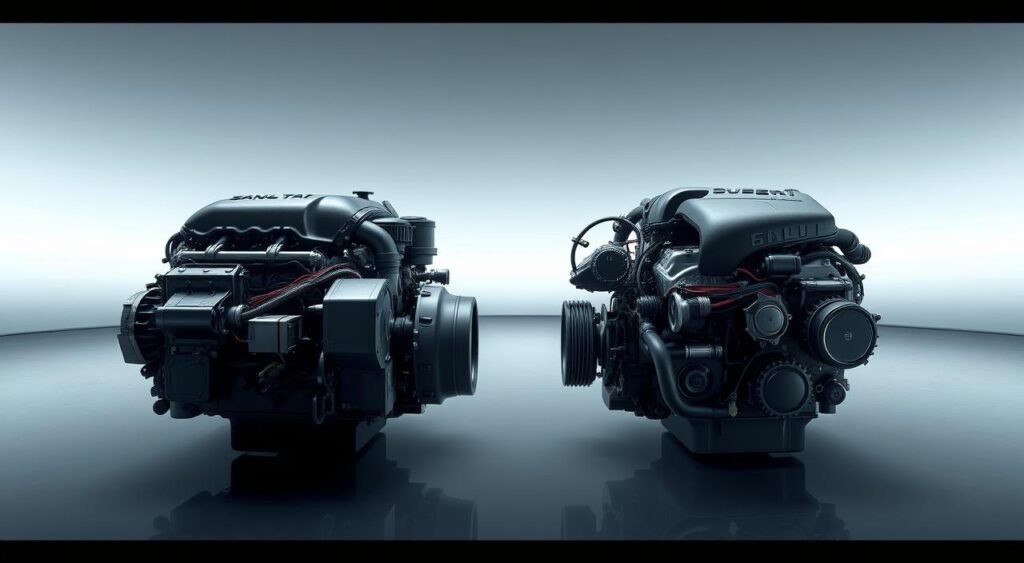
Fuel Efficiency Improvements
Tata and Mahindra’s new engines use less fuel but are just as powerful. Turbo-petrol engines are great for city driving. Diesel engines do well on long trips, saving fuel.
Driving Experience and Handling
New suspension systems make driving on Indian roads smoother. Electric power steering helps with control at any speed. Sport modes in some models give drivers a thrilling experience. These updates make daily driving fun and ready for weekend fun too.
Safety Features to Look Out For
Safety is now a key focus for car makers as they get ready to launch new Tata & Mahindra models. The latest cars coming to India will have better protection and tech to prevent accidents. This change shows how Indian car makers are stepping up their game in safety.
Advanced Driver Assistance Systems (ADAS)
The Mahindra Sierra will be the first to use Level-2 ADAS technology in India. This means top-notch safety features will be available to more people. The systems include:
- Adaptive cruise control with stop-and-go functionality
- Lane keeping assist and departure warning
- Automatic emergency braking
- Blind spot detection
- Traffic sign recognition
Crash Test Ratings and Safety Certifications
Recent crash tests show Tata & Mahindra’s dedication to safety. The Maruti Victoris got a 5-star Bharat NCAP rating, setting a new standard. Both companies have made their cars safer with better structures and safety gear.
| Model | Airbags | NCAP Rating | Key Safety Features |
|---|---|---|---|
| Tata Harrier | 6 | 4-star expected | ESP, hill hold, ISOFIX |
| Mahindra Thar | 6 | 4-star | Structural reinforcements, rollover protection |
| Tata Nexon EV | 6 | 5-star | Battery protection system, regenerative braking |
Price Expectations for New Tata and Mahindra Cars
The car market in India is excited for the new prices of Tata & Mahindra new launches. These companies are setting their prices to win over more customers. With GST changes, cars are now more affordable for people in India.
Competitive Pricing Strategies
The prices of what’s next from Tata & Mahindra show they’ve done their homework. They aim to be competitive with other big names:
| Model | Expected Price (Ex-showroom) | Key Competitors |
|---|---|---|
| Mahindra Thar Facelift | ₹12 lakh | Maruti Suzuki Jimny |
| Tata Harrier | ₹15 lakh | Kia Seltos, Hyundai Creta |
| Tata Safari | ₹15.50 lakh | Honda Elevate, Skoda Kushaq |
| Tata Sierra | ₹15 lakh | Maruti Grand Vitara |
Value for Money Analysis
The pricing for Tata & Mahindra new launches is well thought out. Prices are a bit higher than before, but it’s worth it. You get more features and tech for your money. This makes them great choices in their markets.
Regional Preferences and Market Impact
India’s vast geography leads to different car preferences in various regions. Tata and Mahindra are making cars that fit local needs. Whether in cities or rural areas, each place has its own car needs.
Demand in Urban vs. Rural Areas
In cities, people want cars that are fuel-efficient and have cool tech. They like cars that are easy to park and drive in tight spaces. Places like Mumbai and Delhi prefer cars with smart features.
In rural areas, cars need to be tough and can handle rough roads. SUVs are popular here because they are strong and can carry lots of stuff.
SUVs are big in both city and country areas. But city folks like them for the view and safety. Country folks like them for being able to carry lots of stuff and go over rough roads.
Customization Options for Different Markets
Car makers now offer many engine choices to meet regional needs. The latest cars in India include:
- Petrol mild-hybrid systems for city driving
- Strong hybrid variants for those who care about the planet
- Petrol-CNG options for work use
- Diesel engines for long trips in the country
Car options change a lot based on where you live. Basic cars are for those who don’t want to spend a lot. Fancy cars with leather and tech are for city folks. This way, both Tata and Mahindra can sell more cars in India’s varied car market.
Customer Feedback and Market Predictions
The car market in India is on the verge of a big change. People are excited for the new Tata & Mahindra cars coming soon. Research shows that customers are very positive, thanks to the companies’ smart planning and new car releases.
Anticipating Consumer Reactions
The return of the Tata Sierra has brought back memories for many. Social media and car forums are full of talk about the new Tata and Mahindra cars. People are really looking forward to these cars because they mix old charm with new tech.
- Modern safety features integrated into classic designs
- Advanced infotainment systems with smartphone connectivity
- Improved fuel efficiency without compromising performance
- Competitive pricing compared to international brands
Expert Opinions on Upcoming Models
Experts say the SUV market will keep growing until 2024 and beyond. They think Tata and Mahindra have found what people want. The new Mahindra Thar is expected to keep its fans happy and attract city dwellers too.
As these new cars hit the market, competition will get fiercer. But Tata and Mahindra are well-positioned because of their focus on value-driven engineering and localized production. Experts believe these cars will change what people expect from their vehicles.
Conclusion: What to Expect from Tata and Mahindra
The latest news from Tata Mahindra shows a big change for these Indian car makers. They are getting ready to launch cars that mix new tech with practical features for Indian roads. These new cars will have what buyers want: safe SUVs with smart tech and good prices.
Summarizing Key Features and Trends
Tata Motors is updating the Harrier and Safari with new looks and better inside designs. They are also bringing back the Sierra name, mixing old charm with new tech. Mahindra is making the Thar better and adding more XUV700 options. Both brands are adding Level-2 ADAS tech, big screens, and car connectivity.
They are focusing on safety too, with six airbags in many cars. They’re also working on making their cars safer in crashes. Prices will stay low thanks to GST benefits. Both companies know that value is as important as features in India.
The Future of Indian Automotive Landscape
SUVs will keep being the top choice for buyers. Tata and Mahindra are adding more tech to their cars at all prices. Electric cars will become more popular as charging spots grow. Safety will get better as people want more protection.
The rivalry between these Indian brands will drive innovation. This means better choices for car buyers at every price level.
FAQ
When will the Tata Harrier facelift launch and what’s the expected price?
The Tata Harrier facelift is set to launch soon. It will start at Rs 15 lakh ex-showroom. The new model will have updated styling, a fresh interior, and a new 1.5-litre turbo-petrol engine. It will also keep the 2-litre diesel engine, which makes 170PS and 350Nm.
What are the key updates coming to the 2025 Mahindra Thar facelift?
The 2025 Mahindra Thar facelift will launch in early 2026 at Rs 12 lakh ex-showroom. It will get a new grille, a revised rear bumper, and updated tail lamps. Inside, you’ll find dual 10.25-inch screens, wireless Android Auto/Apple CarPlay, and more.
When is the Tata Sierra EV expected to launch and what features will it have?
The Tata Sierra EV is coming between October 2025 and March 2026. It will mix old-school charm with modern looks. It will have connected LED lights, flush door handles, and a wide screen setup. It will also have Level-2 ADAS and wireless connectivity.
What engine options will be available in the upcoming Tata and Mahindra models?
Tata will offer a 2-litre diesel engine and a new 1.5-litre turbo-petrol engine. Mahindra will have a 2.0-litre turbo-petrol, a 2.2-litre diesel, and a 1.5-litre diesel for entry models. Both will have 6-speed manual and automatic transmissions.
How have recent GST reforms affected car prices in India?
GST reforms have made cars cheaper in India. This has made them more affordable for buyers. It has also boosted SUV demand in cities and rural areas, with manufacturers able to offer good prices and features.
What safety improvements can we expect in the new Tata and Mahindra launches?
The new models will have big safety upgrades. The Mahindra Thar facelift will get six airbags and structural updates. The Tata Sierra will have Level-2 ADAS. All models will have advanced driver assistance technologies. These show the makers’ focus on safety and meeting high crash test standards.
Which competitors will these new Tata and Mahindra SUVs face in the market?
The new SUVs will face tough competition. They will go up against the Kia Seltos, Hyundai Creta, Honda Elevate, Maruti Grand Vitara, and Skoda Kushaq. They will compete on features, safety, and price in the compact and mid-size SUV segments.
What are the latest Tata Mahindra car news and anticipated models for 2025?
There’s a lot of news on new Tata and Mahindra cars coming in 2025. Expect the Tata Harrier/Safari facelifts, the Tata Sierra’s return, and the Mahindra Thar update. These models will have the latest tech, hybrid options, and more safety features to meet what buyers want.
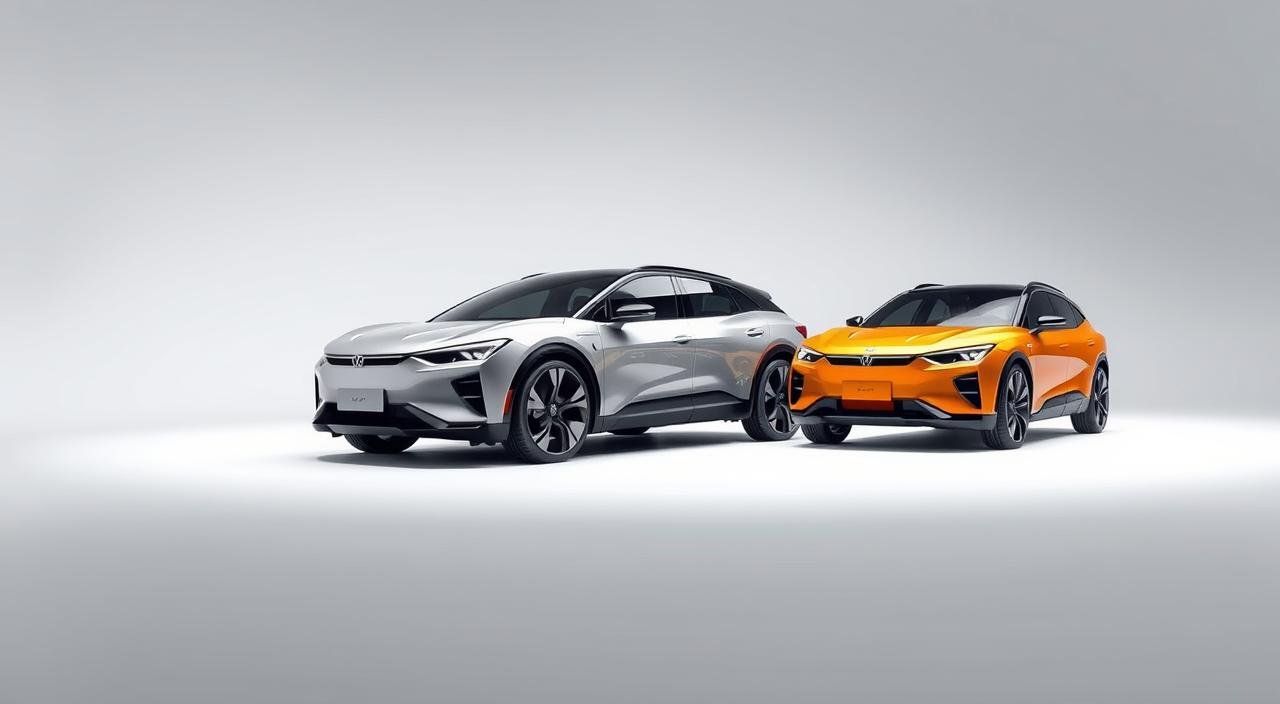
Oct
Can a Vietnamese automaker challenge the big names in India’s electric vehicle market? VinFast said yes with a big move on Saturday. They launched the VF6 and VF7 models, priced starting at ₹16.49 lakh.
The launch of VinFast VF6 & VF7 in India is a big deal for the Vietnamese company. CEO Pham Sanh Chau shared big plans. They plan to make cars in India and sell them in South Asia, Africa, and the Middle East.
VinFast started taking bookings in July for ₹21,000. They teamed up with 13 dealer groups to open 32 dealerships in 27 cities. They aim to grow to 35 dealerships by 2025.
The VF6 starts at ₹16.49 lakh and has 423 liters of boot space. It has a 468 km range. The VF7 starts at ₹20.89 lakh, with 537 liters of boot space and a 438-532 km range. It comes in five variants.
Key Takeaways
- VinFast VF6 starts at ₹16.49 lakh while VF7 begins at ₹20.89 lakh (ex-showroom)
- Indian-made vehicles will export to South Asia, Africa, and Middle East regions
- 32 dealerships established across 27 cities with expansion to 35 by 2025
- VF6 offers 468 km range with 423 liters boot space
- VF7 provides 438-532 km range with 537 liters boot space
- Both models available in multiple variants to suit different customer needs
Overview of VinFast’s Entry into the Indian Market
VinFast Auto Ltd. is entering India with the VinFast VF6 & VF7 priced from ₹16.49 lakh. This move is a big step for VinFast, known for electric vehicles in Vietnam. The company hopes to make a mark in India’s fast-growing EV market.
Background of VinFast
VinFast is led by chairman Pham Nhat Vuong, part of the Vingroup group. They have a wide range of businesses, including healthcare and education. In Vietnam, VinFast’s electric vehicles are a common sight.
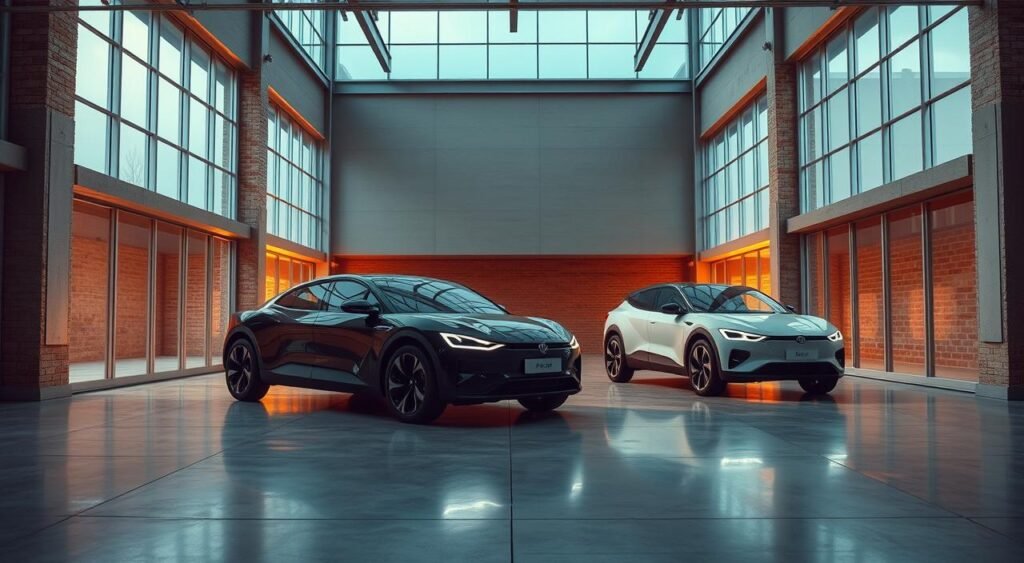
Importance of the Indian Market
India is key for VinFast’s growth plans. The country saw 18.78 million EV sales in 2024, making up 7.6% of all vehicle sales. Electric car sales jumped 93% in July. India aims for 30% electric vehicles by 2030, a big opportunity for VinFast.
Key Objectives for Launching the VF6 & VF7
VinFast is investing $500 million in a new factory in India. The plant will start with 50,000 vehicles and could reach 150,000. This base will help VinFast reach more markets, competing with big names like Tata Motors and Maruti Suzuki.
Features of the VinFast VF6
The VinFast VF6 is a fresh addition to India’s electric vehicle scene. It’s a compact SUV that blends modern looks with useful tech. This makes it a great choice for city drivers. The VinFast VF6 offers a smart mix of power and efficiency.
Design and Aesthetics
The VF6 has a young, coupe-like design that catches the eye. Its closed-off grille adds to its sleek look, common in electric cars. LED projector headlights and V-shaped LED daytime running lights create a unique front.
The side view shows short rear overhangs and a sloping roof for better aerodynamics. Black cladding protects the lower parts, while dual-tone alloy wheels add style. At the back, cuts and creases add interest, with a roof spoiler and light bar mirroring the front.
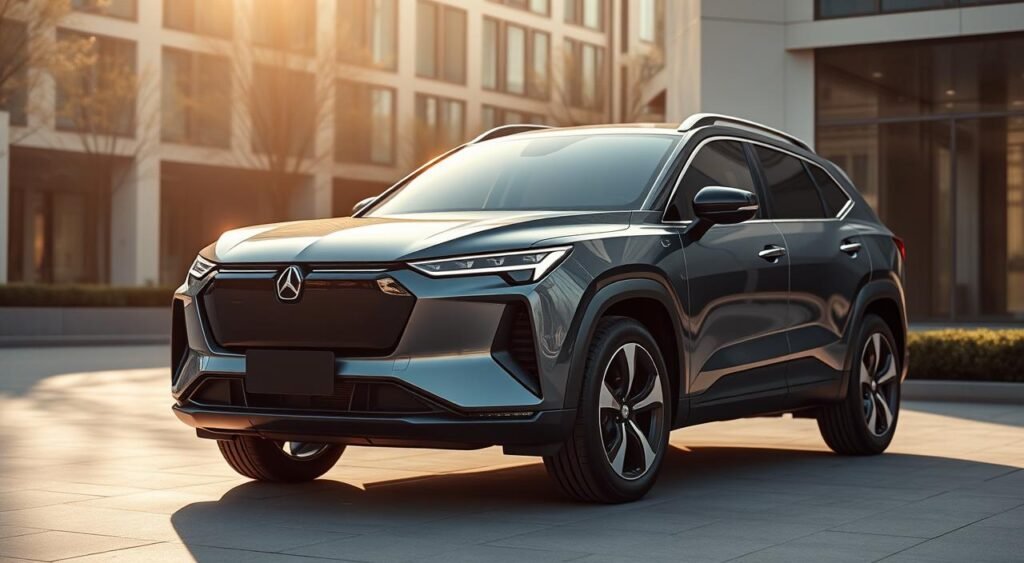
Interior Technology
The VF6’s interior is simple yet tech-rich. You can pick from black or Mocha brown themes, with soft-touch materials everywhere. The 12.9-inch touchscreen is the main attraction, running Google apps and voice commands. A flat-bottom steering wheel and button gear selector add to the modern feel.
Performance Capabilities
The VinFast VF6 & VF7 boast strong electric powertrains. The VF6 has 174 to 201.15 bhp from its 59.6 kWh battery. It goes from 0-100 kmph in 9 seconds and tops out at 175 kmph. Its 468 km range is perfect for daily drives and weekend getaways. DC fast charging fills 10-70% of the battery in just 25 minutes.
Features of the VinFast VF7
The VinFast VF7 is a top pick in India’s electric SUV market. It’s known for its bold design and strong performance. The VinFast VF7 specifications show it’s a mix of style and substance, matching the big names in the field.
Exterior Design Highlights
The VF7 looks aggressive and futuristic. Its body has sharp lines that grab attention. The front has a unique grille and V-shaped LED lights that meet the VinFast logo.
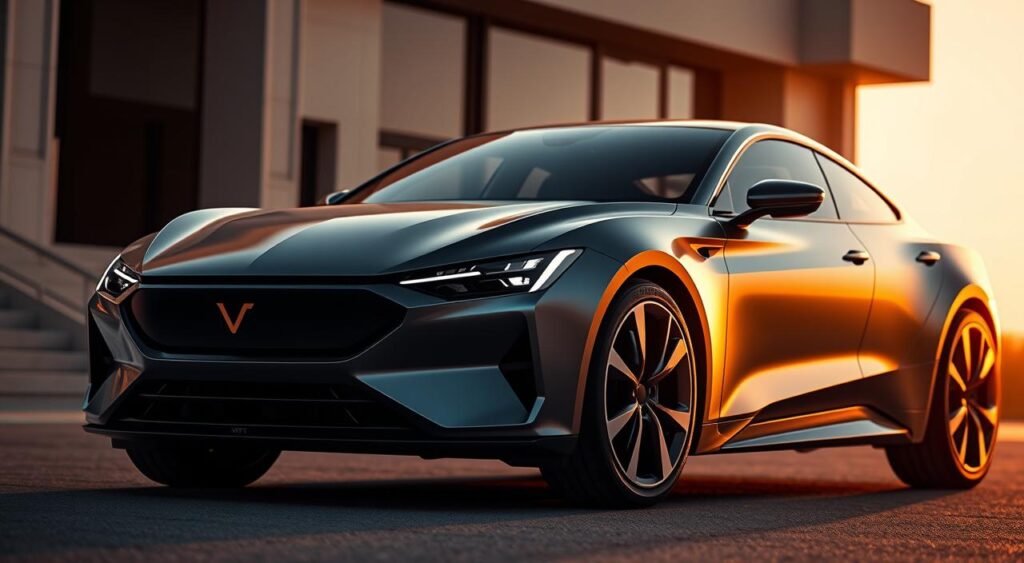
- All-LED projector headlights with mesh-pattern air intake
- 19-inch dual-tone alloy wheels
- Flush door handles for improved aerodynamics
- Connected LED taillights with sculpted rear bumper
- Shark fin antenna and ORVM-mounted turn indicators
Advanced Safety Features
The VinFast VF6 & VF7 review highlights its safety features. It has seven airbags and Level-2 ADAS. This includes Adaptive Cruise Control and Lane Centering.
A 360-degree camera system gives full view around the car. Rain-sensing wipers and an electronic parking brake make driving safer and easier.
Driving Experience
The VF7 offers thrilling performance with different powertrains. It has battery options from 59.6 kWh to 70.8 kWh. The top AWD model goes from 0-100 kmph in 5.8 seconds.
Its range is 438 to 532 km on the NEDC cycle. VinFast guarantees the battery for 10 years or 200,000 km. They also offer free charging until July 2028.
Pricing and Variants of VF6 and VF7
VinFast has set its electric SUV prices to match India’s fast-growing EV market. The VinFast VF6 & VF7 come in various options for different needs and budgets. Starting at ₹16.49 lakh, they offer premium features at competitive prices.
Pricing Breakdown for Different Variants
The VF6 lineup has three main options. The Earth starts at ₹16.49 lakh with 130 kW power and 250 Nm torque. It has a sleek black interior.
The Wind variant is priced at ₹17.79 lakh. It boosts performance to 150 kW power and 310 Nm torque. It also comes with a sophisticated Mocha Brown interior.
The Wind Infinity variant at ₹18.29 lakh adds a panoramic fixed glass roof. This enhances the luxury feel.
The VF7 series offers five variants with advanced features. The Earth model starts at ₹20.89 lakh with a 59.6 kWh battery and 130 kW power.
The Wind variant at ₹23.49 lakh has a larger 70.8 kWh battery and 150 kW power. The Wind Infinity adds a panoramic roof for ₹23.99 lakh.
The Sky variant introduces dual motor AWD with 260 kW power at ₹24.99 lakh. The flagship Sky Infinity costs ₹25.49 lakh.
Comparison with Competitors
| Model | Starting Price | Top Price |
|---|---|---|
| VinFast VF6 | ₹16.49 lakh | ₹18.29 lakh |
| VinFast VF7 | ₹20.89 lakh | ₹25.49 lakh |
| MG Windsor EV | ₹14.00 lakh | ₹18.39 lakh |
| Tata Nexon EV | ₹12.49 lakh | ₹17.49 lakh |
| Hyundai Creta Electric | ₹18.02 lakh | ₹24.55 lakh |
VinFast VF6 & VF7 booking has started across India. Their prices are competitive, making them a great choice for both budget and premium electric vehicles. The VF6 goes up against Tata Curvv EV and MG ZS EV. The VF7 challenges models like Mahindra BE 6 and XEV 9e.
VinFast’s Production and Supply Chain Strategy
VinFast aims to be a big name in India’s electric car market. It plans to build a strong production base and a wide dealership network across the country.
Manufacturing Locations
VinFast’s Tamil Nadu plant is its third worldwide, after two in Vietnam. It started making cars on Monday, with a goal of 50,000 vehicles a year. It can make up to 150,000 cars as demand increases. VinFast India manufacturing mainly focuses on the VF6 and VF7 electric SUVs.

The company has put $500 million into its India growth. It aims to serve India and export to South Asia, the Middle East, and Africa.
Sustainability Practices
VinFast is all about green manufacturing, matching India’s clean car goals. Its Tamil Nadu plant uses energy-saving methods and only makes electric cars. This helps cut down on car emissions.
Supply Chain Innovations
VinFast VF6 & VF7 availability in India relies on a big dealership network in 27 cities. The first showroom opened in Surat in late July. By 2025, VinFast plans to have 35 dealerships. Currently, it has spots in big cities like Delhi and smaller ones like Shimla and Goa.
Targeting the Indian Consumer Demographics
VinFast sees India’s electric vehicle market growing fast, with a 93% increase in sales last July. The Vietnamese car maker aims to grab a piece of this growing market. Right now, electric vehicles make up 7.6% of all car sales in India.
Understanding the Target Audience
The VinFast target audience India is mainly people who want high-tech electric cars at good prices. They look for things like advanced safety features, big glass roofs, and fancy leather seats. VinFast aims to attract those who care about the environment and want luxury in their first electric car.
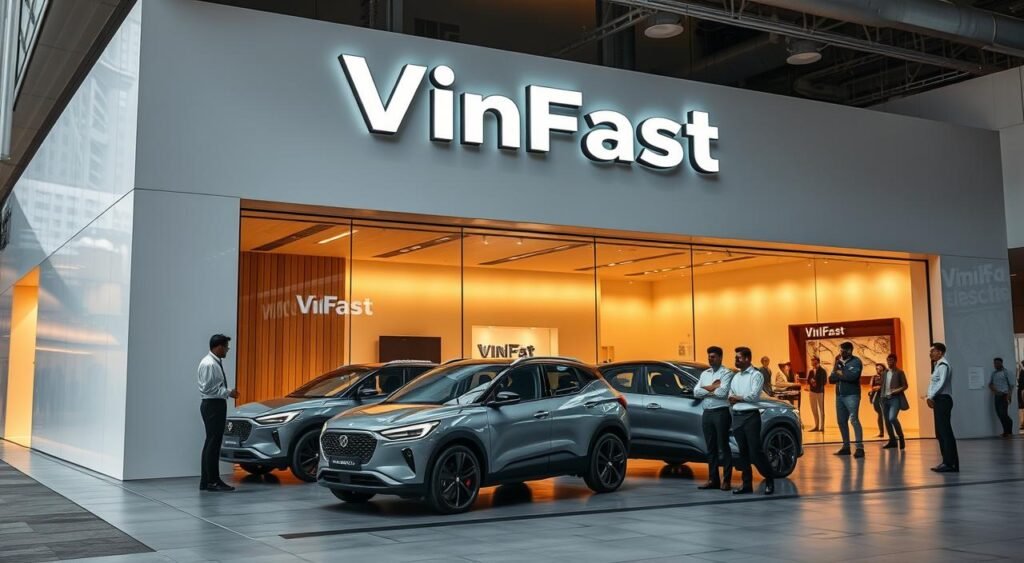
Marketing Strategies for India
The VinFast marketing strategy focuses on showing the brand’s global reach while being relevant to India. Key strategies include:
- Showing off Vietnamese heritage and success with 100 million users at home
- Starting prices that are competitive with Tata Motors
- Highlighting top-notch entertainment systems and safety features
- Supporting “Made in India” by assembling cars locally
Engagement with Local Communities
VinFast is building a strong presence in India with 13 dealer groups in big cities and EV hotspots. This move supports India’s goal of having 30% of cars be electric by 2030. The company also plans to use India as a base for exporting to South Asia, Africa, and the Middle East. This will create jobs and boost local economies.
Customer Experience and After-Sales Support
VinFast focuses on making customers happy with top-notch support. They bring advanced service to India, ensuring electric vehicle owners feel secure. Digital tools are key to a better experience for Indian buyers.
Warranty and Service Plans
The VinFast warranty India program is impressive, covering batteries for 10 years or 200,000 km. This shows VinFast’s faith in their battery tech. New owners get three years of free maintenance, cutting down costs early on.
- Free charging at VGreens stations until July 2028
- Edge-to-edge panoramic sunroof with complimentary curtain (select variants)
- Fast charging capabilities – VF6 reaches 70% in 25 minutes
- Auto LED projector headlamps and acoustic windshield as standard
Customer Feedback Mechanisms
The VinFast after-sales service will grow to 35 spots by 2025. The C-App connects customers and service centers instantly. It also makes linking phones easy with Android Auto and Apple CarPlay.
Updates can be sent over the air, keeping cars up-to-date without visits. This lets VinFast enhance features based on what customers say. The system also checks car health and plans maintenance on its own.
VinFast’s Future Plans in India
VinFast is setting big goals for India, building on the success of the VF6 and VF7. They aim to make a big impact in one of the biggest car markets. Their plans show they believe in India’s growing electric car scene.
Upcoming Models and Innovations
The VF3, a compact model, is coming by late 2025. It’s for city folks who want an affordable electric car. VinFast also plans to keep improving cars with software updates, so you don’t have to go to the service center.
They’ll keep making driver assistance systems better and improve battery tech. This means longer drives and quicker charging. VinFast is working hard to make cars that fit India’s roads and what people want.
Expansion Strategies
VinFast wants to grow in many ways in India. They plan to add more dealerships, from 32 to 35, in 27 cities by 2025. This will make it easier for people all over to buy their cars.
| Expansion Area | Current Status | 2025 Target |
|---|---|---|
| Dealership Locations | 32 | 35 |
| City Coverage | 25 | 27 |
| Annual Production Capacity | 50,000 units | 150,000 units |
| Investment Commitment | Initial phase | $500 million |
The Tamil Nadu factory is a key spot for VinFast. It makes cars for South Asia, the Middle East, and Africa. This Made in India focus helps the country become a big player in electric cars.
Conclusion: VinFast’s Impact on the Indian EV Market
VinFast’s entry into India marks a significant shift in the electric vehicle market. With the VF6 and VF7 models, priced at ₹16.49 lakh and ₹20.89 lakh, they challenge the status quo. This move puts pressure on Tata Motors and Maruti Suzuki, while also competing with newcomers like BYD and SAIC.
India aims to reach 30% EV market share by 2030, a goal that VinFast’s arrival supports. Currently, EVs make up 7.6% of the market.
Summary of Key Takeaways
The VinFast India launch brings several innovations. The VF6 and VF7 come with a 10-year battery warranty and free charging until 2028. This addresses key concerns for EV buyers in India.
These vehicles offer ranges of 468-532 kilometers and fast charging. They also feature Level-2 ADAS technology. VinFast’s focus on local manufacturing makes India a key player in the global market.
Final Thoughts on VinFast’s Launch
VinFast’s arrival is expected to boost electric vehicle adoption in India. By combining premium features with competitive prices, they push others to innovate. Their growing dealer network and after-sales support show a long-term commitment to Indian customers.
As the EV market evolves, VinFast’s entry highlights India’s importance for global automakers. It shows India is a key battleground for growth in sustainable mobility.
FAQ
What are the starting prices for VinFast VF6 and VF7 in India?
The VinFast VF6 starts at ₹16.49 lakh (ex-showroom) for the base Earth variant. The VF7 begins at ₹20.89 lakh (ex-showroom) for its Earth variant. These prices were announced during the India launch.
What is the driving range of VinFast VF6 and VF7?
The VinFast VF6 has a NEDC range of 468 km on a single charge. The VF7 offers between 438-532 km of range, depending on the variant and battery.
Where is VinFast manufacturing these vehicles for the Indian market?
VinFast has set up a factory in Tamil Nadu, India. It has an initial capacity of 50,000 vehicles a year, which can grow to 150,000. The factory will make vehicles for both the Indian market and exports.
What warranty does VinFast offer on the battery?
VinFast offers a 10-year or 200,000 km battery warranty. This is one of the longest warranties in the Indian EV market.
How long does it take to charge the VinFast VF6 and VF7?
The VF6 can charge from 10% to 70% in 25 minutes with DC fast charging. The VF7 does the same in 24 minutes. VinFast also offers free charging at VGreens stations until July 2028.
What are the key safety features in these models?
Both models have 7 airbags and Level-2 ADAS. This includes Adaptive Cruise Control, Lane Centering, and Lane Change Assist. They also have high-resolution 360-degree cameras and rain-sensing wipers.
How many variants are available for each model?
The VF6 comes in three variants: Earth, Wind, and Wind Infinity. The VF7 has five variants: Earth, Wind, Wind Infinity, Sky, and Sky Infinity. The Sky variants have dual motor AWD.
What is the booking amount and where can I book these vehicles?
VinFast started bookings in July 2024 with a ₹21,000 token. They have 32 dealerships across 27 cities in India. They plan to add more by the end of 2025.
How does VinFast VF6 and VF7 compare to competitors in terms of pricing?
The VF6 competes with the MG Windsor EV and Tata Nexon EV. The VF7 rivals include the Hyundai Creta Electric and Mahindra BE 6. VinFast is competitively priced in the premium EV segment.
What are the standout interior features of these vehicles?
Both models have a 12.9-inch touchscreen with Google apps. They also have wireless Android Auto and Apple CarPlay. The interiors are vegan leather with ventilated seats and dual-zone climate control.
What is VinFast’s future roadmap for the Indian market?
VinFast plans to introduce the VF3 model by the end of 2025. They aim to expand their dealership network to 35 locations. They have invested 0 million in India and plan to make it a hub for exports.
